BULK TERMINALS international
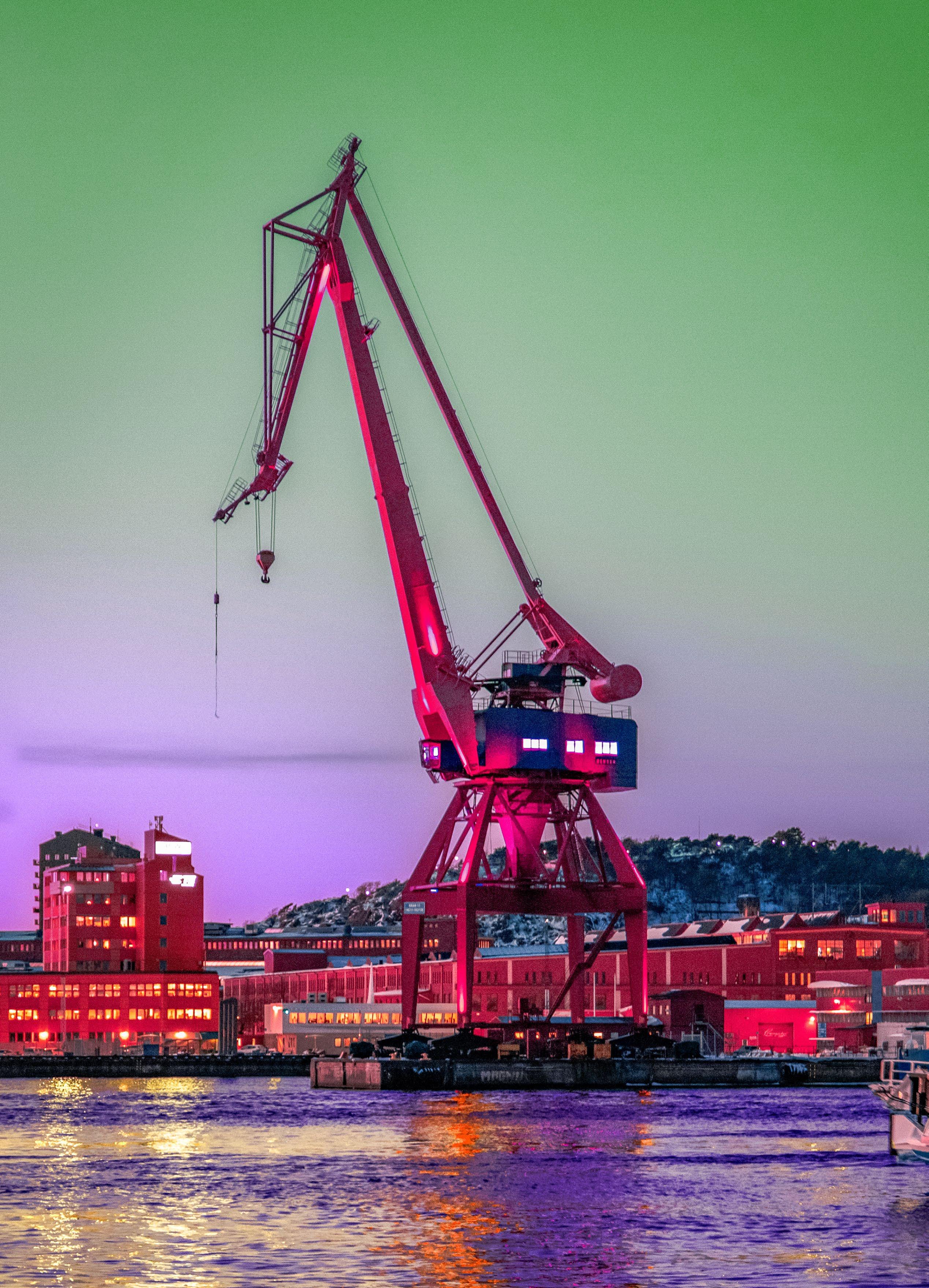
heavy metal
How the latest state-of-the-art cranes are transforming port operations
automatic answers
Innovative solutions to the challenges terminals face
north star
We talk to the head of Humber Ports
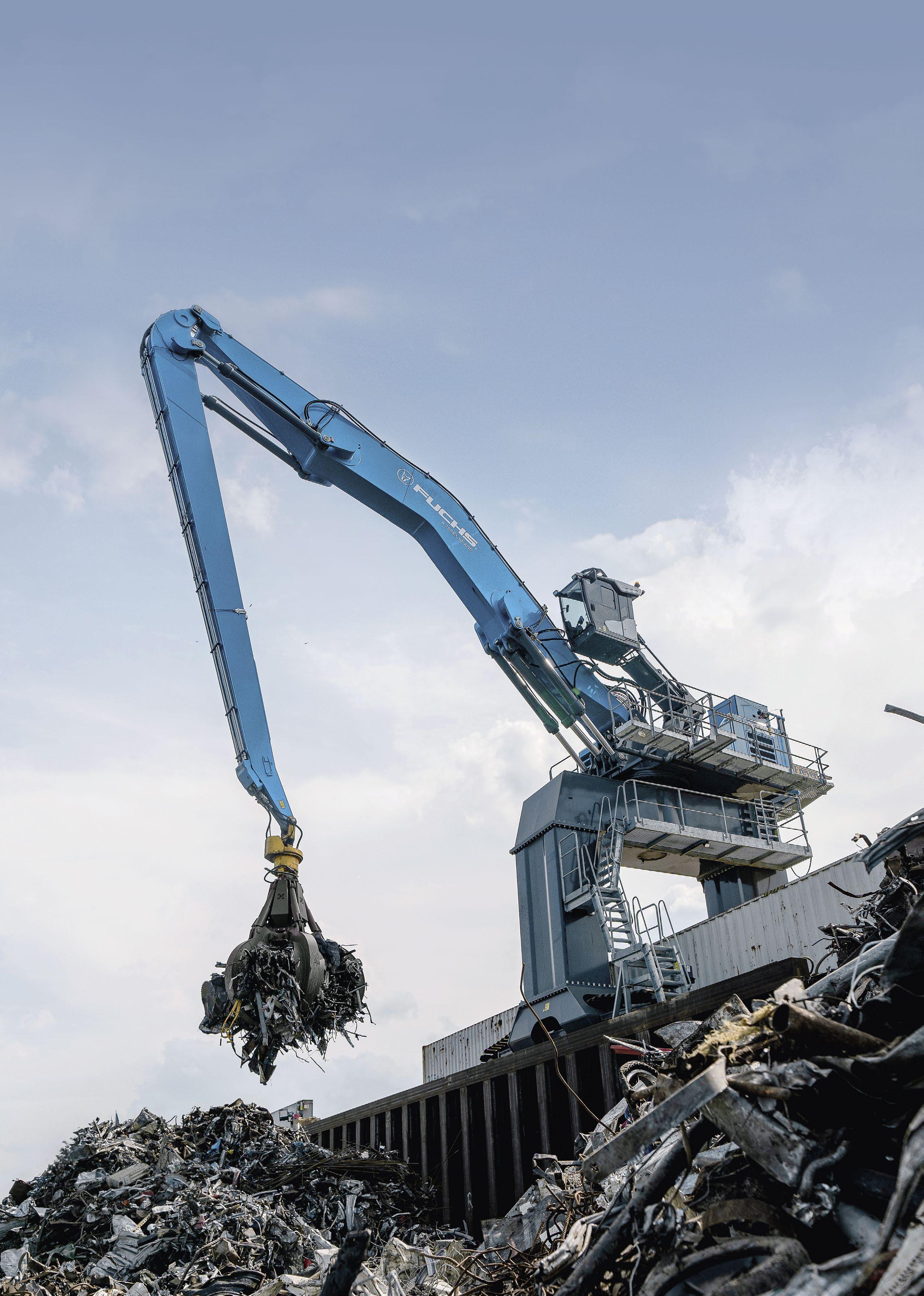


How the latest state-of-the-art cranes are transforming port operations
Innovative solutions to the challenges terminals face
We talk to the head of Humber Ports

BY SAMANTHA ROBINSON
Find out what’s coming up in this summer edition of Bulk Terminals International

Welcome to the latest edition of Bulk Terminals International, packed with all the latest news, views, innovations and initiatives from across the maritime industry.
Global markets have been experiencing turbulent times in recent months, with geopolitical tensions piling on the pressure. The will-he/won’t he of US President Donald Trump’s tariffs continues to add to the turmoil, something we look at in our Special Report on the global iron ore market (p33).
Meanwhile, changing weather patterns continue to have farreaching effects on global trade in commodities such as crops. We examine the EU’s wheat production (p28) and how some areas are rebounding while others are still struggling.
But it’s not all doom and gloom. As we find out in our Spotlight series (from p41), ports around the world are enjoying a boost from renewed investment in both equipment and facilities – although tariffs are having a knock-on effect on US
ports, in particular. We also look at the innovations that are streamlining operations, from state-of-the-art cranes and grabs (p16) to advanced AI tools to enhance ship design (p36). Someone who knows only too well the importance of smooth operations is Andrew Dawes, Regional Director of Associated British Ports’ Humber port. He talks to us about the pressures of leading the biggest port in the UK, navigating a complex landscape of challenges and the exciting changes ahead and plans for the future (p38).
But first, turn to page 6 for our welcome from ABTO CEO Simon Gutteridge, where you can read more on the effect of Trump’s ubiquitous tariffs on the wider industry. You can also find out all about our notto-be missed Bulk Terminals 2025 conference, which takes place this year in Marseille, 29-30 October –an ever-popular event among industry professionals and maritime experts alike.
I do hope you enjoy reading this issue.

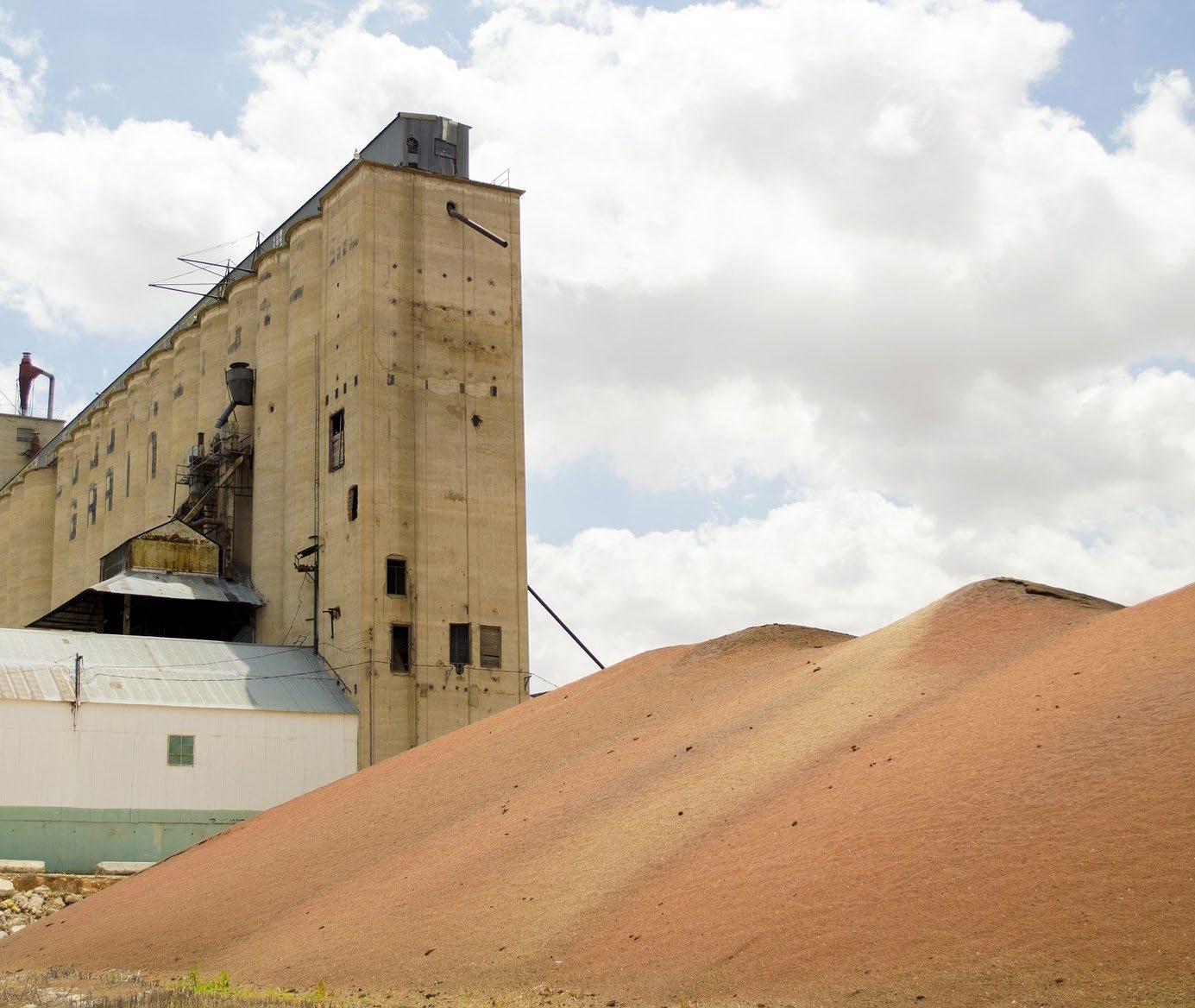
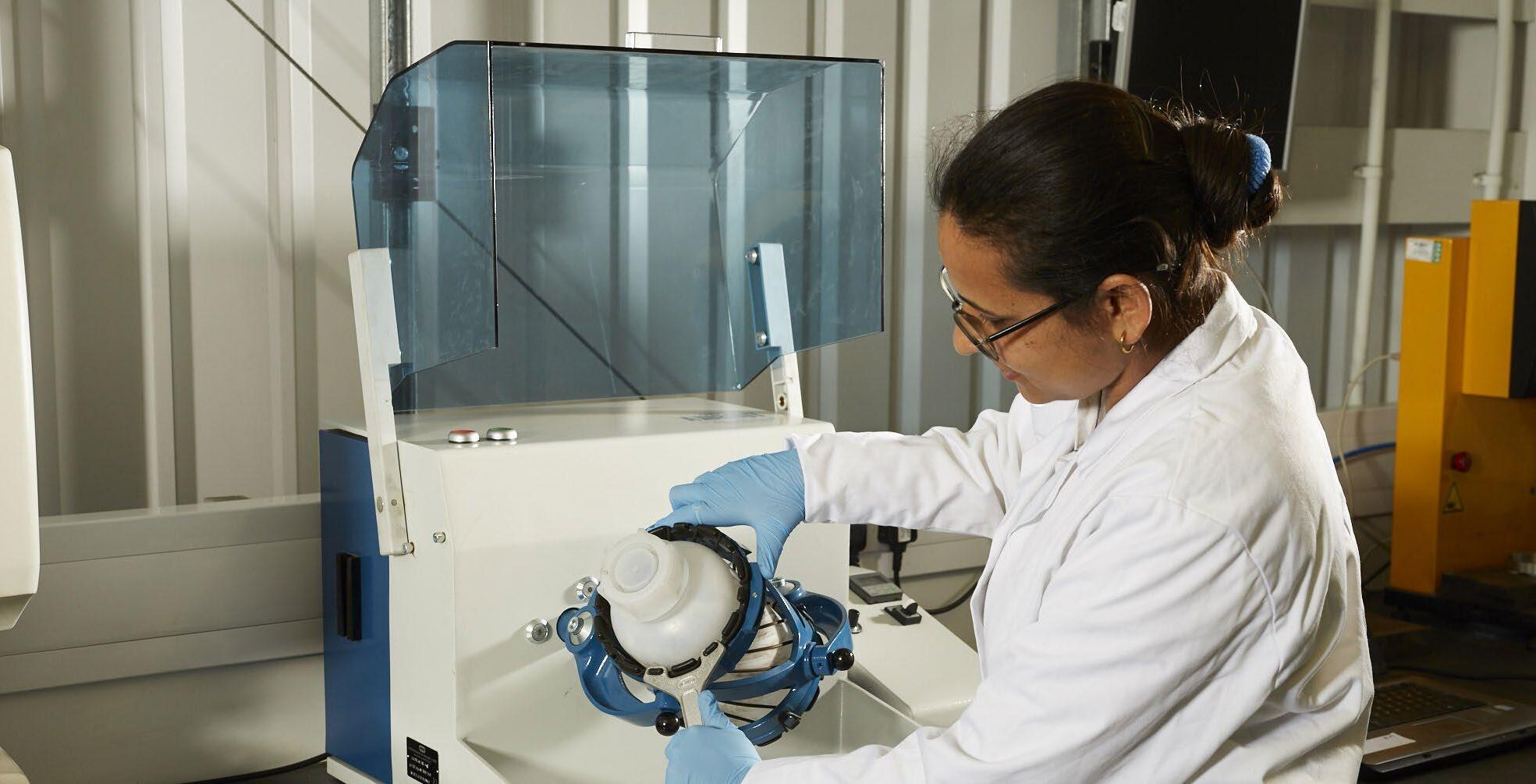
EXPERTS offERing ConSUlTAnCy ADviCE AnD ShoRT CoURSES foR EnginEERS hAnDling PoWDER AnD BUlk MATERiAlS onlinE CoURSES now available
ConsultanCy serviCes
Some of our Consultancy services include advising on:
» Storage and Discharge of bulk materials
» Pneumatic Conveying of bulk solids
» Sp oiling of materials in storage and in transit
short Courses for industry
» Plant and Equipment design/redesign
» Ship Unloading/ quayside operations
» Control of plant wear
» Dust control
» Bulk Materials characterisation
» ATEX/DSEAR complianc e
» Expert Witness s ervices
We also provide a range of short courses to help delegates identify potential bulk materials handling problems and advise on how to avoid and/or overcome these issues. They fall under 4 main categories
Pneumatic Conveying:
» Pneumatic Conveying of Bulk Materials
» Pneumatic Conveying System Design
» Rotary valves; Design, Selection and op erational issues
» Commissioning and Troubleshooting ‘hand’s on’ Pneumatic Conveying Systems
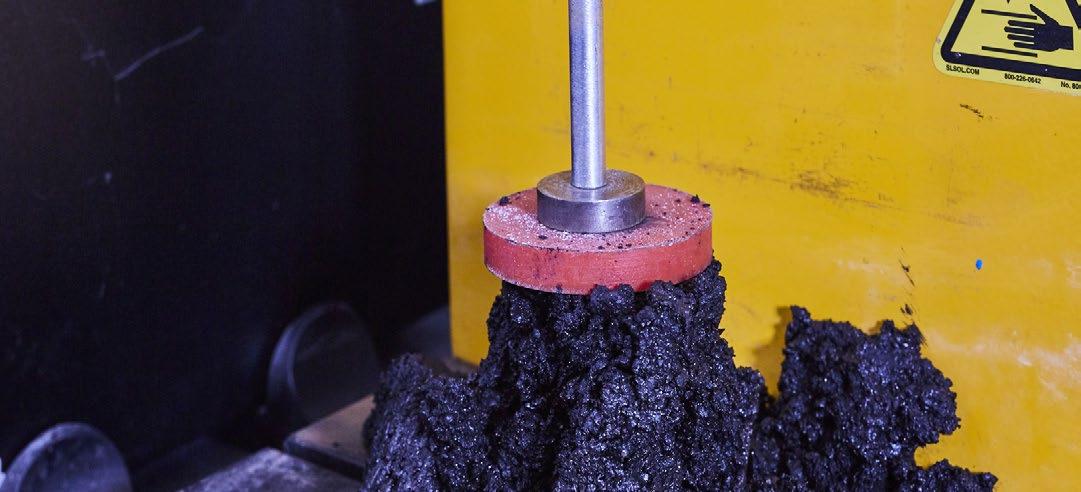
General bulk materials handling:
» overview of Particulate handling Technology
» Port and Terminal operations for Bulk Cargoes
» Measurement of the Properties and Bulk Behaviour of Particulate Materials
» Dust Control in Processes
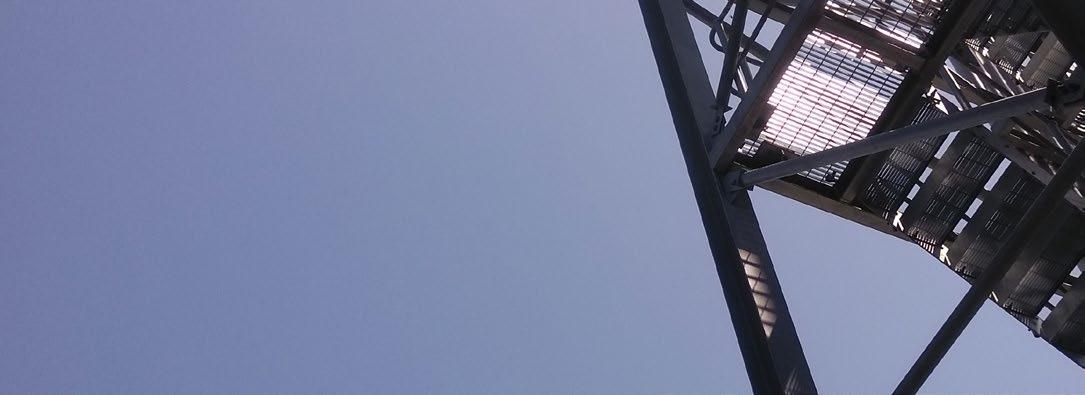
storage of bulk Materials:
» Storage and Discharge of Powders and Bulk Solids
» Design of Equipment for Storing and handling Bulk Materials
» Biomass handling, fee ding and Storage (can be adapted to other materials such as waste, recycled goods, pellets)
specialist areas of concern:
» Caking and lump formation in Powders and Bulk Solids
» Undesired De-blending and Separation in Processes and Equipment
» Electrostatics in Powder handling
» numerical Modelling of Solids handling and Processing
» Powder handling and flow for Additive Manufacturing
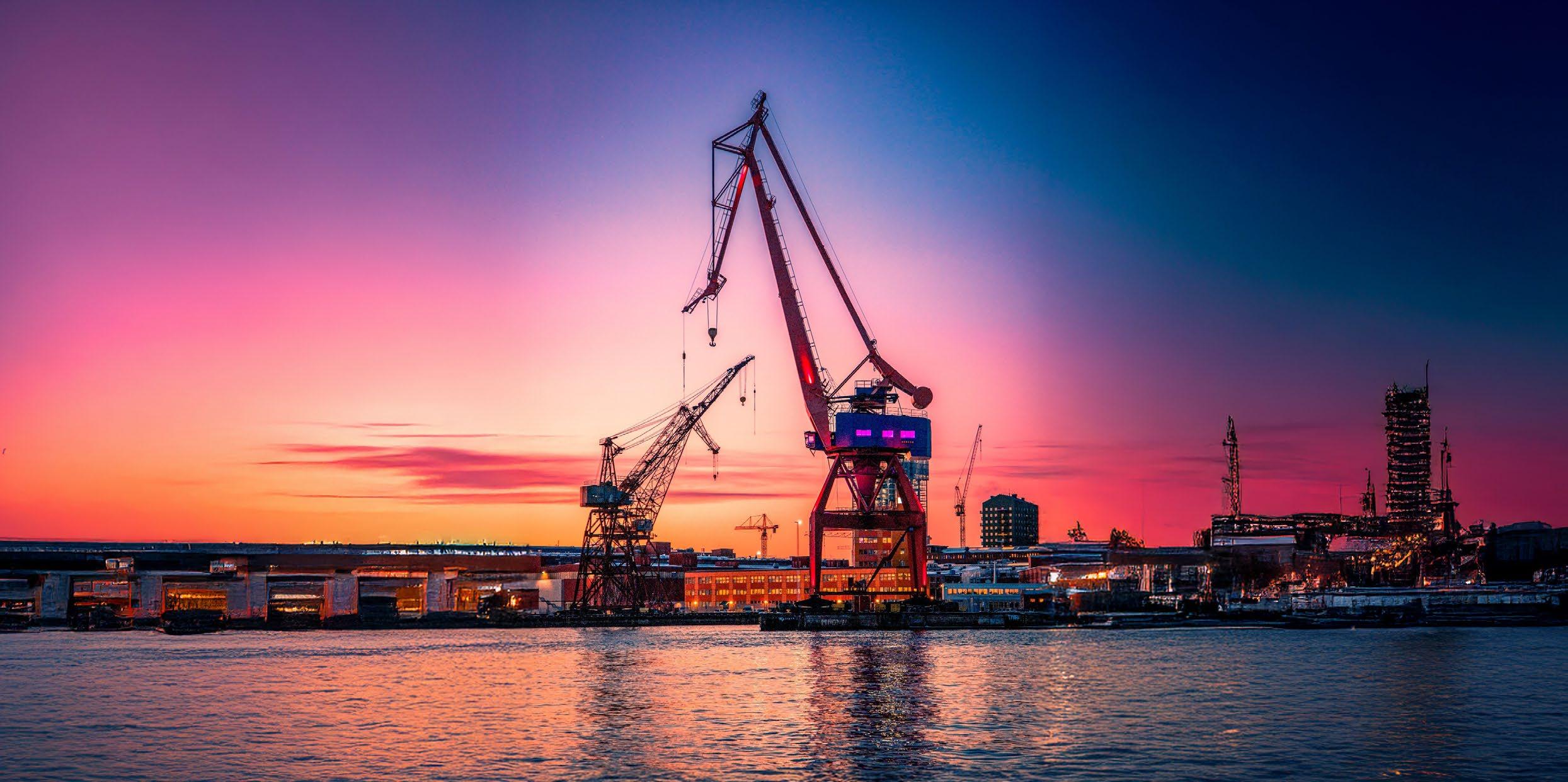
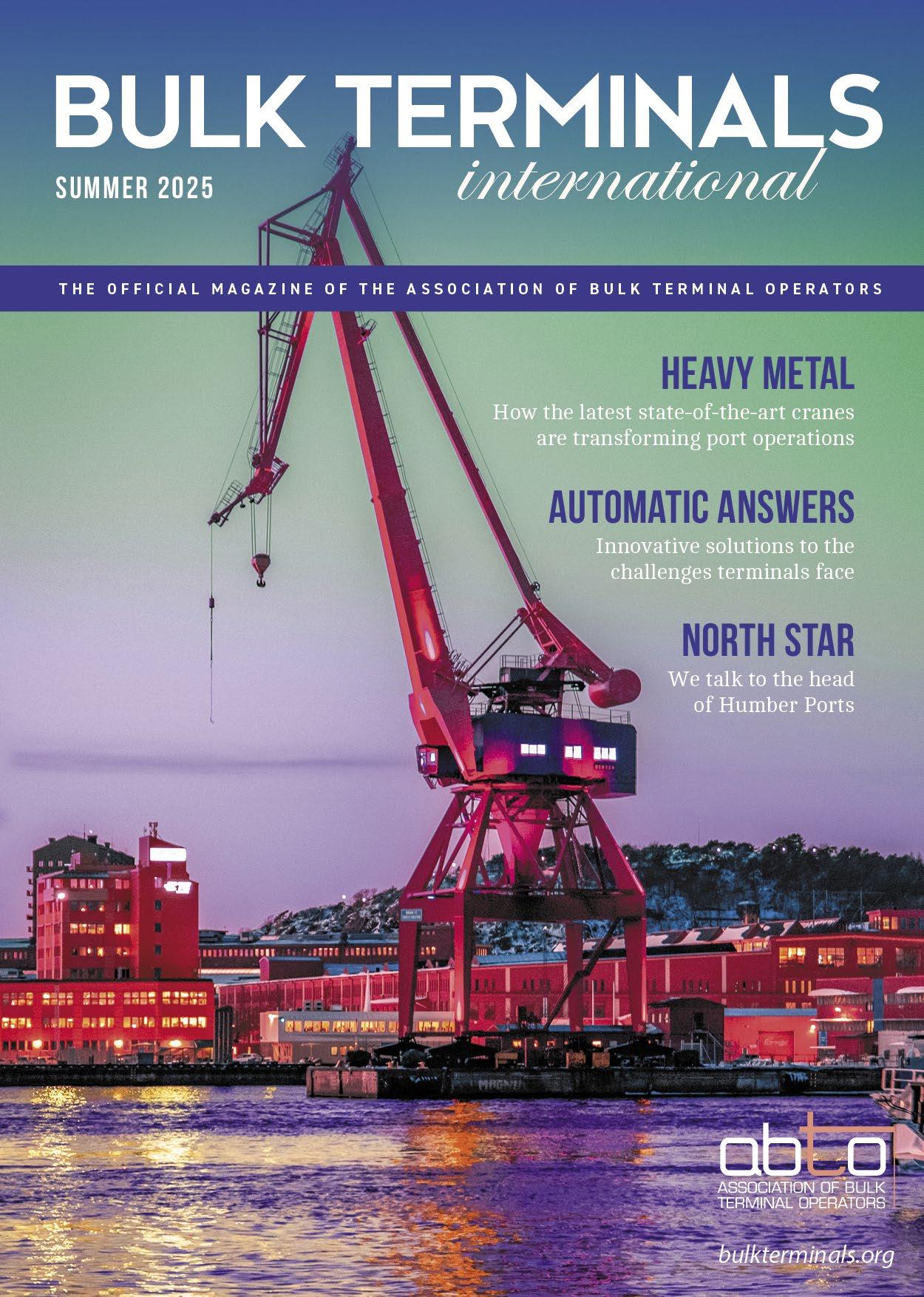
Published by
editor: Samantha Robinson Sam.robinson.journalist@gmail.com
Designer: Justin Ives justindesign@live.co.uk
PROJECT DIRECTOR: Jonathon Ferris jonathon.ferris@bulkterminals.org
PROJECT MANAGER: Alex Corboude alex.corboude@bulkterminals.org
Publisher: Bill Robinson production@bulkterminals.org
ABTO 35 Beacon Drive
Newton Abbot
Devon
TQ12 1GG
Chief Executive: Simon Gutteridge ce@bulkterminals.org
Technical Adviser: Ian Adams tech@bulkterminals.org
The views expressed in Bulk Terminals International are not necessarily those of ABTO or the publisher unless expressly stated to be such. ABTO disclaims any responsibility for errors or omissions or their consequences or for advertisements contained in this magazine and has no legal responsibility to deal with them.

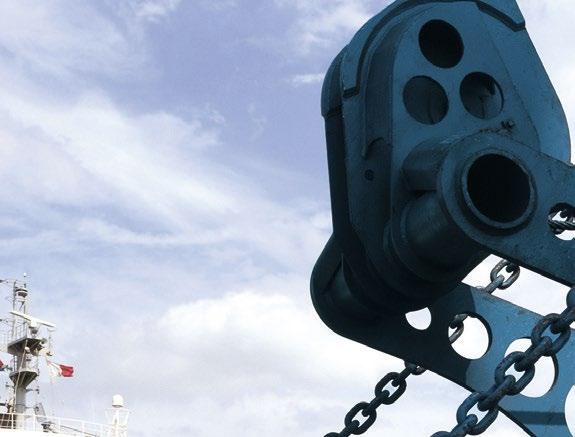
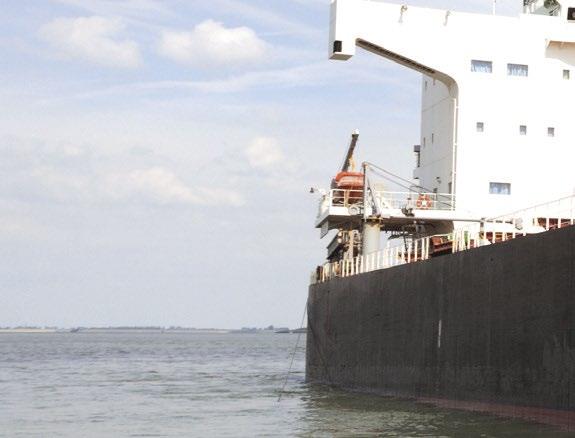
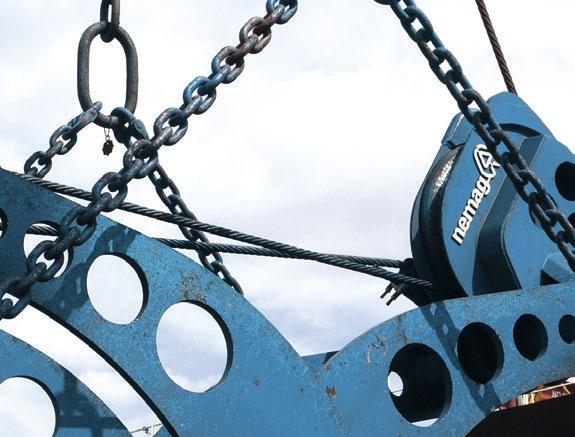
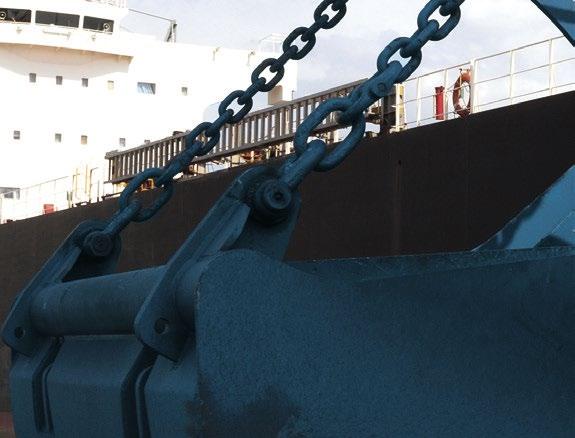

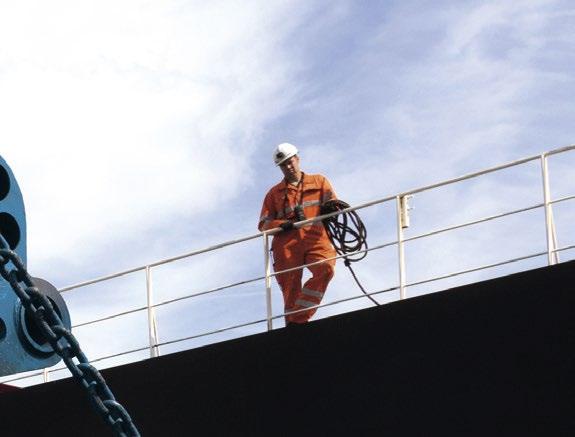
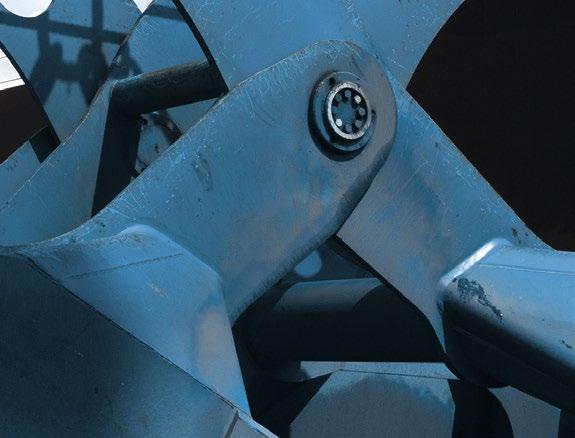
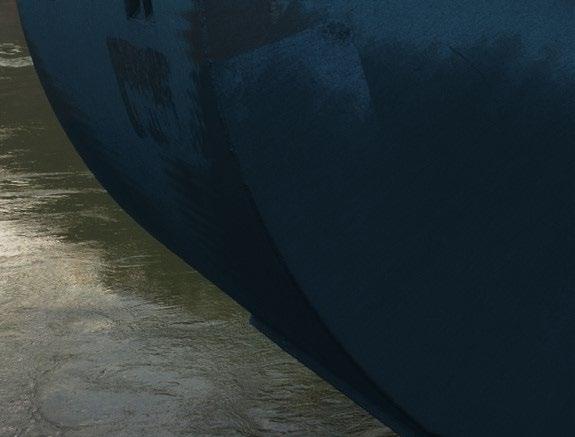

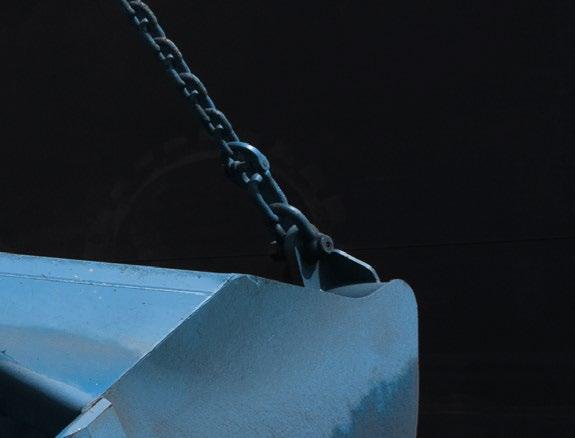
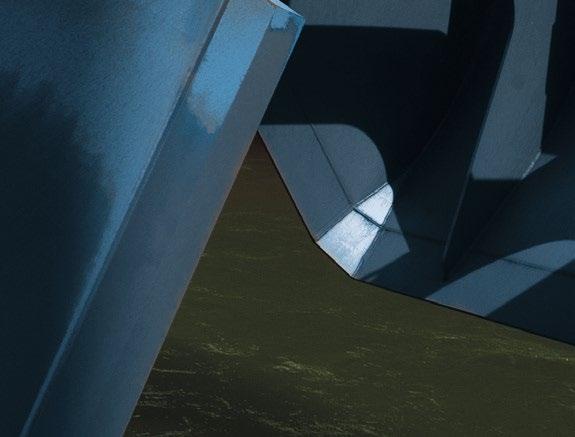




Reduced handling costs, shorter turnaround times, reliability and flexibility: Nemag grabs give dry bulk terminals throughout the world that competitive edge they need in today’s demanding market.
Driven to achieve the best performance, we closely listen to our clients’ needs. For almost a hundred years, Nemag’s innovative grabs make it possible to realize the highest productivity at the lowest costs.
Explore our comprehensive range of high-quality grabs and discover the power of great bulk handling.
From coal and iron ore to wheat, scrap metals, minerals and clinker: Nemag has the optimal solution for every dry bulk flow!
Contact us find out how we can take your bulk handling to the next level.
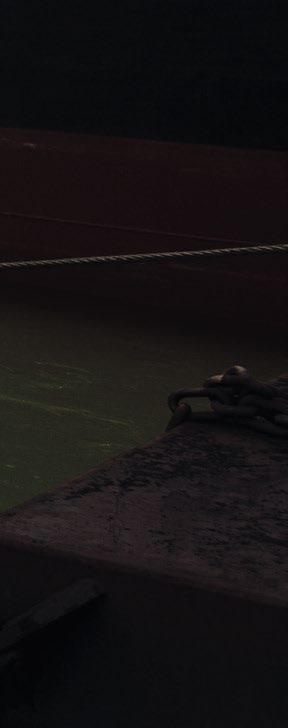




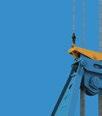
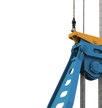

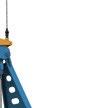

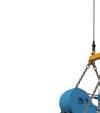

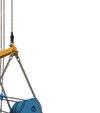
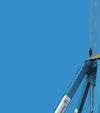
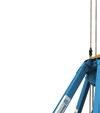
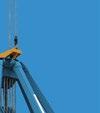
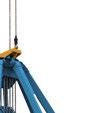



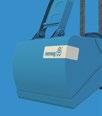


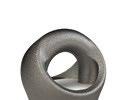
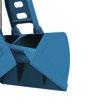
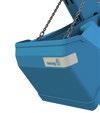
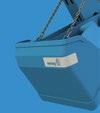
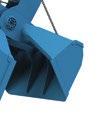
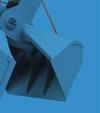
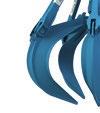


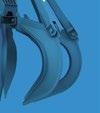
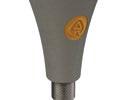





» p06
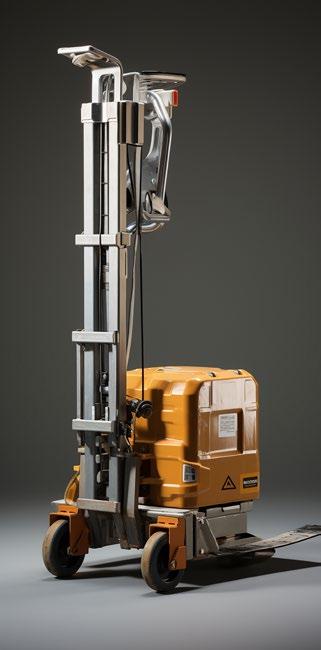
» p35

» p33

» p38
Find out what’s coming up in this summer edition of Bulk Terminals International
06 welcome
ABTO CEO Simon Gutteridge looks at the aftermath of US President Trump’s tariffs
All the latest industry initiatives, products and partnerships from across the globe
Next-generation cranes are transforming port operations by enhancing operational efficiency while reducing emissions
23
From state-of-the-art equipment to streamlined rail links, ports are employing myriad ways to load and unload ships swiftly and efficiently
The EU’s uneven wheat production is forecast to rebound over the coming year, plus Ukraine’s grain boost and US storage enhancements
33
What is the global outlook this year for iron ore? This special report delves into the geopolitics and market forces affecting trade.
Ports are rising to the challenge of maintaining efficiency in often difficult circumstances with a host of innovative solutions
The Regional Director of Associated British Ports’ Humber Ports discusses current priorities and future plans at the UK’s largest port.
41
Proposed revisions to the National Policy Statement for Ports aim to streamline planning processes for ports in England
44 spotlight: india
Multiple investment projects are taking place at India’s ports, which have seen a huge boost to traffic
48 spotlight: scandinavia
Scandinavian ports are investing in equipment and facilities to future proof their businesses
51 spotlight: south africa
South Africa’s ports are seeing a healthy boost to throughput by increasing capacity and improving operational readiness
53 spotlight:
US West Coast ports saw a slowdown in May, with some of the largest experiencing their first year-overyear decrease in months
BY
Four months on from President Trump’s ‘Liberation Day’ address, what has been the global effect of his sweeping tariffs?

The Spring edition of Bulk Terminals International was written in the immediate aftermath of the tariffs US President Trump’s imposed, subsequent to his 2 April ‘Liberation Day’ address. I attempted then to predict the consequences of the chaos he caused to the international trade order through the impact of his swingeing tariff impositions, together with the impact it would have on bulk terminals.
Nearly four months on, what has been the fallout? To recap, on 2 April, Trump unveiled sweeping reciprocal tariffs –basically a blanket 10% across all imports plus additional 10–50% hikes targeting China, the EU, UK, Japan and Southeast Asia. China retaliated on 4 April, slapping a 34% tariff on all US dry bulk-related commodities – such as grain, coal and petcoke. This resulted in a steep decline in US grain and coal exports to China.
Traders and shippers recalibrated quickly: China pivoted to Brazilian, Australian and Ukrainian coal and grains, while the US diversified to Europe, Latin American and Middle East markets.
Come the May/June period, BIMCO was forecasting that global iron ore and coal volumes (and hence demand) would now stagnate through to 2026. Chinese grain and energy import needs would remain, but with individual routes changing and consequently impacting terminal throughput either positively or negatively.
Diversification and substitution was the order of the day. US exporters ramped up shipments to other markets, mitigating the loss of the Chinese market. Iron ore and coal remain critical to Chinese steel demand and power generation. So, China continued to ramp up purchases from Brazil, Russia, Mongolia and Australia. Even with some domestic mining boosts, import volumes will not collapse. Brazilian soy and Ukrainian grain flows into Asia increased.
Looking forward to the continuing risks to trade, tariff fluidity remains a lingering uncertainty. The US Chamber of Commerce warns tariffs will persist for months while EU deal caveats suggest 2 April tariff levels will not be retracted soon. Similarly, a Congressional report indicates potential temporary tariff reductions for 90 days, but defaults returning to 2 April levels unless comprehensive deals emerge. Further retaliatory rounds with Canada, the EU or ASEAN could trigger new tariff cycles.
It should be mentioned that macroeconomic factors as well as tariff regimes will also have a part to play, since global slowdown pressures commodity demand. The International Monetary Fund suggests China’s growth at 4% is a slowdown tied partly due to tariff drag, but also due to broader property and debt issues.
In conclusion, dry bulk demand suffered a downturn in April but in the meantime, markets are settling and trades have rerouted, cushioning core demand areas. They remain fragile with mineral and ore set to continue growing modestly. Grains and coal will vary by geography with Chinese substitution partially offsetting lost US flows. Forward indicators suggest the worst is behind, but not by much.
Tariff persistence, macro slowdown, and political risk remain real threats to stability. But the recovery is tentative dependent on how long tariffs remain in place, whether the trade war escalates or calms, together with underlying demand trends in China and India, as well as with global growth generally.
Even if Trump were to scrap tariffs today, he has shattered confidence in American economic policymaking, which has an impact on everyone
The predictions, like the description above of how things have played out so far, are based on my interpretation of the views of various analysts. They make for the most part entirely predictable and logic assumptions, since even in response to a pandemic or adverse weather conditions the supply chains that allow economies to function can adjust with sometimes surprising rapidity to shocks.
The predictions probably do not fully factor in the Trump effect. The behaviour of the occupant in the Oval Office of the White House is entirely unpredictable, and hardly based on what might even be considered rationally to be in the best interest of the US. Even if Trump were
to scrap tariffs today, he has shattered confidence in American economic policymaking, which has an impact on everyone. Traders and decision-makers everywhere will be wary of a capricious new round of tariffs that will affect not just their decisions relating to trading with the US, but with any deals which could be impacted by them.
This is long-term damage that has been done.
By the time of the annual ABTO Bulk Terminals conference on 29 and 30 October, we will see how accurate or otherwise predictions have been.
We are delighted to be going to the Port of Marseille Fos this year. As the leading port in France, generating 43,500 jobs in the Bouches-du-Rhône department, Marseille Fos is a global port with an infrastructure able to handle all types of traffic: hydrocarbons, liquid bulk, general cargo, passengers – and of course dry bulk.
Thanks to its location, which makes it ideal for north-south and east-west trade – plus its excellent road, rail, river and pipeline connectivity – it is the gateway to Europe at the southern end of the French logistics corridor of Lille/Paris/ Lyon/Marseille.
The Port of Marseille Fos is made up of two harbours, each with very distinct features. The eastern harbour located in Marseille is a local port for goods and passengers. The western harbour is located in the industrial port area of Fossur-Mer, accessible to the largest ships and dedicated to major intercontinental flows. The western harbour is where bulk terminal activity is located.
The solid bulk sector in Marseille Fos handles both the import and export of agri-food products such as cereals, as well as industrial bulk such as fertilisers, construction materials, clinker, iron or bauxite ores, alumina, peat, and so on.
Bulk Terminals Marseille conference will feature a packed programme of presentations, panels and case studies for delegates and experts from across the industry to share ideas and information. The theme of Marseille
will be ‘Responding to the New Age of Chaos’. As we have seen, the fluid situation surrounding the imposition of the tariffs imposed by President Trump will have a serious impact on bulk trade flows at whatever level they settle at – both in terms of total volumes and trade routes. In addition to the obvious economic repercussions, bulk terminals will be presented with operational challenges and the need to make strategic adaptations.
Our regular coverage of bulk markets – improving, or at least maintaining, profitability; streamlining operations; improving safety; online security; and ensuring environmental compliance and protection – will be examined against the backdrop the volatile situation surrounding the imposition of Trump’s tariffs and the impact that these have on bulk terminal operations. The conference will examine the impact these latest challenges place on bulk terminal operations – both in the short and long term.
Additionally, geopolitical tensions have added a further uncertainty to predictions. We are delighted that Louis Borer, a Senior Analyst at Risk Intelligence – a world leader in risk assessment, risk management and planning – will join us to discuss ‘Geopolitical tensions impacting the global bulk trade’. Louis is particularly well qualified to address this issue. He has previously worked for the French Ministry of the Armed Forces in the field of geospatial intelligence and maritime arms trafficking, then as a senior analyst in maritime counterterrorism. Louis has also worked on maritime security issues for various think tanks. He is a reserve Captain in the French Navy, where he has worked for military and naval intelligence, and special forces. This keynote presentation is not to be missed!
This year we a grateful to have the support of our conference partners DsG Consultants. Created in July 2011 in Southern France by two senior consultants, Sylvie Doutres and Sophie Robert, DsG Consultants is an independent consulting firm. It has more than 25 years of expertise in port
and maritime advisory and a strong specialisation on dry bulk commodities logistics and maritime supply chain solutions. DsG has operated within EU, Africa, East Mediterranean and Black Sea countries offering skills in logistics, marketing, public relations, intelligence and statistics analysis, combined with an extensive contact network in all EuroMed port and logistics communities.
For the first time, the markets session will include an ‘Overview of cementitious trade’, which Sylvie Doutres will present. In the operations session, she will also discuss ‘Challenges making the transition to new bulk traffics’. In view of the need that many terminals will have to be more adaptable on account of the decarbonisation agenda, driven by the switch from coal to more sustainable biomass as well as the change in bulk commodity trade routes, this is sure to be eagerly awaited.
Dovetailing neatly with Sylvie’s presentation, Professor Mike Bradley, Director of The Wolfson Centre and our conference Chairman, has previously spoken about how to make the assessment of the correct balance to be made between maximum operational efficiency versus flexibility for terminal equipment – particularly loading and unloading equipment. In view if the increased volatility in international bulk commodity flows caused by tariff regimes and geopolitical uncertainties, Mike will be revising this debate.
The effects of climate change on terminal operations cannot be ignored. What will be the impact on port and terminal infrastructure of rising sea levels? This has been a subject we have wanted to address for some time. Therefore, we are delighted that Anthony van der Hoest, Global Solutions Director – Resilient Ports and Maritime Transportation at Arcadis will be presenting ‘Port and terminal resilience to climate adaptation’.
Case studies are always popular. We are fortunate to have two of these being made by local bulk terminal operators. A presenter from SEA-invest France will speak about ‘Operating a multibulk terminal’.
‘Developing infrastructure investments and adding value to operations in a logical and sustainability way’ will be presented by a speaker from HES Med Terminals – which is kindly hosting a visit to its Fos Multibulk Terminal, Darse 1 on the second day of the conference in the afternoon.
Mark Lazzaretto, Solid Bulk Sector Manager and Industry and Decarbonisation Manager, Port of Marseille Fos, will continue with the theme of sustainability, sharing the ‘Implications for bulk terminals when a deep-sea port powered by 20th-century fossil fuel makes the transition to 21st-century carbonfree energy’
ABTO could not stage the annual Bulk Terminals conference without the support of our sponsors: Igus, Indurad, RAM Spreaders and the TT Club. Each of these will present an operation or environmental perspective and Senior Claims Executive Géraldine Savin will present the TT Club’s traditional take on safety matters.
A big thank you to them, our host port of Marseille Fos and conference partner DsG consultants.
Keep in touch with programme developments on the events page on our website bulkterminals.org/events
To register and for details of how to take advantage of our special delegate rate at the Radisson Blu Marseille Vieux Port conference hotel please complete the form on our website: bulkterminals.org/index. php/events/event-registration
If you have any questions, please drop a line to events@bulkterminals.org or call +33 (0)321 47 72 19.
Together with our conference Chairman, Professor Mike Bradley and ABTO’s Technical Director Ian Adams, I look forward to welcoming you to Bulk Terminals Marseille in October.
Meanwhile, enjoy the Summer edition of Bulk Terminals International.
Simon Gutteridge Chief Executive ce@bulkterminals.org www.bulkterminals.org
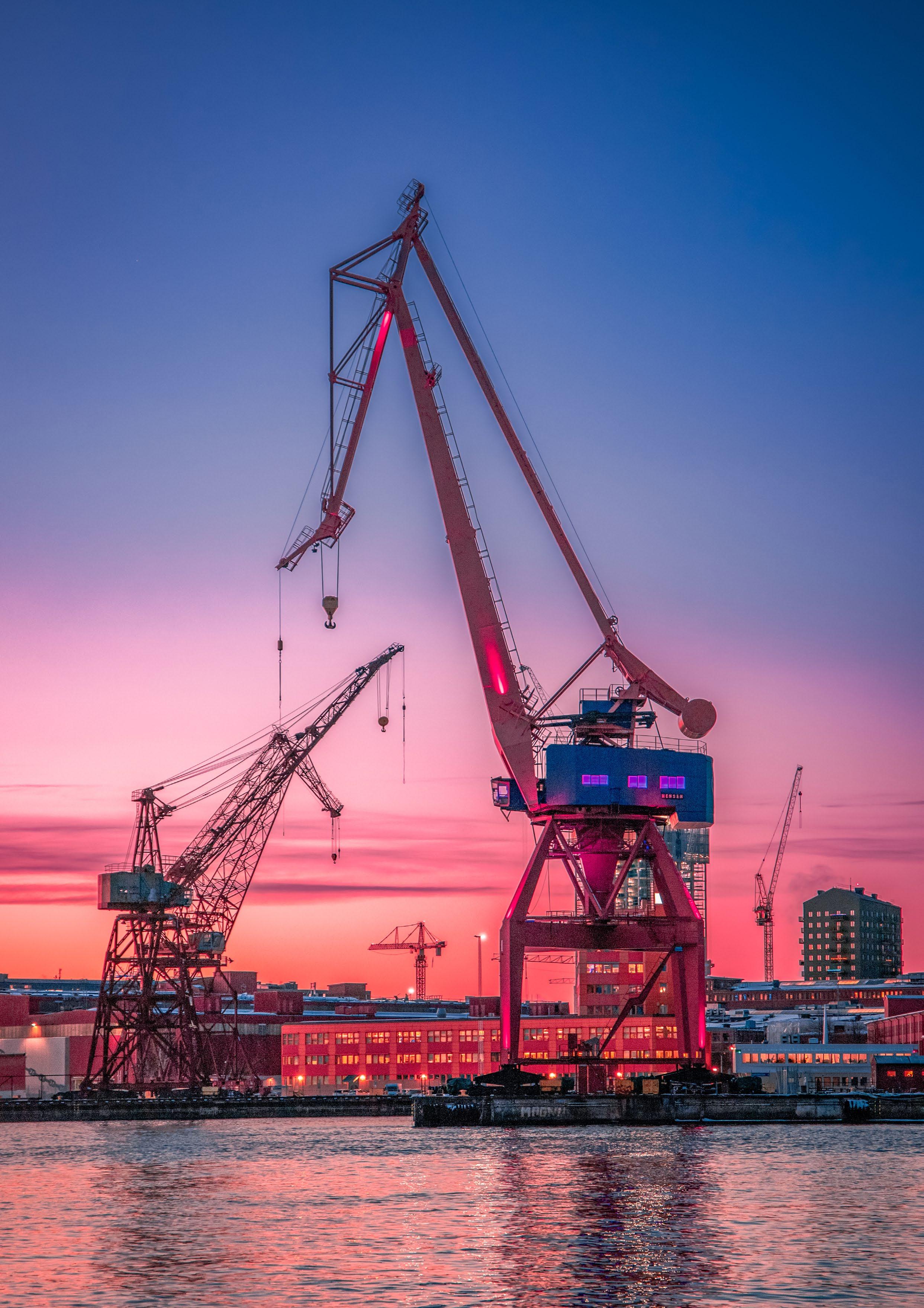
The Cargo Integrity Group has issued a warning on unsafe cargoes, while the International Maritime Organization has updated its SOLAS regulation
The Cargo Integrity Group has issued an urgent warning, identifying 15 common ‘Cargoes of Concern’ that pose significant risks to global supply chain safety if not handled correctly. Commonly transported by sea and intermodally, the highlighted cargoes have the potential to cause significant hazards if not properly handled or declared.
The group, which comprises five major global trade bodies, stresses that while these cargoes are generally transported safely when handled according to regulations and guidelines, improper management or mis-declaration can lead to serious safety risks. The new list aims to raise awareness and prevent further accidents.
The Cargo Integrity Group has divided the products into three categories, as follows:
» Reactive hazards: these can cause fires and significant damage under certain conditions and are typically subject to dangerous goods regulations. Examples include charcoal/ carbon, calcium hypochlorite, lithium-ion batteries, cotton and wool, fishmeal and krill, and seed cake.
» Spill or leak risks: if not properly packed or if damaged, these can harm people and the environment. Examples include hides and skins, wine, bitumen, cocoa butter, waste (recycled engines and engine parts), and vegetable and other oils (especially in flexitanks).
» Improper packing consequences: poorly secured cargo can lead to personnel injuries or damage to property and other cargo, potentially causing severe accidents such as truck rollovers and train derailments. Examples include logs and timber, steel coils, and marble and granite. In the coming months the Cargo Integrity Group will publish additional guidance on the identification and safe handling of these cargoes.
The list is based on data from, among other sources, the claims history of leading freight insurance provider, TT Club; a report prepared by the International Cargo Handling Coordination Association and submitted to the International Maritime Organization on incidents involving dangerous goods on ships or in port, and from the Cargo Incident Notification System, which collates information provided by its members on incidents involving dangerous cargo.
“The combined experience of our organisations has been harnessed to identify these categories and result in pinpointing some commodities where the risks are perhaps less obvious,” says Peregrine Storrs-Fox, Risk Management Director, TT Club.
“While the potential dangers of transporting, for example, calcium hypochlorite or lithium-ion batteries might be more widely appreciated, the combustible qualities of seed cake or the hazards associated with cocoa butter or vegetable oils, will be less well-known.”
“Every actor in the global container supply chain is responsible for the health and safety of not only their own people, but also of those at any onward stage of the container’s journey. Complying with regulations and following
the advice in the CTU Code saves lives, and we appeal to everyone shipping, packing and handling commodities that fall within the categories of these Cargoes of Concern to be particularly diligent,” comments Lars Kjaer, Senior Vice President, World Shipping Council.
The Cargo Integrity Group is a collaboration of five influential international trade organisations committed to promoting high standards in global transport. The group includes FIATA, the Container Owners Association (COA), the International Cargo Handling Co-ordination Association (ICHCA International), the World Shipping Council (WSC), and the TT Club, a consortium of cargo insurers. Together, they work towards improving safety and efficiency within the logistics and transport sectors.
Golden Arrow Marine has been appointed as an official Channel Partner for Alfa Laval, marking a significant step in both companies’ commitment to delivering high-quality, sustainable marine solutions across the UK and Ireland.
The collaboration brings together Alfa Laval’s global expertise in heat transfer, separation and fluid handling technologies with the marine engineering company’s long history and technical capability within the UK marine sector.
With four locations along the UK South Coast and a reputation built over nine decades, Golden Arrow Marine is a trusted name in the industry. The company’s focus on longterm customer relationships, commitment to quality and dedication to sustainable practices made it a natural fit for Alfa Laval’s expanding Channel Partner network.
“We’re incredibly proud to be partnering with Alfa Laval,” says Alex Haywood, Sales Lead at Golden Arrow Marine. “Its product range complements our existing portfolio perfectly, and this partnership allows us to offer even more value to our customers through access to world-class marine technologies and support.”
Alfa Laval’s marine product range includes advanced heat exchanger solutions, battery cooling systems, waste heat recovery solutions and innovative environmental products, including ultrasonic antifouling systems. These technologies will now be available to Golden Arrow Marine customers regardless of their vessel’s energy source or system.
The partnership also reflects Alfa Laval’s strategic focus on working with experienced partners that share its values. Golden Arrow’s proven track record in the commercial marine sector, along with its ISO 9001 and ISO 14001 certifications for quality management systems and environmental management systems respectively, reinforces the alignment between the two companies.
“Golden Arrow Marine is a dynamic, customer-focused business with a strong reputation for quality and service,” says Tristan Matthews, Marine Division Manager at Alfa Laval. “Its values align closely with ours, particularly around maintaining long-standing customer relationships and embracing more sustainable practices and technologies. We’re excited to
welcome it as a Channel Partner and look forward to what we can do together – it’s a big opportunity for us both to achieve further success in the commercial marine sector.”
Simon Leppard, Head of Sales at Golden Arrow Marine, adds: “We see this partnership as something that will greatly benefit our customers. As we look to expand our range, develop our business and support our customers, we’re always looking for new opportunities and technologies that complement our existing equipment ranges.
“To be able to work with such a well-respected industry leader in Alfa Laval – that’s hugely significant. Their technologies will complement our range and allow us to better provide our customers with full support solutions. We’re really looking forward to working with them.”
Northern European ports have been experiencing their longest operational crisis since the pandemic, with mounting congestion and delays affecting major hubs such as Rotterdam, Antwerp and Hamburg.
Waiting times for vessels range from several days to up to two weeks, with delays being worsened by a combination of recent industrial action, record-low inland water levels and high terminal yard utilisation.
In the UK, ports including Felixstowe, London Gateway, and Southampton are also experiencing their own congestion challenges, with both waiting times and yard occupancy remaining high.
Danish giant Maersk has announced it will omit Rotterdam entirely from its TA5 transatlantic service beginning 25 June. At Antwerp, officials have described the current situation as “the worst congestion since covid-19”, with dwell times now exceeding eight days and terminal capacity at its limit.
Rotterdam is experiencing crisis-level disruption, with strikes at APM Terminals Maasvlakte II and inland barge delays of up to 48-56 hours.
The problems are not restricted to Europe, however. According to Tradlinx, 96% of major ports reporting operational disruptions and vessel delays have surged up to 300% above normal.
In a recent report, it found:
» Peak wait times now exceed 10 days at major ports like Rotterdam, Cape Town, and Ningbo-Zhoushan.
» Demurrage fees range from $75 to $300 per container/ day, adding thousands to logistics budgets.
» Only 58.7% of ships globally are arriving on time – a sharp decline from 80–90% pre-2020 averages. The issues have led to retailers and manufacturers adding three-five weeks buffer stock, while shipping companies are extending schedules by 15–21 days on average.
The report points to a number of long-term solutions that ports are examining to resolve the problems:
» Infrastructure investment: $64.5B in port upgrades planned globally through 2025–2027

» Tech stack modernisation: adoption of real-time tracking tools, digital twins and automated stacking cranes
» Labour stability: collective agreements, upskilling programmes, and automation–workforce integration to reduce strikes
» Cross-modal integration: better coordination between ports, rail, and inland logistics hubs to absorb volume surges.
Capt Cloggie-Holden rose through the ranks at the RFA after joining straight from school in 2000. She became the first RFA female champion, set up a female-to-female mentoring scheme across the RFA and also became a founding member of the Maritime UK Women in Maritime Taskforce. This work saw her awarded the prestigious Merchant Navy Medal in 2021 for her tireless work to support women in maritime, and six years ago she was named the Global Seafarer of the Year at the Lloyd’s List Europe Awards.
Captain CloggieHolden becomes the first female to perform the Group Harbour Master role at Peel Ports
Peel Ports Group has appointed Captain Susan Cloggie-Holden as its new Group Harbour Master. She replaces Gary Doyle, who is stepping down later this month after nearly a decade at the port operator.
Capt Cloggie-Holden joins the UK’s second largest port operator after a distinguished career with the Royal Fleet Auxiliary (RFA), where she became the organisation’s first female commanding officer in its 120-year history in 2021.
She now becomes the first female to perform the Group Harbour Master role at the port group, as she takes on the role of the most senior figure overseeing marine operations across Peel Ports Group’s network, which includes the Port of Liverpool, Clydeport and London Medway.
In her new role she will lead teams across seven harbour authorities in delivering their responsibilities for operational and navigational matters, including vessel traffic management, pilotage, harbour services and safety and security across the Group’s marine operations.
“It’s an incredible honour to take on the role of Group Harbour Master at Peel Ports Group,” says Captain Cloggie-Holden.
“I’m looking forward to working alongside the dedicated marine teams across the business and building on the strong foundations Gary has laid. His contribution to the company and the wider maritime industry is immense, and I’m truly grateful for the opportunity to continue that legacy.”
She has travelled the world and taken part in military and peacekeeping operations, including the initial Operation Veritas campaign against the Taliban in 2001-02, supporting the post-Saddam Iraqi Navy in 2006-07, conducting counterpiracy operations in the Gulf of Aden at the height of the scourge in 2008-09, and navigating supply ship RFA Fort Rosalie as it provided support to RN vessels involved in operations off Libya in 2011.
David Huck, Chief Operating Officer at Peel Ports Group, adds: “We’re delighted to welcome Susan, whose experience and vision make her ideally placed to lead us into the next chapter. Her appointment marks an exciting milestone for Peel Ports Group and the industry more widely.”
Saudi Arabia’s top terminal operator, Red Sea Gateway Terminal (RSGT), has signed long-term agreements to run four additional terminals along the Red Sea coast.
These 20-year build-operate-transfer deals with the Saudi Ports Authority (Mawani) give RSGT control over critical cargo handling operations at Jeddah Islamic Port, King Fahd Industrial Port in Yanbu, Yanbu Commercial Port and the Port of Jazan.
The move folds 13km of quay and 3.3 million square metres of space into RSGT‘s expanding footprint – now including not just containers but general cargo, bulk, Ro-Ro, livestock, and project cargo.
At Jeddah Islamic Port, RSGT will manage consolidated general cargo and Ro-Ro terminals as a unified multipurpose operation. In Yanbu, it adds dry and liquid bulk to its reach, while also planning container development. In Jazan, dry bulk and general cargo handling now come under RSGT‘s remit.
The company is setting up a new multi-purpose terminals business unit to oversee all non-containerised operations. Investments are pegged at SAR 1.6bn ($418m) over the life of the concessions, with SAR 700m ($180m) earmarked for the first five years – covering infrastructure upgrades and smart tech rollouts.
Annual projections are ambitious: three million tons of general cargo, 13 million tons of dry bulk, 13.5 million tons of liquid bulk, 710,000 vehicles and eight million head of livestock. This move signals RSGT‘s clear intent to tap into every cargo niche possible.
RSGT CEO Jens Floe says the move “marks a milestone in the evolution of our strategic vision”, emphasising the operator’s

















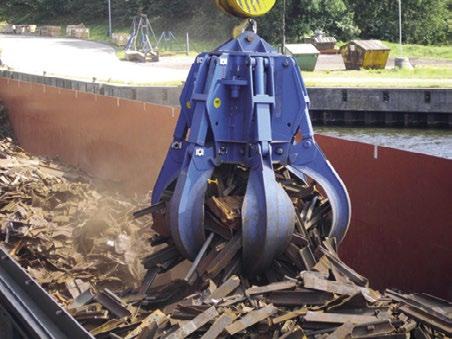







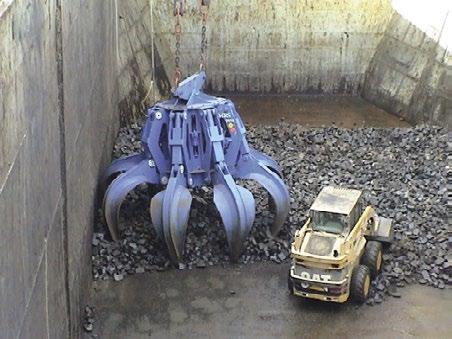

























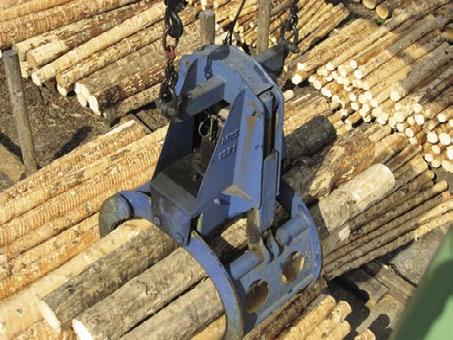
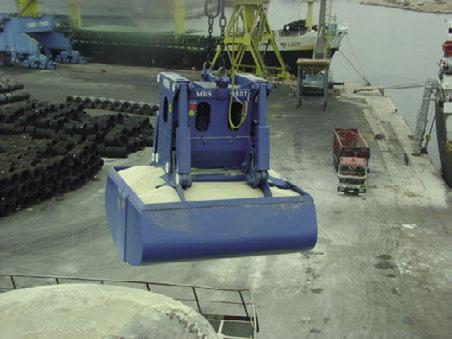
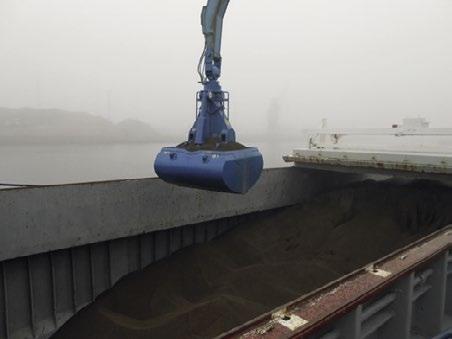
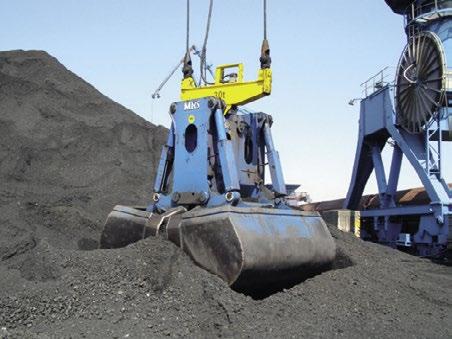
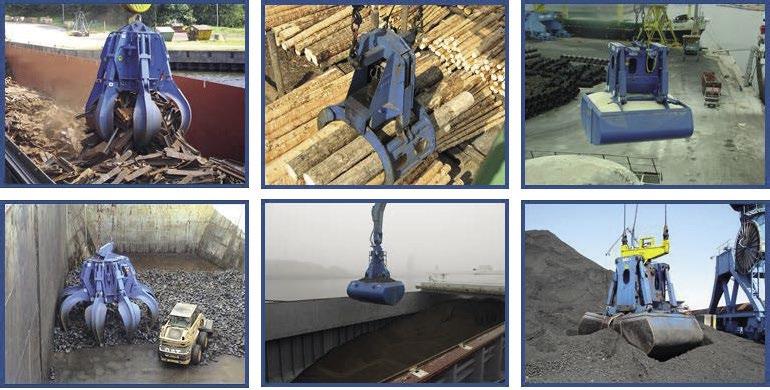








shift from purely containers to a broader logistics play that aligns with Saudi Vision 2030.
With its 2024 container volumes at 3.1 million TEUs – amid geopolitical disruption in the Red Sea – RSGT is pushing ahead on both domestic expansion and global reach. Its affiliate, Red Sea Gateway International (RSGTi), has already taken Saudi port operations overseas with a terminal at Bangladesh’s Chittagong Port.
The International Maritime Organization (IMO) has introduced ‘SOLAS Regulation II-1/3-13 through Resolution MSC.532(107)’, setting new requirements for lifting appliances and anchor handling winches. These updates will take effect on 1 January 2026, ensuring enhanced safety and operational standards across the maritime industry, says Lloyds Register.
The SOLAS amendments are supplemented by the IMO MSC.1/Circ.1663 Guidelines for Lifting Appliances.The new regulation applies to a wide range of lifting appliances, including those:
» Used for cargo loading, transfer, or discharge
» Used for raising and lowering hold hatch covers or
moveable bulkheads
» Used as engine-room cranes
» Used as stores cranes
» Used as hose handling cranes;
» Used for launch and recovery of tender boats and similar applications
» Used as personnel handling cranes.
Generally, the requirements also apply to lifting appliances with a safe working load below 1,000 kg, unless the flag administration grants specific exemptions. However, certain lifting appliances – including those used on offshore construction ships – are outside the scope of this regulation.
Before entering service, new lifting appliances must undergo certification, which includes:
» Plan appraisal and material verification
» Inspection and testing during fabrication
» Verification of component certification (including loose gear)
» Load testing and thorough examination once installed on board.
Lifting appliances certified or classed under Lloyd’s Register’s Code for Lifting Appliances (CLAME) framework will be compliant with the new SOLAS requirements.
Requirements for existing lifting appliances (installed before 1 January 2026)
Under SOLAS Regulation II-1/3-13.2.4, lifting appliances installed before 1 January 2026 must undergo load testing and thorough examination, as per the IMO guidelines. These appliances must be permanently markedand include documentary evidence of the safe working load (SWL).
Existing certificates issued under other international instruments – such as ILO Convention No. 152 - will be acceptable for compliance. If valid certificates are missing (e.g. for engine-room cranes), owners must determine the appropriate SWL for test load verification.
In instances where onboard lifting appliances do not have valid certificates of test and thorough examination under another international instrument acceptable to the flag Administration, the SWL should be determined by the owners, in accordance with the IMO guidelines (paragraph 3.2.1.6) and evidence of the SWL provided. For those non-certified lifting appliances, Lloyd’s Register (LR) will witness a load test followed by a thorough examination and will issue a factual statement to confirm the load test and examination.At the first Cargo Ship Safety Construction Renewal Survey or Passenger Ship Safety Survey conducted after 1 January 2026, surveyors will verify that:
» All applicable lifting appliances are certified in accordance with an acceptable standard.
» All lifting appliances are properly marked with safe working load (SWL) and other information essential for the safe operation of the lifting appliance (e.g. maximum or minimum slewing radius or boom angle).
» All loose gear is clearly and permanently marked with its unique identification (serial no.), the SWL and any additional marks required for safe use.
» All lifting appliances and associated loose gear were load tested and thoroughly examined by a competent person.
» All lifting appliances are provided with an operation and maintenance manual.
Note: An acceptable standard includes certification under LR CLAME, another IACS member code, ILO Convention 152, or any other international standard recognised by the flag administration. If no prior certification is found, lifting appliances must undergo load testing and thorough examination by a competent person, as defined by the Administration, during the renewal survey.
According to SOLAS Regulation II-1/3-13.3, all lifting appliances and loose gear must be operationally tested, thoroughly examined, inspected, operated and maintained in line with the IMO guidelines.
Owners must adhere to manufacturer recommendations, industry standards, and operational profiles while ensuring that lifting appliances are part of the onboard maintenance programme. Maintenance and operational manuals must be available on board — where missing, the IMO guidelines provide methods for reconstructing them.
All personnel operating lifting appliances must be properly trained, qualified and familiarised in handling the equipment.
For better survey flexibility, Lloyds Register is introducing survey range windows for lifting appliances. These will be included in the upcoming CLAME amendments, scheduled for publication on 1 January 2026.
While the new SOLAS regulations do not explicitly define survey range windows, some flag administrations permit their use, whereas others have expressly prohibited them. Owners interested in applying survey range windows are encouraged to contact LR for guidance and support.
It’s important to note that certain local authorities and ports may not recognise survey range windows, particularly due to ILO Convention 152 requirements. In such cases, owners may be required to complete lifting appliance certification before the end of the advertised survey window.
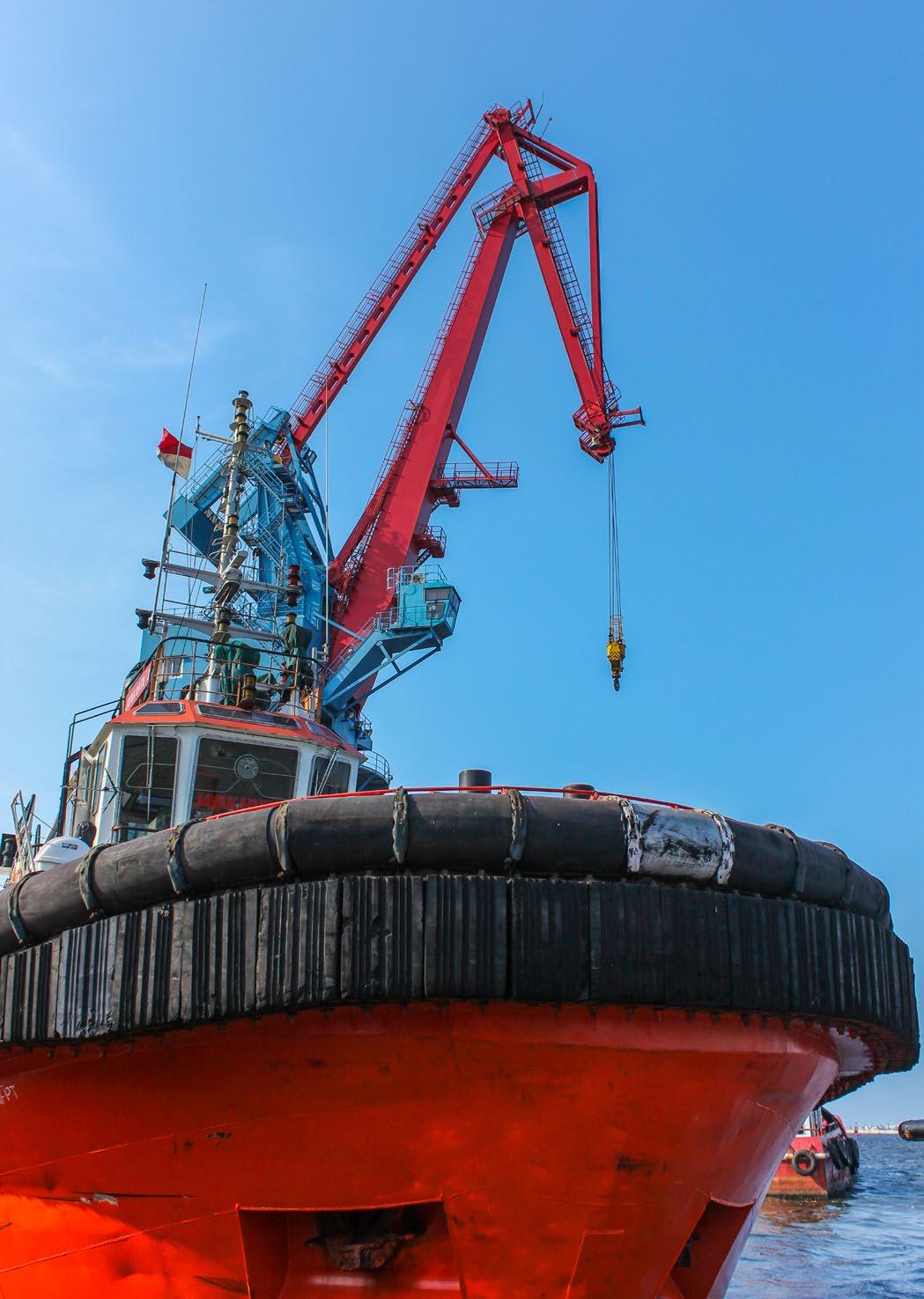

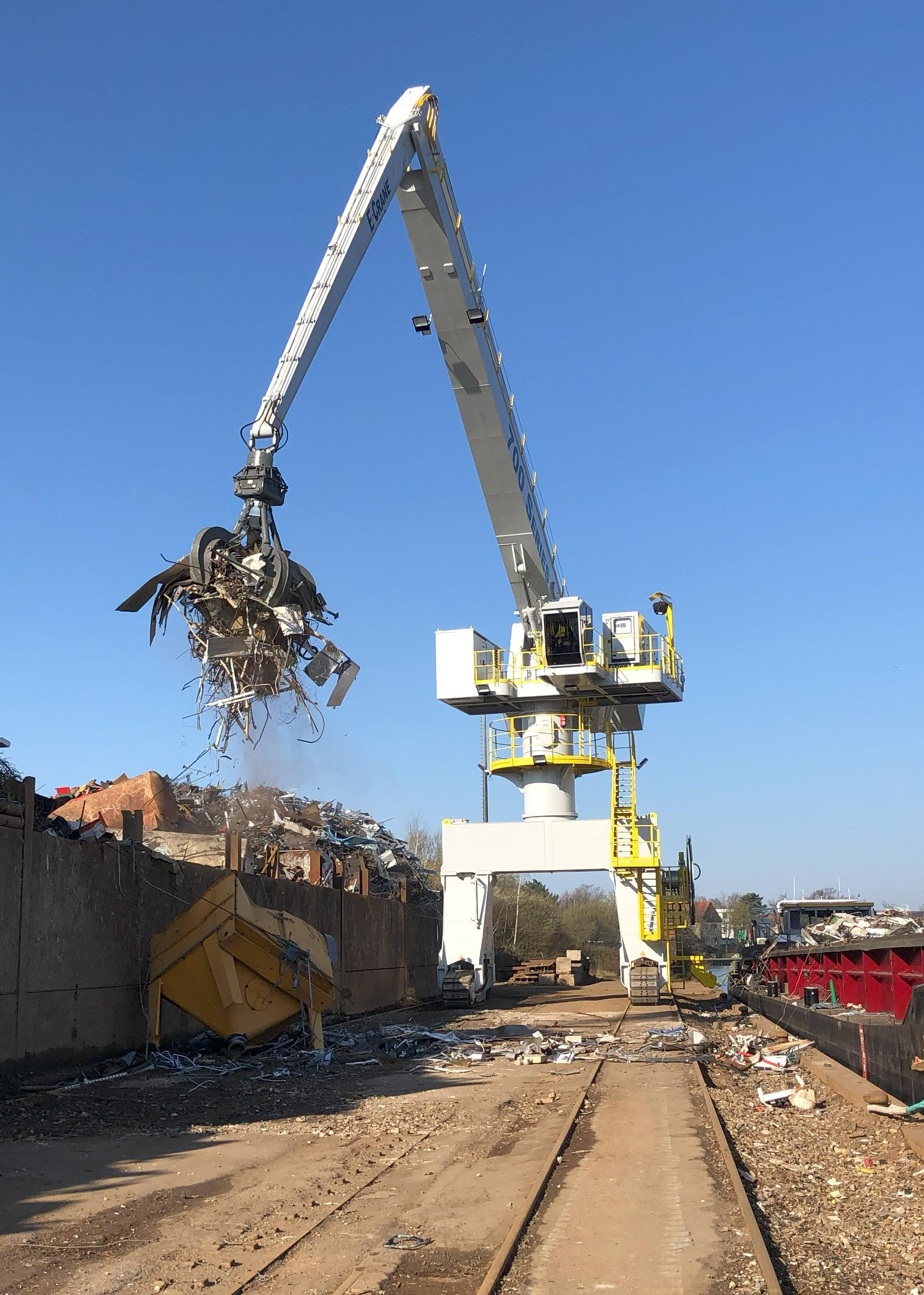



State-of-the-art cranes are transforming port operations by enhancing operational efficiency while reducing emissions, energy consumption and maintenance costs
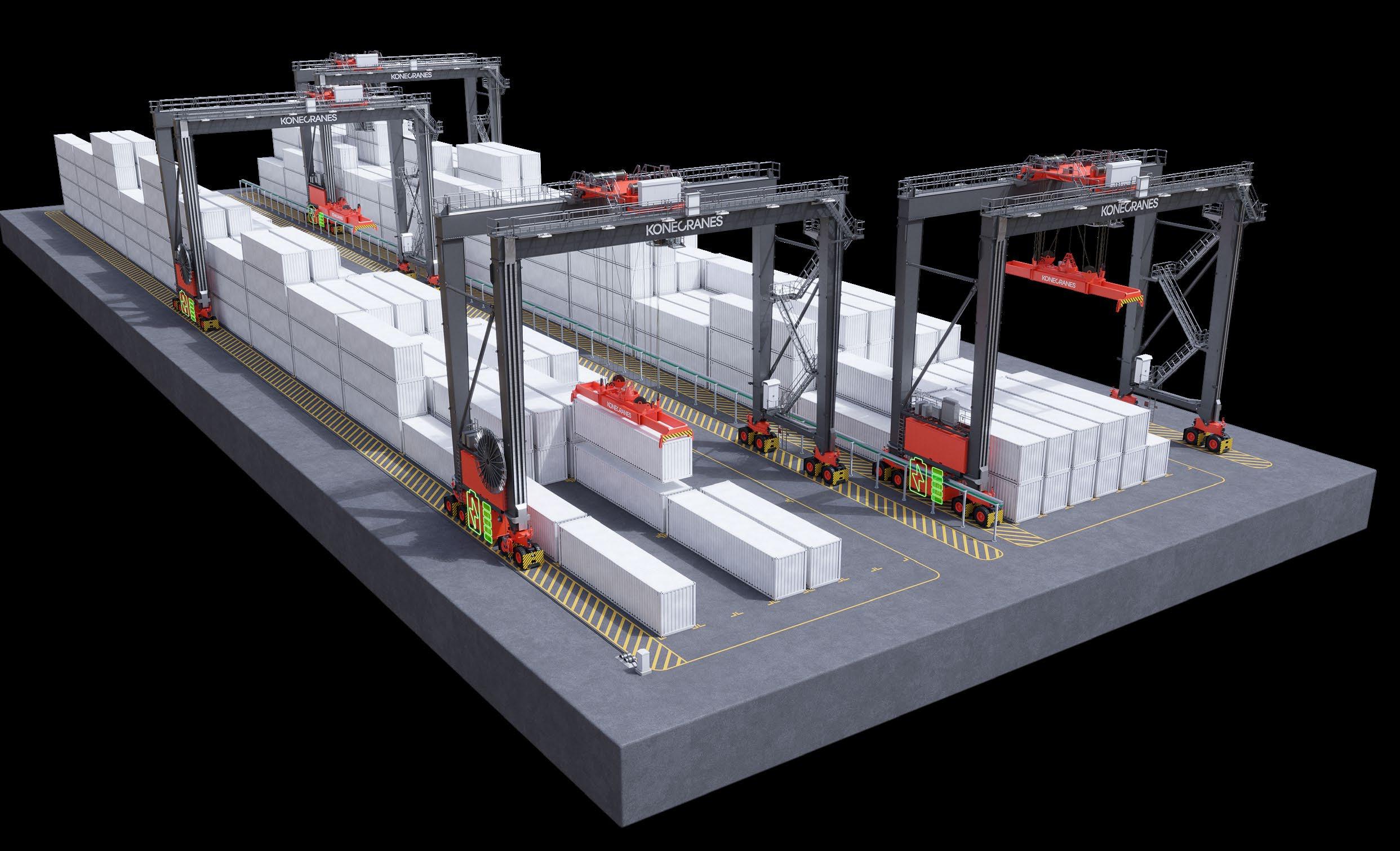
Konecranes has received an order to supply 39 industrial cranes, with lifting capacities ranging from a couple of tons to several hundred tons, to Hitachi Energy’s new transformer manufacturing facility in Mustasaari, Finland. The order includes four Smarton cranes, 21 Konecranes S-Series and 14 Konecranes CXT overhead cranes, all designed to meet the demanding requirements of heavy transformer production. Deliveries are due for completion by the end of 2026.
Hitachi Energy is the world’s largest transformer manufacturer by installed base and portfolio range. The new production and technology centre – Hitachi Energy Park, located in the Vaasa region – will house a state-ofthe-art transformer factory, including production, testing, and office facilities for professionals in electrification, automation and software development. The centre will double Hitachi Energy’s transformer production and testing capacity in Finland, supporting the growing global demand for transformers as part of the energy transition, electrification and growth of renewable energy.
The four Smarton cranes are each equipped with a main hoist rated for up to several hundred tons and an auxiliary hoist with a capacity of 10 to 20 tons. These advanced cranes feature intelligent lifting capabilities for high-precision handling of large transformer components. The remaining lifting equipment includes a mix of double-girder and single-girder cranes, wall console cranes and units with synchronised lifting and shared rail configurations, all designed to optimise factory floor space and workflow.
“These cranes are tailored to the specific demands of transformer manufacturing, featuring motorised hook blocks for precise control and safety, and Konecranes S-series hoists with synthetic ropes to support a cleaner production environment,” says Isto Heino, Sales Director, Industrial Cranes, Finland. “They were carefully integrated in collaboration with Hitachi
Energy to enhance efficiency and streamline production.”
In addition to the lifting equipment, the order includes a spare parts package for critical components, power supply lines, operator training, and statutory annual inspections.
These advanced cranes feature intelligent lifting capabilities for high-precision handling
“We need a partner who can deliver custom cranes that align with our production needs and time-critical investment schedule,” says Matti Vaattovaara, Managing Director, Hitachi Energy Finland.
“We aim to double our transformer production capacity with a wider portfolio. Transformers are missioncritical technologies advancing societies toward a carbon-neutral energy future, supporting our customers in the clean energy transition and the rapid pace of electrification. As an integral part of our investment, these cranes must offer topnotch heavy-lifting capabilities, safety and reliability.”
Konecranes has unveiled its new E-Hybrid Rubber-Tyred Gantry (RTG) crane and electric empty container handler for the global market, moving it one step closer to its goal of having fully electric variants of its entire port equipment portfolio by 2026.
The new Konecranes E-Hybrid RTG expands the meaning of hybrid power beyond traditional diesel-battery RTG operation to electric-battery operation – a vital option especially for terminals currently unable to drop diesel power given the need for back-up if blackouts occur. Even short, one- or twosecond blackouts cause emergency stops, brake issues and maintenance problems, while longer outages halt operations completely.
“Blackouts are a clear operational risk for a number of our terminal customers, so the Konecranes E-Hybrid RTG, with a combination of onboard batteries and busbar or cable reel electricity supply, solves that problem,” says Thomas Gylling, Director of Marketing and Customer Experience, Port Solutions, Konecranes. “But the E-Hybrid RTG is a game-changer for all customers on the road to fully electric container handling and lower emissions.”
Container terminals can charge the E-Hybrid RTG batteries via a cable reel or busbar system during the normal flow of operations. The electrical power requirement for battery charging is 60kW, much less than the up to 400kW needed for RTGs powered directly by cable reel or busbar systems. Therefore, significant CAPEX savings can be achieved when building or adjusting the container yard infrastructure.
All of the parts are field-proven, including Konecranes’ RTG battery technology, currently used in over 200 hybrid Konecranes RTGs globally.
Konecranes has already received an order for E-Hybrid RTGs from a Brazilian container terminal, and the E-Hybrid RTG is now available globally.
Konecranes is also rolling out its electric empty container handler 9-10t in Europe and North America after successful launches in Asia, Middle East and Africa, and Latin America. Customers like the truck’s fast acceleration and lifting speed, quick charging, low noise and vibration, and zero tailpipe emissions.
This empty container handler is the latest addition to the series of fully electric lift trucks that Konecranes has
introduced in recent years, starting with the 10-18t and 18-25t electric forklifts.
“The electric empty container handler is now available in Europe and North America. It has been well-received in the rest of the world, offering customers the compact efficiency they expect in a powerful and durable electric lift truck,” Gylling says.
“These introductions are part of Ecolifting, Konecranes’ vision to increase its handprint – meaning the beneficial environmental impact that can be achieved with our product and service portfolio – while reducing customers’ carbon footprints”.
Saga Fjordbase, Norway’s largest supply base with around 2,000 vessel calls annually, has ordered a Liebherr LHM 280 mobile harbour crane, underscoring its commitment to futureready port infrastructure. Delivery is expected during the first quarter of 2026.
The crane is tailored for electric operation and includes a rotator for versatile cargo handling. With a weatherprotected staircase to the tower cabin and a reactive power compensation unit, the crane is engineered for both operator comfort and grid efficiency. It will support operations across a logistics network spanning more than 1,060,000 square metres and enable seamless integration into the port’s existing crane, truck, and storage systems.
The LHM 280 reflects a growing trend among ports to align equipment choices with long-term operational needs. The crane’s electric drive system, coupled with an 84-tonne winch and 40-metre outreach, significantly reduces local emissions, aligning with the port’s environmental goals.
A standout feature is the integrated reactive power compensation unit, which optimises energy use and minimises strain on the local grid. It
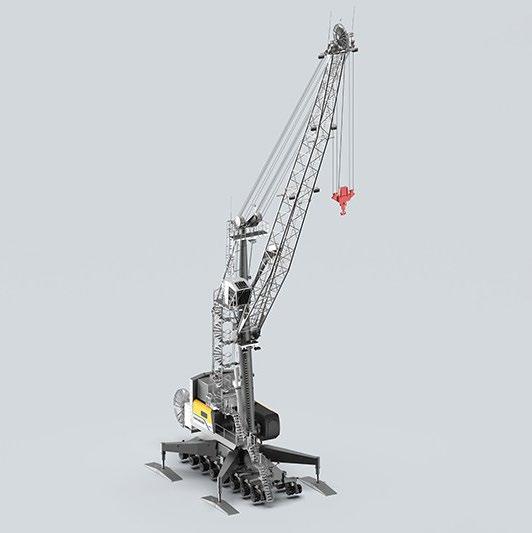
works by adding or absorbing reactive power to balance the electricity in a system, which helps keep voltage stable and reduces the extra power the grid has to supply. This makes energy use more efficient and lowers strain on the local grid by improving power quality and reducing energy losses.
Saga Fjordbase worked closely with Liebherr to configure a crane that fits the specific demands of offshore logistics in western Norway. Each element was selected with a clear purpose: to support reliable, low-emission operations in a high-throughput setting.
As Norway’s largest offshore supply base, Saga Fjordbase plays a critical role in supporting energy infrastructure and maritime logistics. The company has been investing in digital platforms such as Saga Connect and electrified port equipment to reduce its carbon footprint.
“The LHM 280 is a strategic addition to our port,” says Dag Eikeland, VP Logistics, Saga Fjordbase. “Its electric drive and energy optimisation features directly support our efforts to reduce emissions and improve quay turnaround times. These are key factors in maintaining our position as a leading offshore logistics hub.”
The LHM 280 will be deployed to handle supply chain operations for offshore platforms, where reliability and turnaround time are paramount. The crane’s rotator adds flexibility for complex lifting tasks, while its electric configuration supports the port’s broader electrification efforts. The base has also reduced average quay turnaround time by 30% through the use of custom logistics software – an efficiency gain that complements the crane’s rapid handling capabilities.
The collaboration between the two companies builds on a shared vision of innovation and sustainability. The crane is part of a broader initiative to modernise port infrastructure in Florø, ensuring long-term resilience and competitiveness in the maritime logistics sector.
The crane’s energy optimisation features are particularly relevant in a
port that handles a high volume of vessel traffic and operates year-round in variable weather. Its outreach and lifting capacity allow it to manage a broad range of cargo types relevant for offshore supply logistics. Liebherr’s service network will provide ongoing support, ensuring the crane remains reliable and well-maintained over its lifecycle.
“This delivery reflects a shared understanding of what’s needed in today’s port operations,” says Andreas Ritschel, General Manager Sales Mobile Harbour Cranes at LiebherrRostock GmbH.
“We’ve worked closely with Saga Fjordbase to deliver a solution that fits its goals technically and operationally.”
The LHM 280 is expected to play a long-term role at the port’s operations. As the port continues to evolve, the crane offers a flexible, low-emission tool that supports both day-to-day logistics and the broader transition toward more sustainable maritime infrastructure.
MacGregor has announced the successful delivery of its new type of SWL 250t electric heavy lift cranes to Nordic from Huanghai Shipbuilding Co. The cranes mark a significant milestone in sustainable cargo handling solutions.
This next-generation heavy lift crane combines MacGregor and NMF’s extensive experience in the heavy lift industry. The crane is designed to enhance operational efficiency while significantly reducing emissions, energy consumption and maintenance costs.
By leveraging MacGregor’s advanced electric drive technology, the crane eliminates hydraulic oil usage, improving environmental performance and ensuring compliance with stricter industry regulations.
Soeren Hoessermann, Managing Director at Nordic Hamburg Shipmanagement (HK) says: “We are pleased to receive MacGregor’s
electric heavy lift crane, which aligns with our commitment to improving efficiency and reducing our environmental impact. This innovative technology will help us optimise cargo handling operations while contributing to our sustainability goals.”
“At MacGregor, we are fully committed to delivering sustainable and innovative solutions that will create lifetime value in cargo handling,” says Magnus Sjöberg, Senior Vice President, Equipment Solutions Division, MacGregor.
“The delivery of our new electric heavy lift crane is a testament to our dedication to reducing the environmental footprint of maritime operations while maintaining the highest standards of performance and reliability.”
The crane will be installed on the vessel Amy, which will play a key role in the cargo market.

With their balanced design and energy efficiency, these cranes are particularly wellsuited for waterbased operations
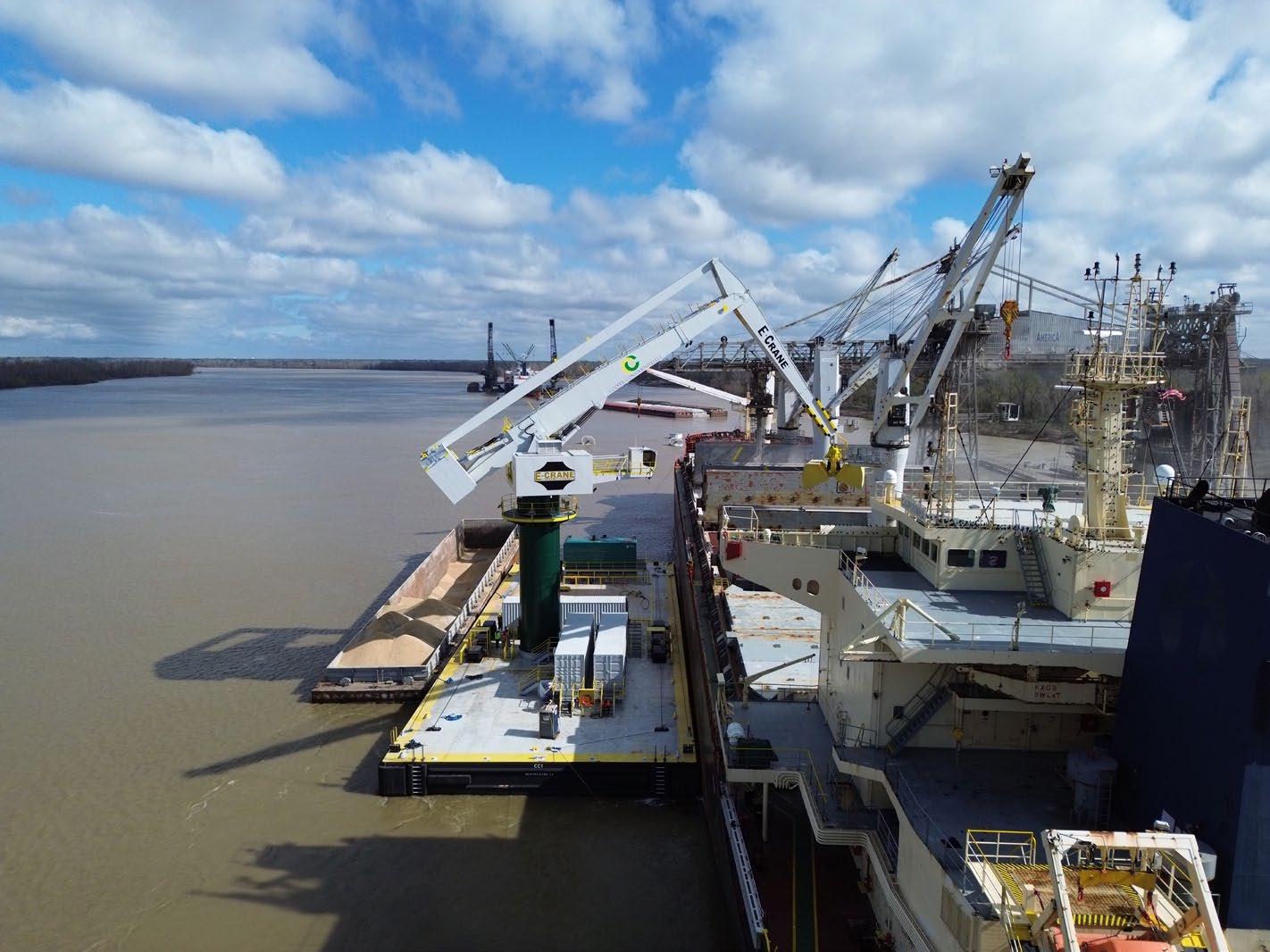
In a significant leap forward for stevedoring operations on the Mississippi River, Cooper Consolidated LLC has added two of the largest equilibrium cranes to its fleet. The 4000C Series E-Cranes, named Pelican and Creole King, represent a strategic investment aimed at modernising bulk cargo handling.
Built by the Belgian manufacturer E-Crane, the 4000C Series is the pinnacle of floating crane technology. With their balanced design and energy efficiency, these cranes are particularly well-suited for water-based operations, where mobility, durability, and environmental performance are key operational considerations.
Each crane is mounted on new barges measuring 200’ x 72’ x 12’ constructed in 2024 at Corn Island Shipyard in Indiana.
Unlike conventional crane systems, equilibrium cranes use a counterweight to balance the boom and reduce the energy required for lifting – making them more energy efficient and easier on mechanical components.
With a maximum outreach of over 38.1m and lift capacities of up to 58 tonne, the Pelican and Creole King are engineered to handle large volumes of bulk and breakbulk cargo with remarkable precision.
This enhanced capacity directly benefits key customers in sectors such as agriculture, bulk materials and also heavy equipment.
“Cooper Consolidated is constantly aiming to provide our customers with the highest quality of service and the most efficient cargo handling,” says Chris Blanchard, Executive Director of Cooper Consolidated. “The addition of North America’s largest E-Cranes to our fleet helps us continue to meet our high standards and exceed our customers’ expectations.”
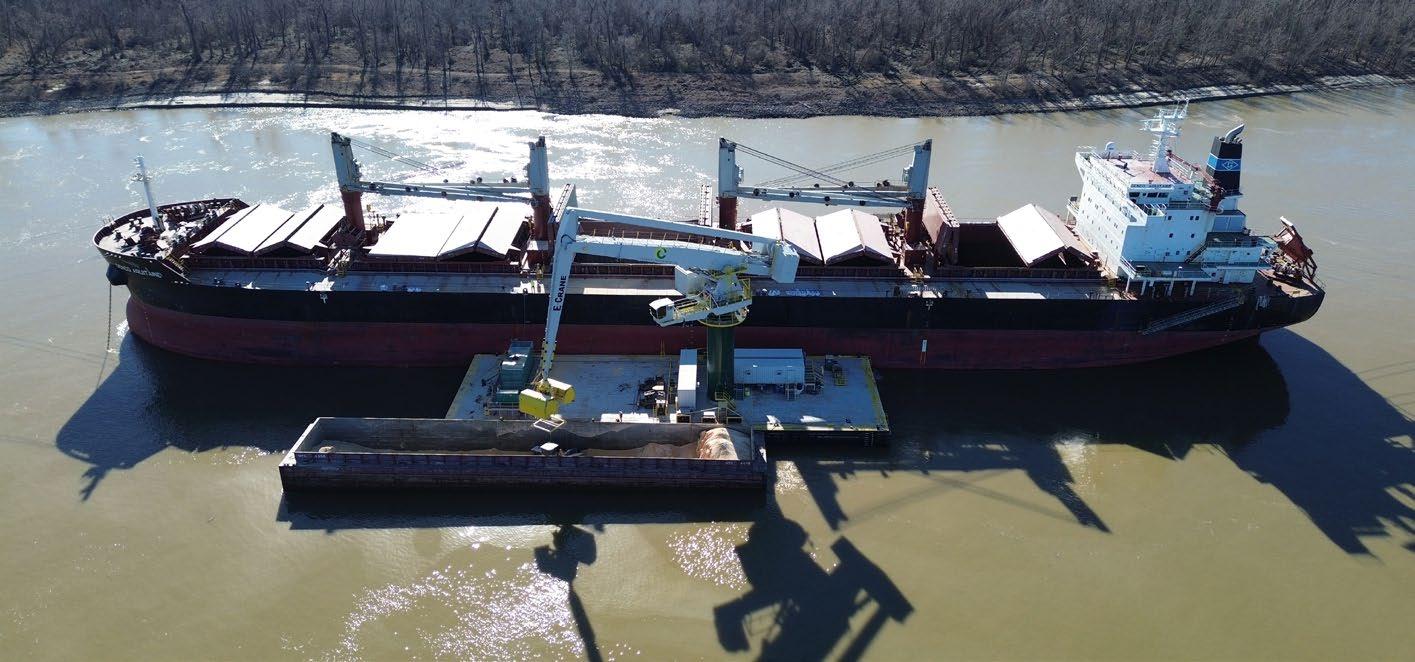
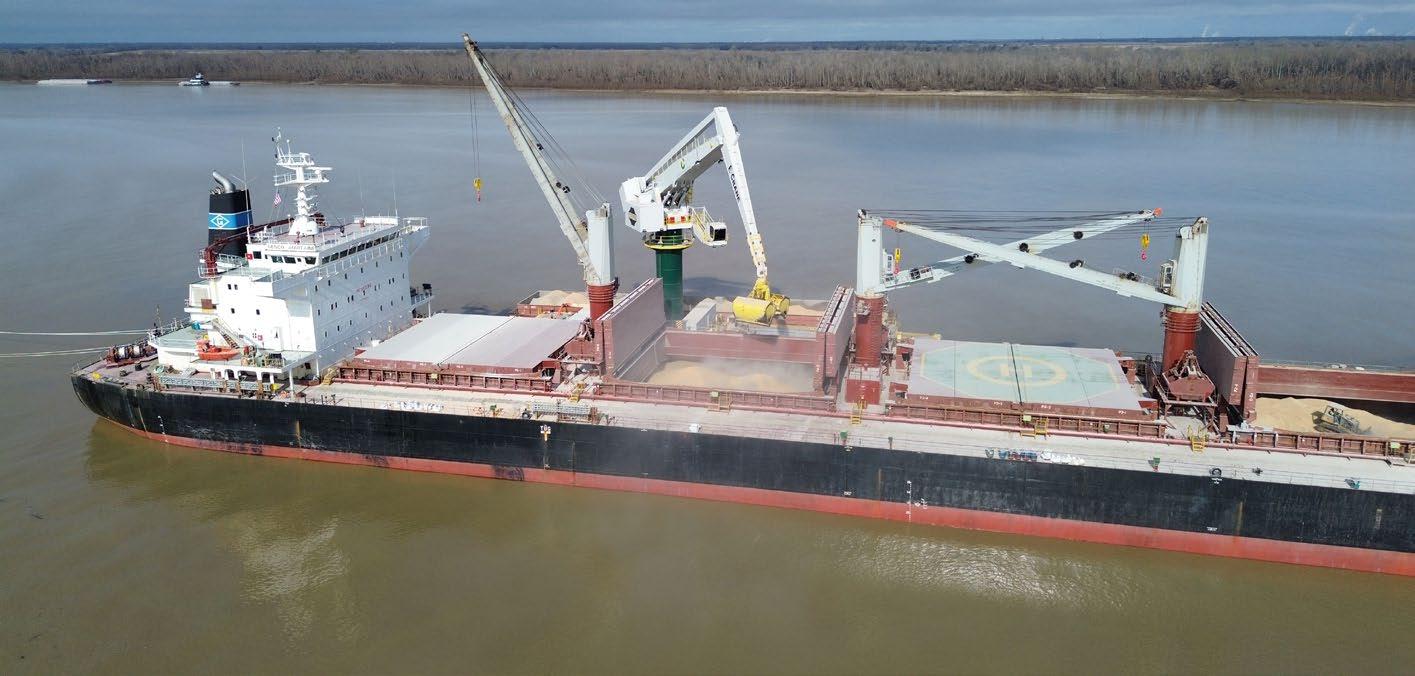
The deployment of these cranes was the result of a closely coordinated effort between Cooper Consolidated and E-Crane’s teams. From design customisation to barge integration and on-site commissioning, the project involved months of planning and execution.
“The decision to bring the largest E-Cranes to the Mississippi River was a collaborative effort between the E-Crane and Cooper Consolidated teams and continues our tradition of adding unique assets to our operations that offer value for our customers,” says Billy Fitzpatrick, Managing Director of Sales and Stevedoring at Cooper Consolidated.
The Pelican was erected and commissioned in December 2024 and is currently in operation. The Creole King will commence operations in July 2025.
With the addition of the Pelican and Creole King , the company further strengthens its ability to serve high-volume shippers looking for reliable alternatives to congested coastal ports.This expansion not only enhances Cooper Consolidated’s technical capabilities, but also signals a broader shift towards more efficient, sustainable, and scalable solutions in riverbased logistics.
Cooper Consolidated is a full-service provider of stevedoring, logistics and material handling solutions along the Lower Mississippi River. With decades of experience and a focus on innovation, the company supports a broad range of industries through efficient, customerfocused operations.
For more information, visit: cooperconsolidated.com.
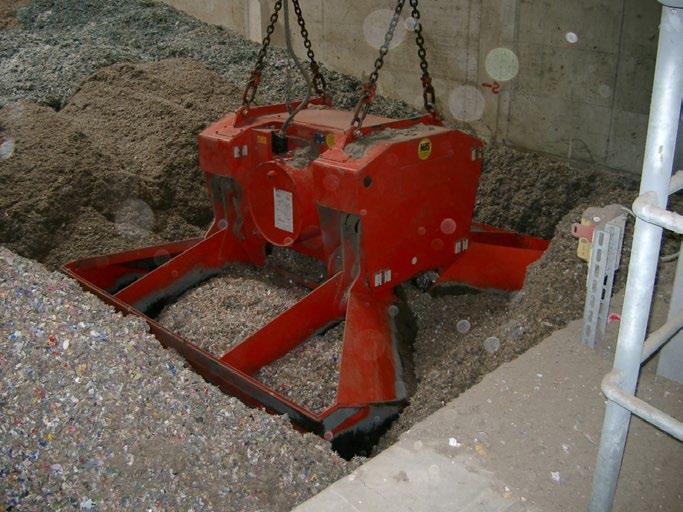
Established in 1977, MRS Greifer GmbH is a leading engineering company providing design, manufacture, supply and after sales services for grab buckets up to 30m³ capacity. Our commitment to continuous research and development ensures our grabs are world leaders in terms of technology, quality and performance.
With five decades of experience in the design, manufacture, research and development of grabs, plus an extensive after-sales service backed by our team of highly skilled engineers, MRS Grabs has clients from every corner of the world.
We design grabs to fully meet the needs of our clients and the parameters within which they work, producing equipment capable of unloading all kinds of bulk cargo. Our machines include the latest features and are of optimal weight, ensuring an exemplary performance for a longer period of time. When it comes to hydraulics and other outsourced parts, we only use trusted brands so the highest quality is ensured.
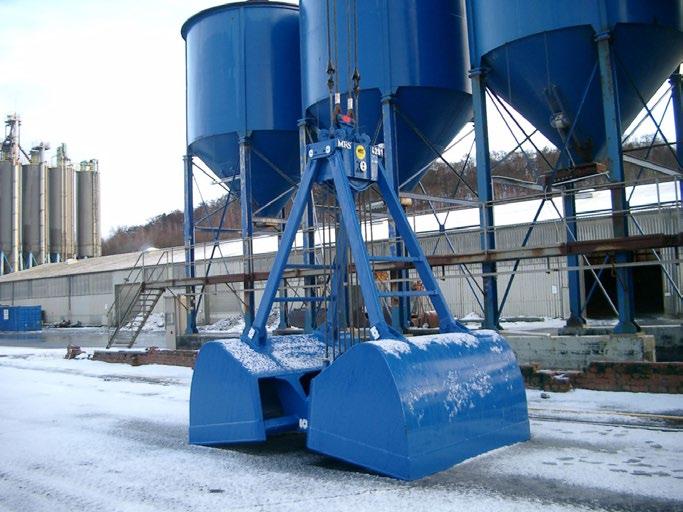
Each grab is manufactured under the industry’s strict quality controls, according to the QAP approved by our experts. We are only too aware that delays in shipping can result in exorbitant costs so we keep a full stock of spare parts, and our committed after-sales service team is available to see to all our customers’ needs in the quickest possible time.
With grabs to handle bulk, logs, scrap, underwater dredging and more, please don’t hesitate to contact us to talk through your needs.

For more information, contact: MRS Greifer GmbH
Talweg 15 - 17
74921 Helmstadt
Tel: +49 7263 9129-15
Fax: +49 7263 9129-12
Email: export@mrs-greifer.de mrs-greifer.de
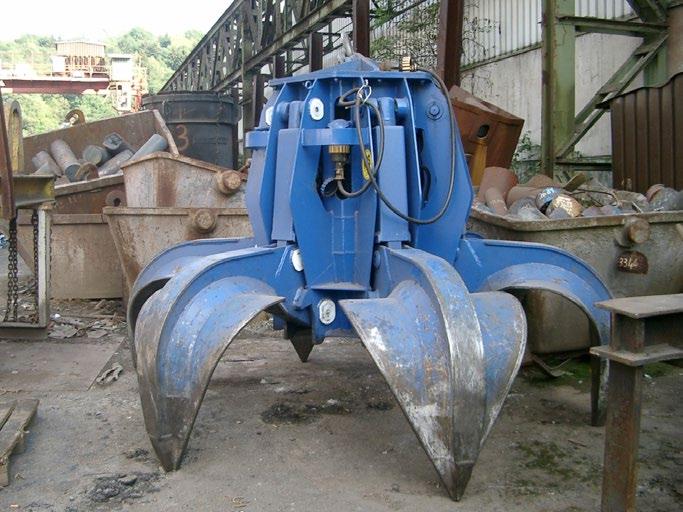
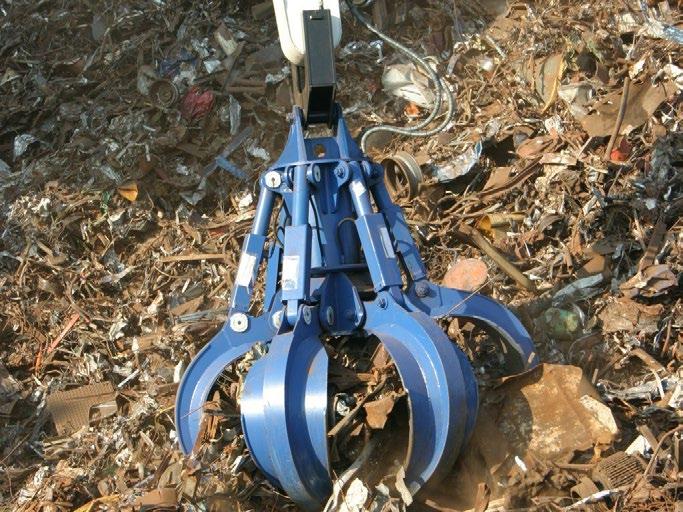
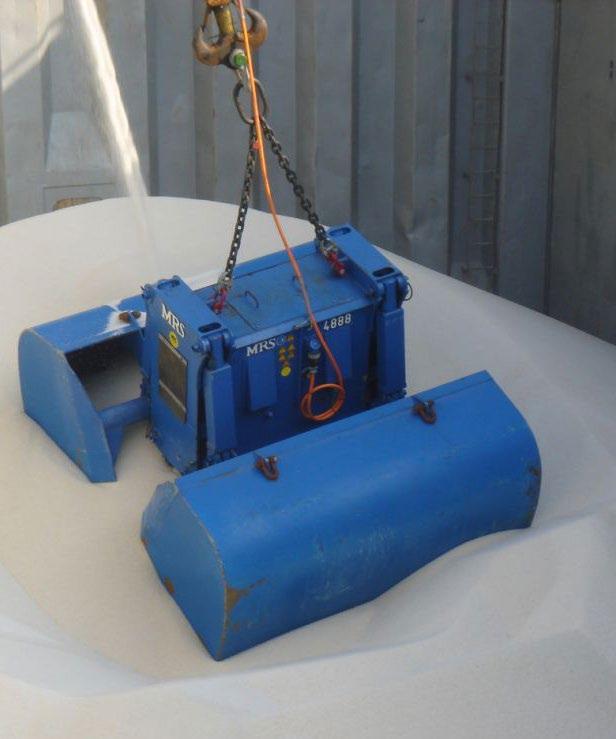
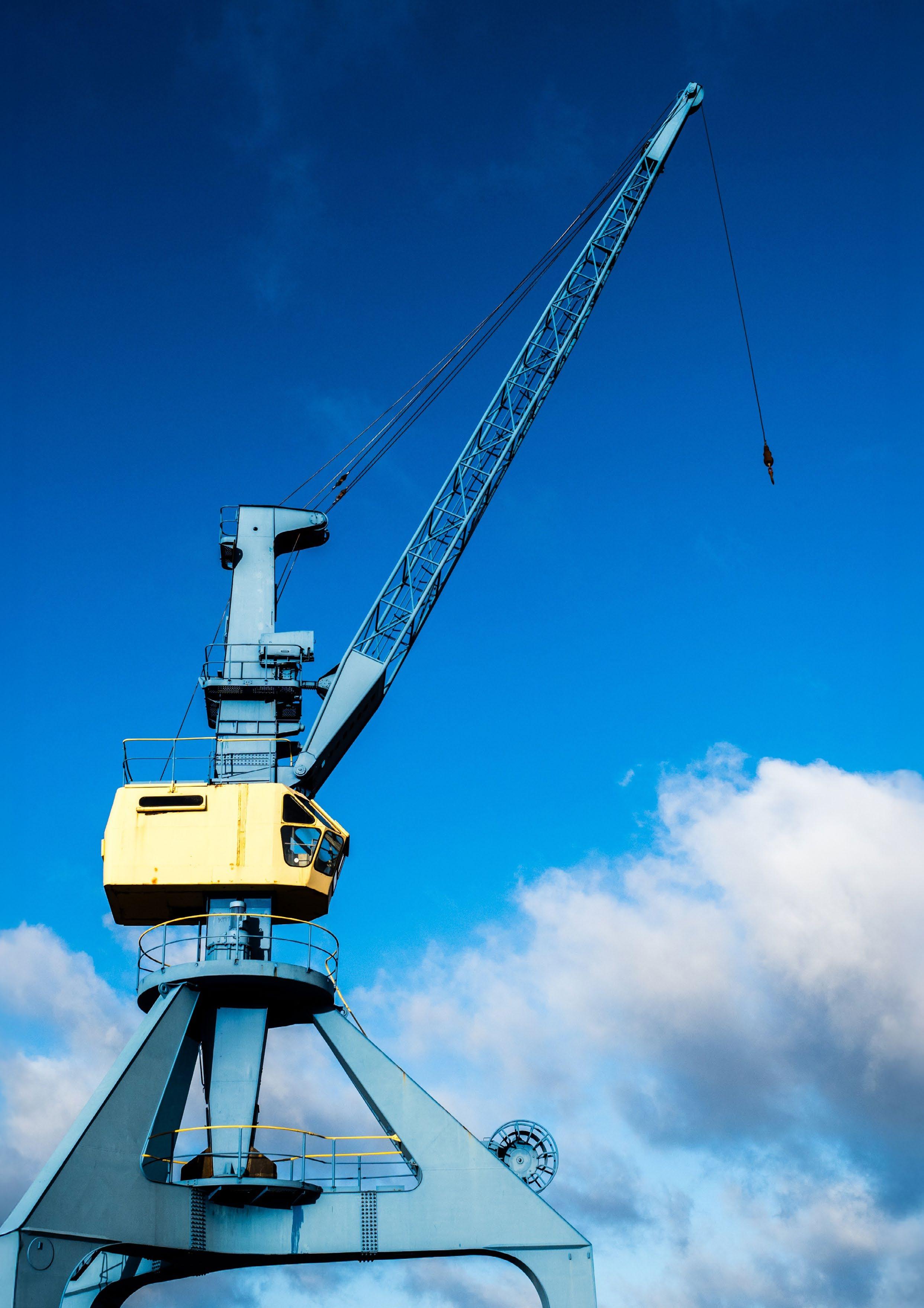
From state-of-the-art equipment to streamlined rail links, ports are employing myriad ways to load and unload ships swiftly and efficiently
Bruks Siwertell has secured an order from Italian construction materials specialist Calme SpA for the delivery of a new next-generation Siwertell 10 000 S road-mobile ship unloader. It will also be undertaking the refurbishment of a pre-owned Siwertell 10 000 S unloader, originally delivered in 2014, which will be upgraded to the same advanced, nextgeneration standard.
“Calme opted for our Siwertell roadmobile ship unloaders as we have a great track-record in similar cement handling applications,” says Jörgen Ojeda, Sales Director Mobile Unloaders, Bruks Siwertell. “We could also deliver on a tight schedule and offer robust technical support.
“Sustainability is a top priority for Calme. This order reflects the company’s ongoing aim to invest in advanced technologies and environmentfriendly solutions.”
At their undisclosed location, the units will face challenging operating conditions, including high humidities and an abrasive, dusty atmosphere. “Siwertell road-mobile ship unloaders are specifically engineered to handle such demands and do so with reliability, agility, outstanding through-ship performance, and market-leading efficiency and environmental protection; the pair are an ideal fit,” Ojeda says.
The decision to upgrade the preowned road-mobile unloader to nextgeneration technology means that both units will benefit from advanced digital solutions and an integrated communications system that enables remote access, troubleshooting and support. This can be further upgraded in the future if the owners want to take advantage of Bruks Siwertell’s latest service support packages, which include the use of an augmented reality kit.
Both trailer-based, diesel-powered units will offer a rated cement handling capacity of 300t/h, discharging vessels of up to 10,000 dwt, and have a doublebellows system for efficient material discharges. They are fully enclosed, eliminating spillage and minimizing fugitive dust, and are scheduled for delivery by mid-October 2025.
Bruks Siwertell has also received a new Siwertell ship loader order from Akcansa, one of Turkey’s principal cement producers. The ship loader will handle both cement and clinker at Akcansa’s largest facility in Çanakkale, northwest Turkey.
Per Hansson, Operations Director, Bruks Siwertell, says: “This is a prestigious project and our involvement in it is testament to our ability to offer value in dry bulk handling, compete successfully
in international markets, and create and strengthen long-term partnerships with customers. The contract also demonstrates that hard work, and a focus on export markets, delivers results.
“We are delighted to bring our innovation and quality engineering to this exciting development. The order is a market breakthrough for the Siwertell type-2 ship loader; a true piece of value engineering. The installation will showcase its remarkable capabilities, demonstrate its commercial advantages, and open doors to new opportunities.”
Akcansa’s port terminal facility in Çanakkale has an annual total production capacity of 10 million metric tons, and the ship loader will play a crucial role in doubling production capacity at the plant, ensuring smooth and efficient operations for years to come.
Designed specifically for handling cement and clinker, the Siwertell type-2 ship loader delivers a rated capacity of 1,000t/h, accommodating vessels up to 60,000 dwt. The loader is equipped with a belt-type conveyor system, selected for its high capacity, flexibility, durability and low maintenance requirements. The scope of delivery also includes a tripper arrangement, seamlessly integrating with Akcansa’s planned jetty conveyor.
This latest contract strengthens Bruks Siwertell’s existing relationship with
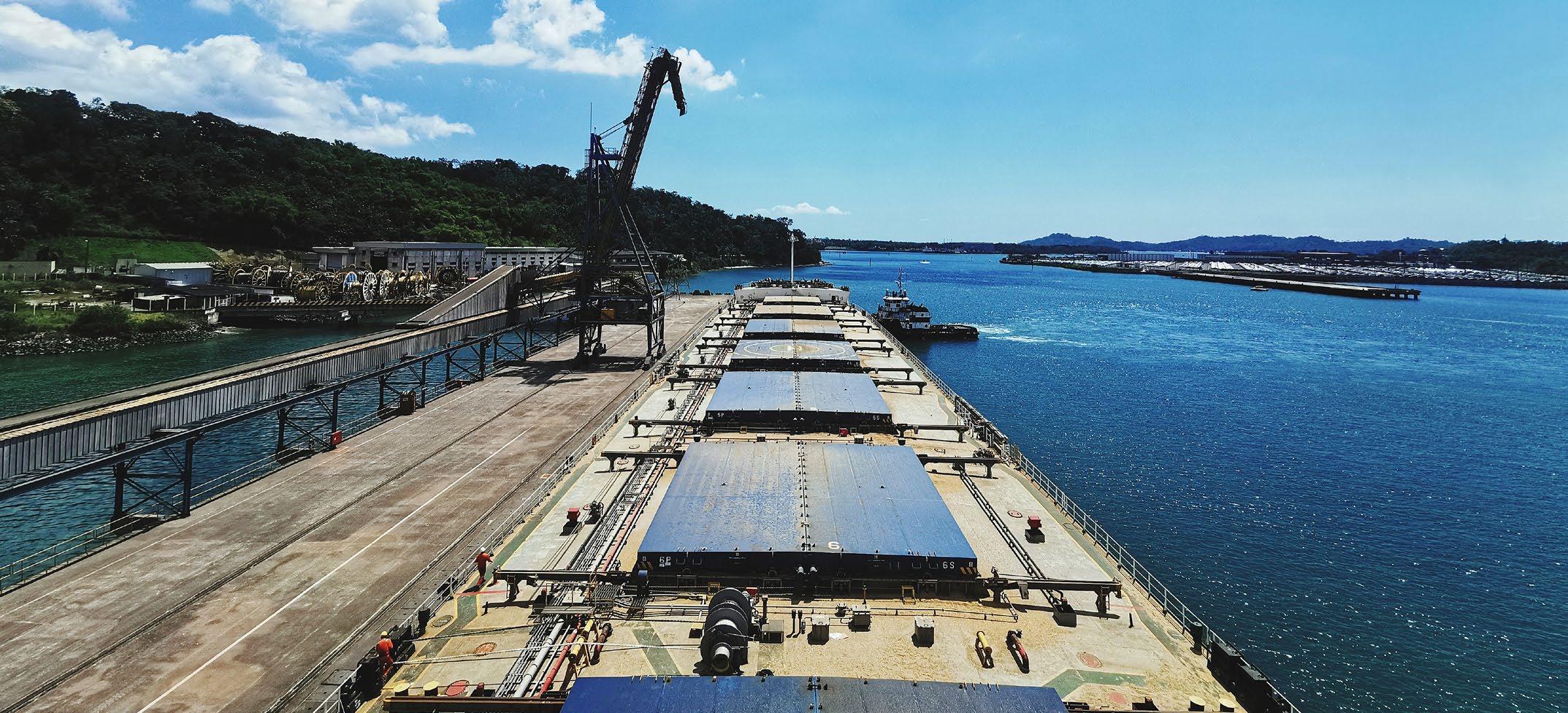
Akcansa, where the company already operates one other Siwertell ship loader in Çanakkale, which was delivered in 1992, and a 490 F-type Siwertell ship unloader and terminal in Ambarli, delivered a year later in 1993.
“Akcansa has been operating our dry bulk handling systems for over thirty years and trusts our technology,” says Hansson. “The selection of our Siwertell type-2 loader underscores this confidence and our ability to deliver reliable, market-leading solutions that set the benchmark for quality, and drive efficiency, performance and sustainability in cement and clinker handling.”
Akcansa chose Bruks Siwertell’s solution following an extensive evaluation of four different Siwertell ship loader concepts. The deciding factors included the loader’s low-power consumption, fully enclosed and dustfree operation, and ability to handle two very different commodities, cement and clinker, efficiently. The system’s telescoping and dust-mitigating loading bellow, suitable for both cement and clinker, further enhances environmental benefits, while its minimal maintenance requirements ensure longterm cost-effectiveness.
The contract includes a comprehensive two-year service agreement, which covers all the machines in both the Çanakkale and Ambari facilities, and the new ship loader features Bruks Siwertell’s advanced digital technology, the industrial Internet of things (IIoT) system, Siwertell SmartView.
“This service agreement provides substantial added value for Akcansa, strengthening our partnership and Bruks Siwertell’s commitment to long-term customer support,” notes Hansson.
The integration of Siwertell SmartView into Siwertell technology represents a significant step toward digitalised bulk handling. This cloud-based IIoT system enables real-time monitoring of operational parameters such as material throughput, equipment performance, and maintenance needs. It allows Akcansa to optimise productivity,
minimise downtime, and enhance overall profitability through datadriven insights.
“The introduction of Siwertell SmartView brings our expertise even closer to customers,” explains Hansson. “By providing historical data analysis and real-time operational monitoring, we empower customers to identify areas for improvement, ensure efficient terminal operations, and enhance training programs. This level of connectivity is transforming the industry.”
The new ship loader is planned for delivery in the first quarter of 2026, and will be accompanied with a five-day training program during commissioning to ensure a smooth start-up and optimal ongoing performance.
been introduced in response to growing volumes at DP World London Gateway – where a £1bn expansion began in May to increase capacity at the Port – and reflect Maritime’s continued investment in expanding its rail network and infrastructure, improving inland connectivity and driving modal shift across key UK routes.
‘London Gateway is seeing strong growth in container volumes, supported by its role in the Gemini Cooperation’s Asia–Europe network and a major expansion project that will further strengthen its position as one of the UK’s leading deep-sea ports,” says John Bailey, Managing Director – Intermodal, Maritime Transport.
“As throughput increases, so too does the need for reliable inland connections. These new rail services provide the additional capacity needed to support that growth, enhance our national network, and enable a more meaningful shift from road to rail as part of a lower-carbon, more efficient UK supply chain.”
These new rail services provide the additional capacity needed to support growth and enhance our national network
Maritime Transport, the UK’s leading provider of integrated road and rail freight logistics, has launched two new intermodal rail services connecting DP World London Gateway with its inland terminals at Hams Hall and iPort Doncaster.
Running Monday to Saturday, the new services are operated in partnership with GB Railfreight. Both services have
Maritime plans to introduce additional services, expanding connectivity between major UK ports and its network of nine strategic rail freight terminals.
New routes currently in development include Felixstowe to Manchester, DP World London Gateway to the East Midlands, and Southampton to Maritime’s SRFI at SEGRO Logistics Park Northampton – the latest addition to the company’s growing rail terminal portfolio, which is now fully integrated into the national rail network.
Julie Garn, Intermodal Director, GB Railfreight, says: “Rail plays a hugely important role in our national supply chains. In addition to driving our economy, moving goods by rail reduces emissions and supports the UK’s transition to more sustainable transport. Using rail freight reduces carbon emissions by c.76% compared to road.
“These new services are a great example of what long-term collaboration can achieve, delivering practical, lowercarbon alternatives to road that benefit the wider supply chain.”
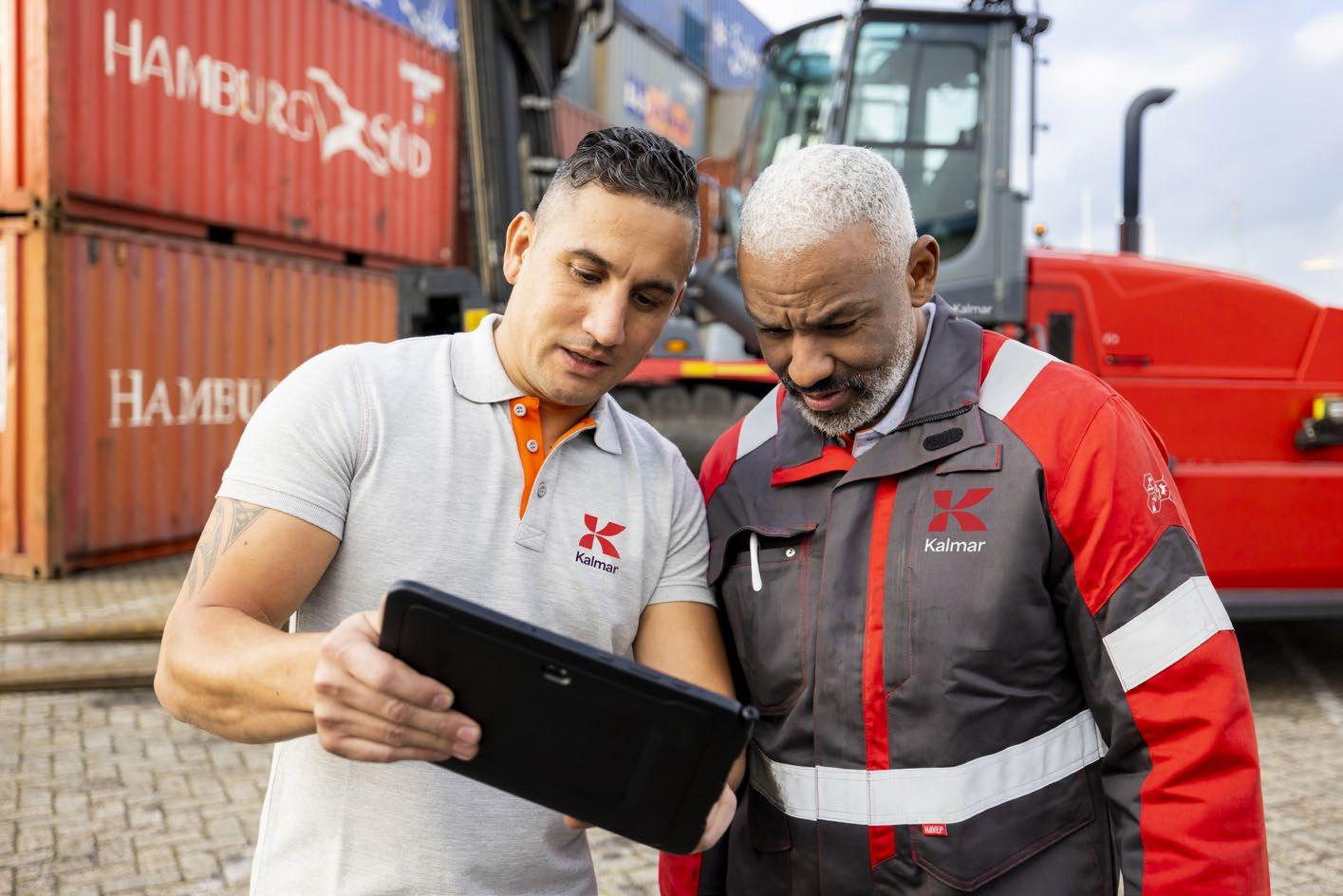
Kalmar has announced the launch of Inspector, a digital inspection application to streamline routine inspections of material-handling equipment.
Inspector, part of the MyKalmar ecosystem, makes equipment inspections more efficient and allows inspection data to be stored centrally for analysis and reporting purposes.
The application is available as both a standalone mobile app and as an optional module for customers with a valid MyKalmar Insight subscription.
Timely, regular inspections of material handling equipment are critical to ensuring safety, optimal performance and compliance with company health and safety practices and relevant local regulations.
With Inspector, users can document inspections accurately, store data digitally and more easily identify and record maintenance needs.
Users can complete a checklist of customisable inspection questions, add notes and attach images and video and audio clips. Data is saved centrally and a summary can be shared with relevant personnel such as fleet managers.
For example, the checklist can include prompts to inspect the oil level and looking for signs of oil leaks, examining the condition of the tyres and checking tyre pressures. The standalone Inspector
is easy to use on any equipment (Kalmar or third-party) as it requires no connectivity or hardware installation.
“Inspector provides users with a fully customisable mobile application that makes the process of performing inspections, recording results and sharing inspection-related data faster, easier and more reliable,” says Kalmar’s Director of Digital Services, Alina Reinhold.
“Furthermore, with full visibility over inspection-related data, fleet managers can improve maintenance planning and execution, positively impacting overall fleet reliability.”
SC has officially opened its new Medlog Inland Terminal Paris-Bruyères. This innovative, multimodal platform provides a direct link between the port of Le Havre and inland destinations across Europe. By efficiently combining road, rail and barge transportation, it helps customers streamline deliveries and cut carbon emissions.
Located just 40km north of Paris, this 11-hectare hub began operating in late 2024. It offers a wide range of logistics services, including container maintenance and repair, storage and reefer (refrigerated) services for the agrifood and pharmaceutical industries. It is also equipped to handle breakbulk and project cargo.
Featuring a two-track rail terminal and 230-metre-long river quay, cargo can travel in and out of the platform via road, rail or barge, ensuring smooth door-todoor deliveries.
With an annual capacity of 100,000+ TEUs, this scalable facility will boost productivity and economic development in the Île-de-France region: a key area for national and international trade in France and beyond.
More than 300 customers, partners and local officials attended the inauguration ceremony, which included guided tours and live performances. Guests also had the opportunity to learn more about multimodal logistics and MSC’s sustainability journey through an immersive VR experience.
The terminal provides optimised infrastructure, with only last-mile connectivity performed by trucks. This not only improves the flexibility of MSC’s network; it also reduces emissions and congestion, in line with the company’s commitment to enabling logistics decarbonisation.
Key benefits for customers include:
» Direct connections to/from Le Havre Port
» Shorter transit times
» Cost-efficient multimodal solutions
» Reduced carbon emissions
» End-to-end support with MSC as the single point of contact
The project is part of a wider investment programme, the TN MSC Port 2000 project, led by Terminal Investment, MSC’s port-operating arm. The aim is to connect local and global markets more efficiently through Le Havre port, supporting economic growth while building resilient supply chains with a reduced environmental impact.
Salvatore Prudente, Executive Director of MEDLOG, says: “It is natural that, when the opportunity arises, we invest without hesitation in this type of well-located and multimodal terminals, in order to better serve our clients through closer proximity to their facilities; thereby ensuring a more streamlined, regular, and reliable service, while also reducing the carbon footprint associated with the transport of containers and goods.”




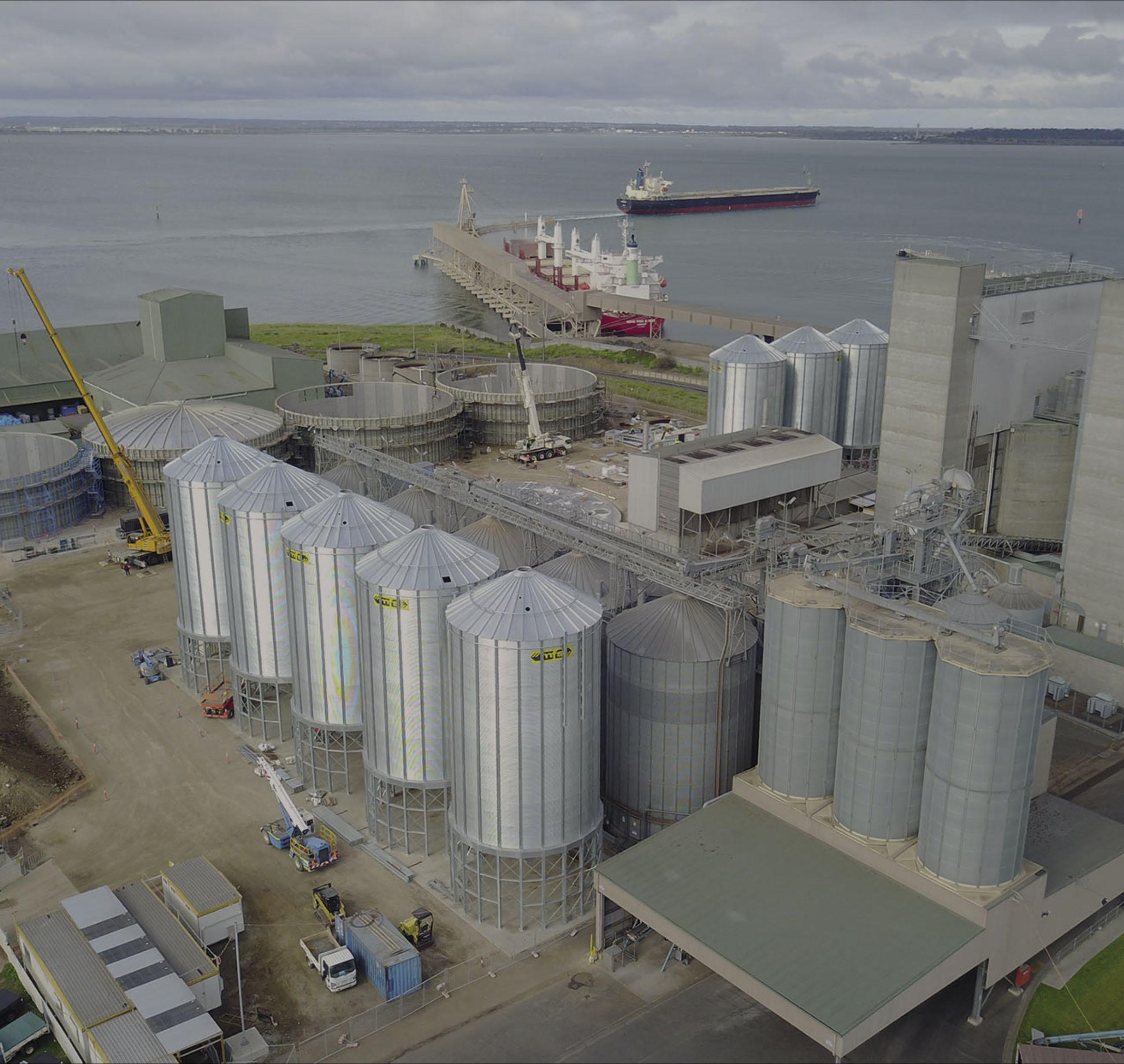

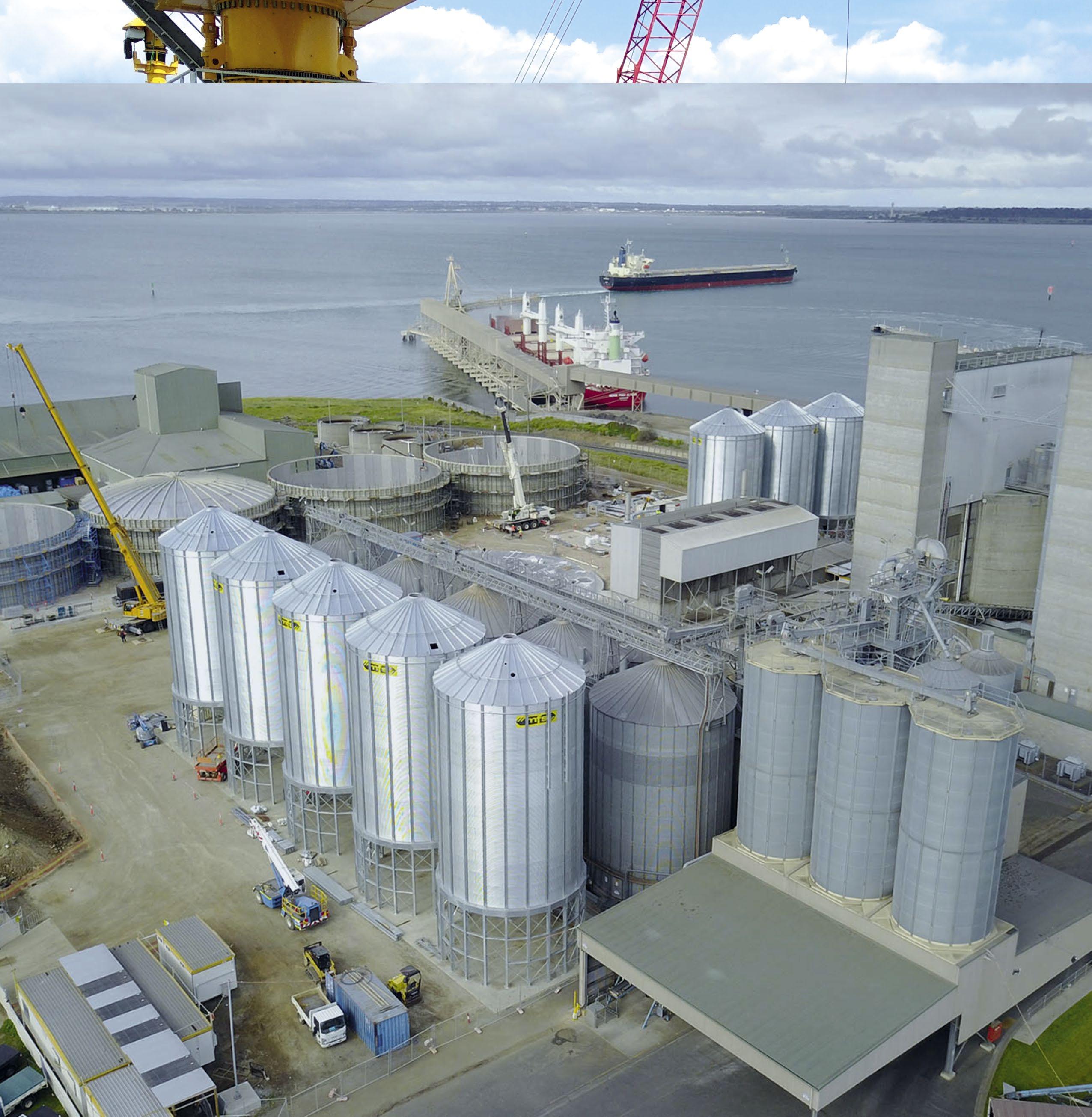
With operations across the UK, Europe, North America, Asia, and Australia, the MHA Group supports terminals worldwide with bulk handling solutions.

• Up to 1500+ Tonnes Per Hour
• Chain, Screw & Belt Conveyors
• Bucket Elevators
• Slide Valves, Diverters & more
• ATEX & IECEx compliant systems
• Global delivery. Local expertise.






From concept to commissioning, MHA Group delivers where it counts in the world’s toughest terminal environments. Talk to our bulk handling specialists today. enquiries@guttridge.co.uk www.guttridge.com
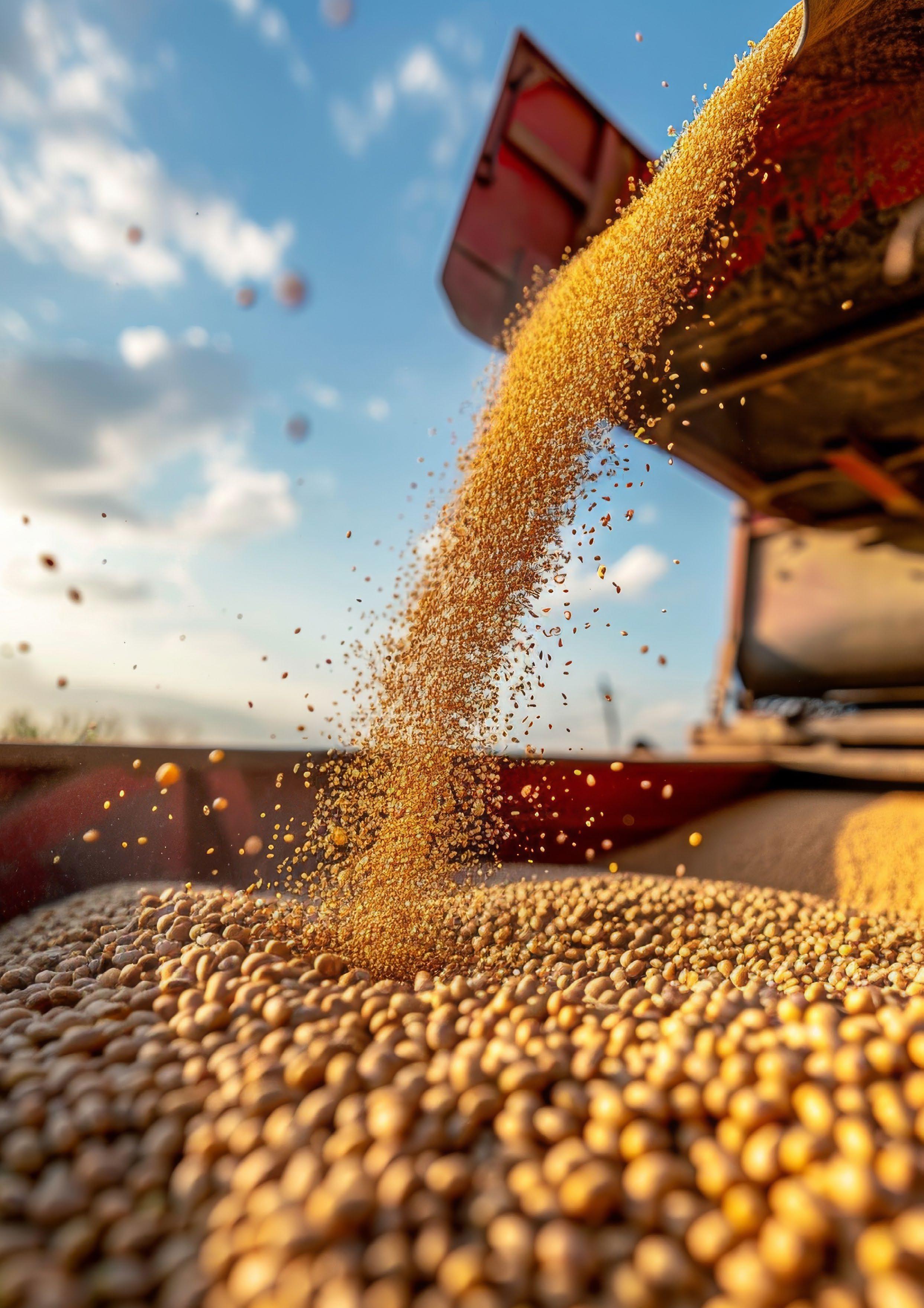
The EU’s uneven wheat production is forecast to rebound over the coming year, plus Ukraine’s grain boost and US storage enhancements
The EU’s wheat production is likely to rebound in the marketing year 2025-26 (July-June), although the output recovery is expected to be uneven due to dryness in key growing regions, according to S&P Global.
Diverse weather conditions across the bloc have resulted in a mixed production outlook. Ongoing dryness in northern and Central Europe – especially in major producers such as France, Germany and even the UK – has negatively impacted yield potential. Crop conditions in these regions continue to fall short of expectations, dampening hopes for a full recovery.
As of 9 June, 70% of French soft wheat was rated in good to excellent condition, according to FranceAgriMer data, a slight increase from 69% in the previous week.
In contrast, the southern and eastern parts of the EU have benefited from more favourable rainfall. Countries including Spain, Romania and Bulgaria are on track to deliver strong harvests this season, supported by improved soil moisture and better growing conditions.
Despite the differences, total EU wheat production is expected to reach 135.6 million mt in the MY 2025-26, up from 120 million mt in the previous year,
according to S&P Global Commodity Insights analysts’ forecast. Meanwhile, the USDA’s projections stand at 136.6 million mt, up from 122 million mt in MY 2024-25.
Production optimism is bolstering expectations for an increase in wheat exports in MY 2025-26 compared to the previous year.
Commodity Insights has forecast EU wheat exports at 33.5 million mt, up from 26.3 million mt in MY 2024-25, while USDA sees exports at 34.5 million mt, up 30.2% year over year.
Additionally, traders from Eastern Europe believe that the end of the EU-Ukraine free trade deal will enable them to increase grain exports within the EU.
The EU reinstated pre-war duties and quotas on Ukrainian agricultural goods as of 6 June, following nearly three years of tariff-free access. Discussions are ongoing between Brussels and Kyiv to establish a new, long-term agreement.
According to the European Commission, Ukraine’s share of EU wheat imports was about 62% and corn imports were about 57% in MY 2024-25.
Demand for EU wheat is anticipated to remain stable in its primary export
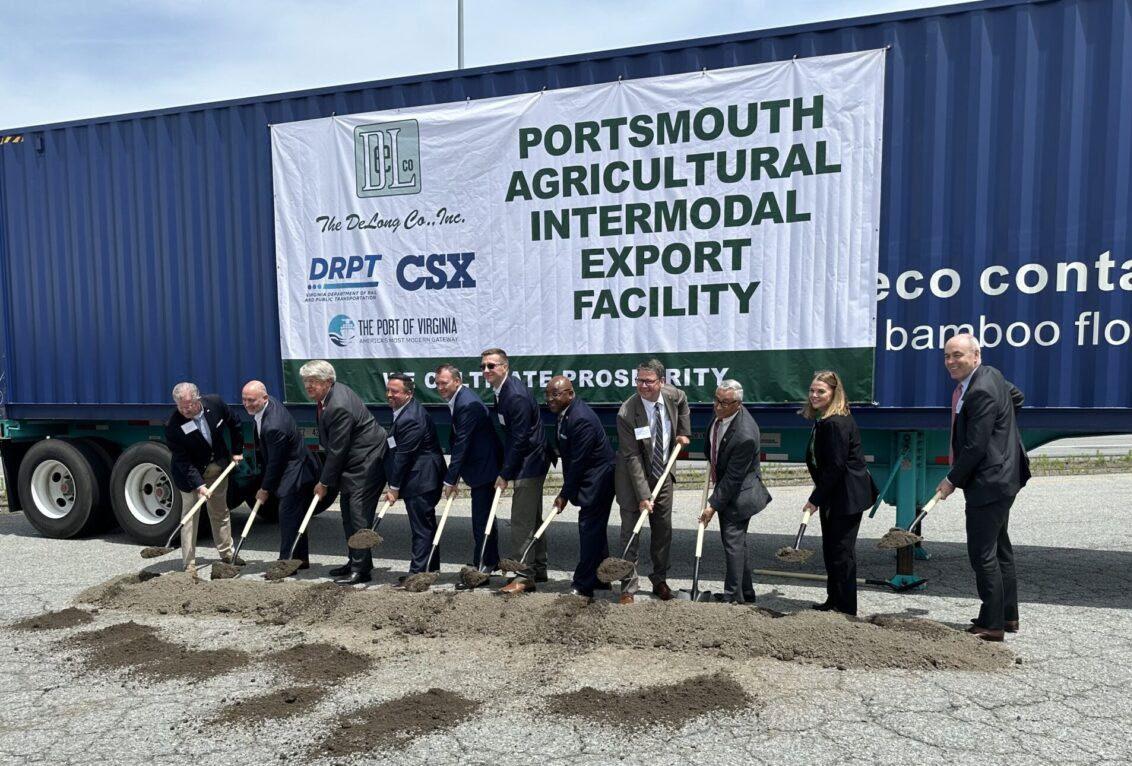
market –the Middle East and North Africa (MENA) – in MY 2025-26. Morocco, in particular, is experiencing a second consecutive poor wheat harvest, leading to expectations of continued strong import demand.
Wheat demand in the broader Middle East is likely to remain strong.
Louis Dreyfus Co (LDC) has been selected by the Ports of Indiana to reopen its Burns Harbor grain export facility on Lake Michigan at Portage, Indiana, US.
LDC is expected to begin operating the terminal in early 2026.
The Burns Harbor grain terminal enabled exports of more than 500 million bushels of corn and soybeans between opening in 1979 and closing in 2023, according to Ports of Indiana.
“LDC is excited to join forces with Ports of Indiana, whose commitment to growing the Midwestern economy is aligned with our own, longstanding growth journey in the state,” says Gordon Russell, US head of Grains and Oilseeds for LDC. “Burns Harbor is well-positioned at the southern shore of Lake Michigan, with access to multiple regional grain markets. The port will be a strategic asset for LDC to expand market access for regional farmers and serve customers in North America and abroad.”
Northern Indiana possesses the largest US port with access to the Great Lakes, St. Lawrence Seaway and US Inland River System, and it also provides multimodal connections to 16 railroads in the greater Chicago, Illinois market. The port’s grain operation includes storage capacity for 7.2 million bushels of grain, 200 railcars and 20 barges.
“We’re very pleased to partner with LDC to revitalise one of the most important agricultural shipping facilities in the state,” says Jody Peacock, Chief Executive Officer of the Ports of Indiana. “Combining LDC’s extensive resources with one of the most robust grain export facilities on the Great Lakes provides critical access to global markets for regional farmers. This is one of only a few places in the Midwest where you
can load one million bushels of corn on to an ocean vessel for export while simultaneously unloading an 85-car unit train and hundreds of semi-trucks from local farmers.”
Established in 1961, Ports of Indiana is a statewide port authority operating three ports on the Ohio River and Lake Michigan while annually contributing $8.7bn to the state economy and supporting about 50,000 jobs.
Ryan McCoy, Director, Ports of Indiana, says the global grain origination and processing network portfolio of Rotterdam, Netherlands-based LDC would support the port’s export growth and expand its reach across the agribusiness value chain.
“This terminal is one of the leading export facilities in the Midwest, with the capacity to load up to 90,000 bushels per hour into an ocean vessel or laker and unload 30,000 bushels per hour from a unit train,” McCoy says. “LDC’s investment will sharpen its competitive edge and help our region expand its multimodal capabilities and grow global trade.”
Almost two-thirds of the freight volumes handled by Chornomorsk Commercial Sea Port since early 2025 were grain exports, said Viacheslav Bezruk, the newly-appointed Director of Chornomorsk Commercial Sea Port State Enterprise, in an interview with Ukrinform.
According to Bezruk, some areas of the port’s activities have had to be reoriented due to the seasonal decline and general slowdown in freight traffic flows in the region.
“We have focused on what is critical for Ukraine’s economy, namely ensuring stable food exports Bezruk explained in the interview. “Traditionally, the basis of freight traffic here is grain, a strategically important commodity not only for our state, but also for the global market. In the first four months of 2025, a total of 1.3 million tonnes of cargo was handled, of which 826,000 tonnes were grain crops. This is almost 64% of the total transshipment volumes,”
According to Bezruk, Chornomorsk
Port – one of Ukraine’s most strategic maritime hubs – will continue to focus on the development of bulk cargo handling as one of its key.
Given the increasing role of Ukraine as an agrarian state and an important supplier of raw resources to global markets, expanding the capacity in this segment is not only strategically important but vital, he said.
Grain storage has received a significant boost on the US East Coast as DeLong, in partnership with the Port of Virginia, the Virginia Department of Rail and Public Transportation, the CSX Railyard and the City of Portsmouth, celebrated the groundbreaking of the Portsmouth Agricultural Intermodal Export Facility, in Virginia
Representatives from the agricultural group were joined by Portsmouth Mayor Shannon Glover and US Representative Bobby Scott, Virginia Secretary of Agriculture and Forestry Matt Lohr and Virginia Secretary of Transportation Shep Miller to mark this significant investment.
The new facility is slated for completion in early 2026 and will be the first on the East Coast capable of receiving unit trains and transloading agricultural products directly into export containers.
The innovative facility will offer 15,000 metric tonnes of storage and will handle
15,000–20,000 containers annually, significantly boosting the region’s export capabilities. Whole grains and feedstuffs sourced from local producers and the Midwest will be received by truck and rail, then shipped overseas via the Port of Virginia. The primary export markets include Vietnam, Indonesia, Thailand, Taiwan, and China.
“This project represents a major step in strengthening the economic, agricultural, and logistical landscape of Virginia and the greater East Coast to Midwest corridor,” says Brandon Bickham, Vice President of Exports at DeLong.
The $26m project is supported in part by a $750,000 Rail Infrastructure Access (RIA) grant from the Virginia Department of Rail and Public Transportation. The site is leased from CSX and operated solely by The DeLong Co.
Facility highlights – Phase 1
» Storage capacity: 15,000 metric tons
» Inbound modes: 90-car unit trains via CSX, truck
» Outbound: export containers via the Port of Virginia
» Annual export capacity: 500,000 metric tons
» Key commodities: soybeans, corn, wheat, DDGs, soybean meal
» Markets served: Asia
Phase 2 of the Portsmouth facility is currently in planning and will further expand storage and throughput capacity.
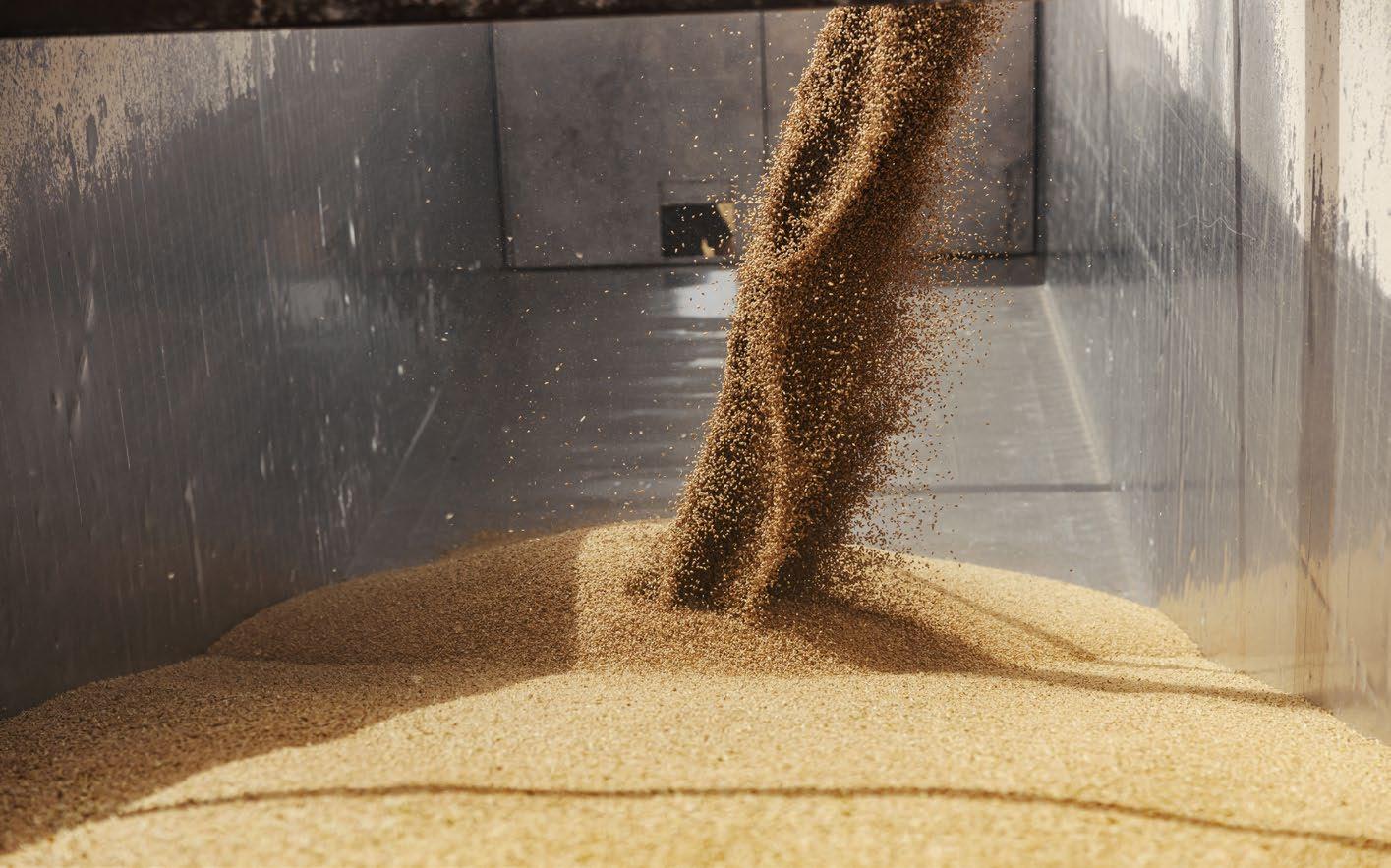
Grain terminals across the world play a critical role in the agricultural supply chain. These terminals handle not only grain, but a variety of similar bulk products. With ever-increasing demands for higher throughput, terminal operators face the challenge of moving cargo faster and more efficiently than ever before.
These solutions not only need to offer high throughput, but also minimise the risk of cross-contamination, reduce dust emissions, lower energy consumption and minimise waste. All of these are emerging priorities in terminal design and operation.
Along with throughput requirements, terminals must navigate complex safety challenges in ensuring that explosive atmospheres meet stringent compliance with ATEX and IECEx regulations to minimise risk to employees, the public and terminal sites.
Despite global trade pressures, agricultural trade, including container and bulk shipping, is still expected to grow. This is driving terminals to adopt evermore advanced bulk handling and storage solutions.
The MHA Group has worked with terminals globally to future-proof their operations by supplying proven bulk handling solutions tailored to some of the world’s most demanding environments.
MHA Group bulk handling equipment is engineered specifically to meet each customer’s performance, durability and on-site requirements. Through decades of experience, we have handled hundreds of different materials across many industries. This experience gives our team the knowledge they need to deliver proven handling systems for terminals worldwide.
Industrial knowledge and global experience is what sets the MHA Group apart. This understanding allows the team to design and build equipment that not only meets technical specifications, but is also practical, reliable, and optimised for real-world environments.
MHA bulk handling systems are designed for high-capacity performance, supporting operators in managing variable cargo flows without delays. Whether the requirement is 1,500 metric tonnes per hour or more, flow analysis forms part of every design to ensure product moves efficiently through the system with minimal restriction.
MHA’s solutions support terminals that need to handle a wide range of bulk products. Systems are designed for fast changeovers between cargoes, with features that minimise cross-contamination and reduce downtime between products.
Many terminals operate in spaceconstrained locations. MHA bulk handling equipment is engineered to help operators maximise available storage and handling capacity, delivering high throughput within compact site layouts.
Every MHA system is developed with health, safety and environmental standards in mind. From compliance with ATEX and IECEx regulations for explosive atmospheres to design features that help control dust emissions and provide safe access for operators, the MHA Group supports terminals in meeting their compliance obligations.
MHA bulk handling equipment is built for continuous, heavy-duty service. Systems are designed for straightforward inspection and maintenance, helping operators reduce downtime, maintain high uptime, and ensure smooth operations.
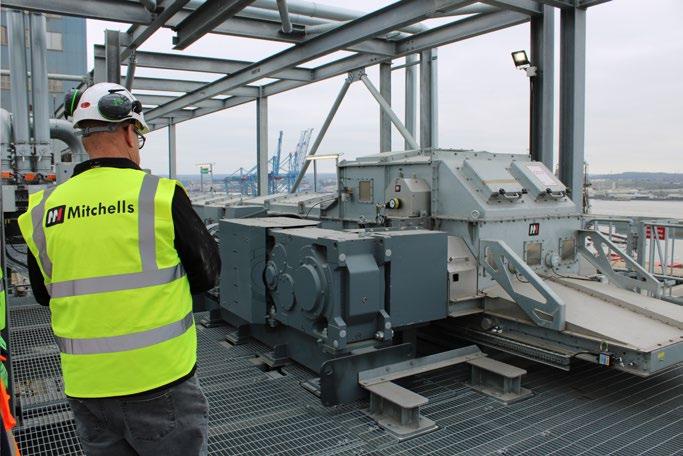
As part of a major expansion at Tilbury Grain Terminal, UK, Guttridge supplied a bulk handling system including more than 30 GTX chain conveyors (up to 1250mm wide and rated to 700TPH), a 48m HL1070 belt and bucket elevator, diverter valves and precision-controlled slide gates. Features such as telescopic tail-ends minimise residue and crosscontamination when switching between cereals, pulses, and oilseeds, supporting flexible cargo handling. ATEX-rated components, integration with full monitoring systems and integrated dust protection ensure safety and compliance across the terminal. The high-capacity, space-efficient system enables fast ship turnaround and reliable storage transfer between silos, strengthening Tilbury’s role as a key UK grain hub.
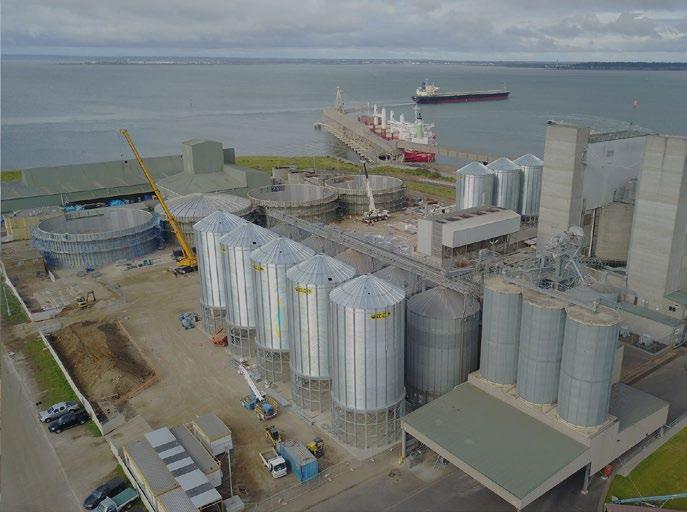
Allied Grain Systems delivered a complex silo storage expansion for Malteurop’s Geelong, Australia malting site, increasing capacity from 80,000 to 200,000 tonnes annually to create Australia’s largest malting facility. The project involved constructing 15 heavy-duty silos with driven pile foundations over challenging ground conditions, alongside the mechanical installation of bucket elevators, drag chain conveyors, belt conveyors, valves, and control systems. This large-scale upgrade was completed without any production downtime, thanks to meticulous planning and strict safety standards. The storage and handling infrastructure ensures reliable, continuous operation while supporting Malteurop’s business in the Asia-Pacific malting market.
A high-capacity bulk handling facility at Calaca Port, Phillipines supports grain
and soybean meal imports through a fully integrated receiving, storage, and outloading system. Two enclosed belt conveyor lines receive goods from the port at a combined 1200TPH, feeding into 12 enclosed belt conveyors (totalling 1500m), six bucket elevators, and 16 chain conveyors for silo distribution. A separate flat storage facility handles 600TPH loading via two bucket elevators, a chain conveyor, and two enclosed belt conveyors, including a 145m tripper conveyor. Fully operational since 2019, the site is consistently recognised as one of the Philippines’ highest-capacity grain handling terminals.
The MHA Group is a growing global group of bulk handling specialists, Guttridge (UK), Mitchells Asia, Mitchells North America, and Allied Grain Systems (Australia). With more than 60 years of combined heritage and industry knowledge, the Group delivers high-performance handling solutions for customers worldwide.
The Group designs, manufactures and supplies a full range of bulk handling equipment, including chain and screw conveyors, bucket elevators, belt conveyors, vertical mixers, live bins, bulk bag handling systems, and flow control components such as slide valves and diverters. It serves sectors from grain storage and animal feed to minerals, biomass and pharmaceuticals, from concept to commissioning.
The MHA Group does more than just supply equipment. From initial concept through to detailed design, manufacture, installation and commissioning, the MHA Group offers a complete service. This ensures that each bulk handling system matches site requirements, product characteristics and operating conditions. Closely working with terminal operators at every stage of the project helps minimise risks, control costs and delivers systems that perform reliably for decades.
As grain terminals face increasing pressures to do more while cutting costs, innovation has never been more important in bulk handling technology. MHA Group’s continuous investment in product development ensures that terminals benefit from the latest advancements, whether that’s enhanced wear protection for abrasive materials, energy-efficient drives that reduce power consumption, or dust control systems that contribute to cleaner, safer environments.
With offices in Europe, Asia, Australia and America, the MHA Group combines global capability with detailed local knowledge. Customers benefit from internationally proven solutions that are fully adapted to local regulations, climate conditions, and trade patterns. By drawing on the strengths of its specialist brands, the Group provides the right technology for any terminal – large or small, new build or upgrade.
As global trade continues to evolve, grain terminals must stay ahead by investing in bulk handling systems that combine efficiency, safety, and adaptability. The MHA Group’s decades of expertise and proven track record delivering solutions worldwide makes it a trusted partner for terminal operators looking to upgrade their operations.
If you want to ensure your terminal remains competitive and capable of handling the bulk volumes of the future, partnering with the MHA Group means investing in equipment and expertise you can depend on. Contact us to discuss how we can help you enhance your terminal’s bulk handling capabilities. For more information, contact: enquiries@guttridge.co.uk guttridge.com
In this special report by Fastmarkets, we examine the global iron ore market, a pivotal component of the steelmaking industry, which has historically been driven by simple supply and demand dynamics. However, steel trade tariffs, trade wars and a growing trend toward resource nationalism are reshaping this once-basic industrial staple. These forces, alongside rising environmental regulations and shifting trade patterns, are profoundly influencing iron ore pricing, production and consumption trends.
The global iron ore market was worth $279.35bn in 2023 and rose to $290.25bn in 2024, and is expected to reach $397.98bn by 2032. This reflects a steady annual growth rate of 4% over the forecast period. Here, we explore the complexities and challenges defining the iron ore market and the 2025 outlook for this indispensable resource.
Iron ore serves as the backbone of modern industrial economies. 98% of the global supply of iron ore is used for steelmaking, which supports a range of critical industries worldwide.
» Core industrial sectors: construction, automotive manufacturing, shipbuilding, heavy
machinery and infrastructure development depend heavily on iron ore for steel production.
» Downstream impacts: fluctuations in iron ore supply and prices have cascading effects on consumer goods, energy infrastructure and transportation networks, underlining the material’s strategic value across global supply chains.
The global reliance on iron ore makes it a resource of immense strategic importance, positioning it at the heart of debates on trade, sustainability and economic security.
Despite its foundational role in industrial economies, the global iron ore market is facing significant challenges. These
include geopolitical tensions, volatile pricing, environmental regulation pressures and a growing focus on decarbonisation.
Disruptions in global trade, including rising steel trade define defences and regional trade wars, have introduced significant volatility to the market. Highlights include:
» Iron ore price fluctuations tied to agreements: Fastmarkets has documented sharp price swings in response to evolving trade agreements or political shifts, resulting in uncertainty for buyers and sellers alike.
» Impact of new launch regions due to trade barriers: Geopolitical
tensions have spurred some countries to explore alternative sources of iron ore, raising the profile of new geographic markets. This decentralisation adds another dimension to pricing dynamics and regional competitiveness.
The emergence of resource nationalism, where governments exert greater control over mineral resources, is further complicating trade. Policy changes in iron ore-consuming regions, driven by trade tensions and domestic priorities, have led to adjustments in global supply chains. China is increasing reliance on alternative iron ore source, such as Africa.
Demand patterns for iron ore are evolving in ways reflective of broader industrial and economic shifts.
Weak domestic demand in China: while China remains the largest consumer of iron ore, its reliance on export-led steel production has grown due to weakness in its construction and real estate sectors. Finished steel exports increased by 6.3% in early 2025, underscoring this shift.
Evolving buyer preferences: low steelmaking margins have encouraged buyers to consume lower-grade ores and seek alternative blending strategies to manage costs and assure supply continuity.
Iron ore and steel producers are facing mounting pressure to decarbonise operations, a shift that is redefining processes and product demand.
Carbon Border Adjustment Mechanism (CBAM): policies such as the CBAM incentivise lower-emission production methods. These reshape cross-border trade flows for high-carbon products such as steel.
Electric arc furnaces (EAFs): the transition from traditional coal-based blast furnaces to EAFs, which rely on
recycled scrap and direct reduced iron (DRI), has fundamentally changed raw material requirements.
Rising demand for high-grade ores: low-carbon steel production processes require premium iron ore or direct reduction pellets (DR pellets). This drives increased demand for higherquality inputs.
Hydrogen-based steelmaking: steelmakers in Japan and Europe are pioneering the use of hydrogen DRI, replacing coal in steelmaking. This innovation is set to transform how iron ore is processed, fostering new trade routes linked to renewable energy hubs.

Supply chains for the global iron ore market remain vulnerable to geopolitical
conflicts and policy shifts. The heavy reliance on Australia and Brazil for iron ore has highlighted concerns about supplier diversification. All the while growing tensions among major trading blocs heighten the risks of sudden disruptions.
Navigating these challenges requires proactive strategies. Companies and industry stakeholders can leverage the following approaches to mitigate risks and seize opportunities:
Data-driven insights: comprehensive price tracking and trend forecasting offer firms advanced visibility into market shifts. They also help them shape informed procurement strategies.
Adapting pricing mechanisms: the introduction of tools such as the 61% Fe index provides more granular and flexible trading frameworks. These align with evolving buyer and seller needs.
Innovation investments: companies investing in green technologies, hydrogen-based steelmaking (hydrogen DRI) and high-grade ore processing will emerge as leaders in the future lowcarbon economy.
Looking ahead, the global iron ore market will be defined by a combination of opportunity and disruption. Resource nationalism, environmental regulations and geopolitical rifts will continue to reshape iron ore production and trade. Simultaneously, the rise of sustainable steelmaking practices (green steel) and shifting consumption patterns present pathways for growth.
Nonetheless, industry stakeholders will need to stay agile to address the vulnerabilities inherent in supply chains and trade dependencies. By focusing on technological innovation, sustainability and adaptive pricing strategies, the iron ore market can chart a resilient and prosperous course in 2025 and beyond. For more information, visit: fastmarkets.com
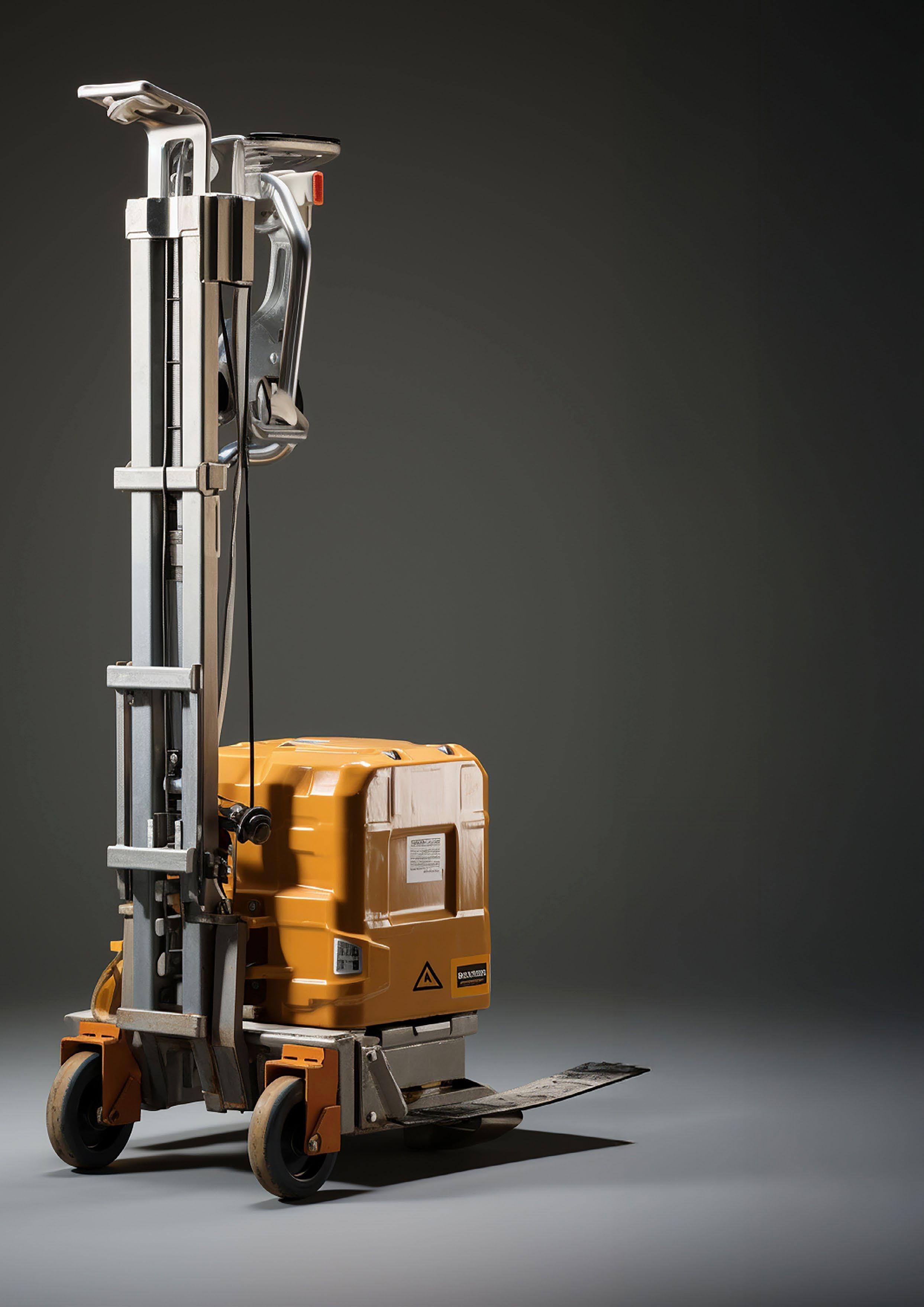
Ports are rising to the challenge of maintaining efficiency in often difficult circumstances with a host of innovative solutions, including Automation as a Service and AI-driven approaches
KR (Korean Register) has signed a memorandum of understanding (MOU) with HD Hyundai Samho to jointly develop artificial intelligence (AI)-based solutions for innovation in ship design and analysis.
This partnership is a part of a broader digital transformation strategy aimed at enhancing design productivity and strengthening the capabilities of ship design engineers in the rapidly evolving shipbuilding landscape. The collaboration focuses on leveraging artificial intelligence to build a more efficient and accurate ship design system.
The joint research initiative will focus on two core objectives:
» First, the development of an AI-powered optimisation and structural assessment solution for hull support arrangement. Traditionally, determining the placement of these supports requires complex and repetitive computational analysis. Through this collaboration, the process will be automated using AI, enabling optimal arrangement of supports and providing a user-friendly interface that shows real-time simulation results under various input conditions.
» Second, the development of an on-premise design verification system powered by generative AI. This system will be based on a large language model and will operate securely within the company’s internal network, in compliance with shipyard security requirements. By organising accumulated shipbuilding knowledge and streamlining work processes across multiple departments, the system is expected to enhance both technical expertise and operational efficiency throughout the shipyard.
KR and HD Hyundai Samho view this project as a starting point for the broader application of AI in ship design, and aim to expand the use of the core technologies developed to other areas of shipbuilding operations.
Shim Hak-mu, Executive Vice President of HD Hyundai Samho, says:
“This collaboration marks a pivotal step toward significantly advancing design efficiency and accuracy at shipyards through AI-driven automation. In particular, optimising the arrangement of hull supports with AI and introducing a secure in-house design system will ease the workload for design engineers while enabling more consistent and precise outcomes, ultimately enhancing overall productivity and quality.”
“This joint development project represents a significant turning point in modernising the ship design and analysis process using advanced AI technologies,” says Kim Daeheon, Executive Vice President of KR. “KR remains committed to developing a wide range of AI-powered services not only in classification work, but also across the broader shipbuilding and maritime sectors.”
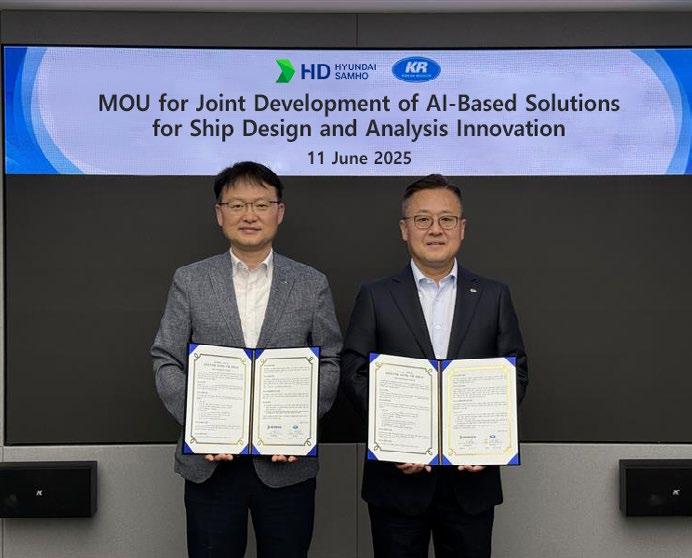
Cavotec, a global provider of electrification and automation solutions for ports and industrial applications, has launched PowerAlign – a new modular, mobile shore power solution.
PowerAlign is engineered to deliver safe, efficient, and reliable shore power connections – all while maintaining the operational flexibility container ports require. The system offers up to 140m of coverage from a single unit, with the option to extend reach by adding additional modules.
“PowerAlign is the result of our deep collaboration with port operators, shipowners, and terminal equipment manufacturers,” says David Pagels, CEO of Cavotec. “It brings a flexible, compact, and future-ready shore power solution
to container ports that are under increasing pressure to reduce emissions without compromising performance.”
Unlike fixed installations that can limit crane and cargo handling operations, PowerAlign keeps the quay clear thanks to its low-profile socket box and compact footprint of less than 3.5 m². The system’s enclosed cable reel, mounted at the quay edge, ensures extended cable life and minimal maintenance – a major advantage in space-constrained and high-traffic terminals.
PowerAlign’s key features:
» Compact and unobtrusive: occupies less than 3.5m² and integrates with existing quay layouts
» Extended reach: covers up to 140m per unit, expandable with additional modules
» Safe connections: complies with IEC 80005-1 and supports up to 16 kA/s
» Modular and adaptable: tracks install on the quay face or deck
» Optimised cable handling: protected reels extend cable life and reduce downtime
Whether implemented on new or existing berths, PowerAlign will help container ports meet regulatory and environmental targets while maintaining productivity and vessel turnaround times.
Kalmar has introduced Automation as a Service, a subscriptionbased model designed to ensure successful and efficient deployment of automation in marine container terminals and intermodal sites. The service focuses on accelerating timeto-value and building long-term performance-focused partnerships with automation customers
In an industry where operational efficiency and speed are paramount, the transition to automation can present challenges. Kalmar’s Automation as a Service model directly addresses these challenges by contractually separating equipment delivery and automation software deployment and related optimisation services.
This approach enables terminal and automation design to commence immediately through the creation of a digital twin – a virtual model of the terminal running on the same Kalmar One production software used in the terminal.
This model, combined with Kalmar’s decades of automation experience, allows for collaborative design and integration testing of systems well before the go-live date so that potential gaps in terms of functionality or operational requirements can be identified. This early identification and optimisation helps to ensure a high-performing automated terminal from day one.
Automating a container terminal involves far more than delivering the automation solution on site. Over its lifetime, the solution will need to be continuously optimised and improved, and this work should be done in close partnership between the automation system vendor and the terminal operator.
Automation as a Service ensures that the targets of Kalmar and the terminal operator are fully aligned, with jointly defined KPIs and performancebased contracting. With the correct tools and service model in place, Kalmar and the terminal operator can build a long-term partnership that delivers maximum value. Furthermore, Automation as a Service also reduces the high upfront costs related to automation investment by including automation delivery and related licenses as part of the service subscription agreement, hence shifting part of the CAPEX to OPEX
Juuso Kanner, Vice President, Automation Business Line, Kalmar, says: “Automation as a Service is about delivering long-term customer value throughout their entire automation journey. Shifting the focus away from short-term milestones towards accelerated time-to-value and continuous improvement throughout the terminal lifetime means we are better placed to act as a true partner for our customers, helping them to realise the full value of their investments.”
Saudi Arabia’s Port of Neom has taken delivery of the first fully automated, remote-controlled ship-to-shore (STS) and electric rubber-tyred gantry (eRTG) cranes in the country, advancing its goal to become a global hub for smart, sustainable trade.
The newly arrived state-of-the-art cranes will play a critical role in the port’s automation strategy, unlocking the potential for high-volume, highefficiency operations. Importantly, their remote-control capability allows for a future-ready workforce model, where operators can manage equipment from secure, ergonomic environments.
In parallel with its investments in infrastructure and automation, Port of Neom is also committed to developing local talent and training Saudi women to take on high-tech roles. Central to this effort is a pioneering initiative to train the next generation of production specialists to gain the skills to become remote crane operators, thereby helping shape a more inclusive future for the logistics and industrial sectors.
Ten participants from the Tabuk region are currently enrolled in an intensive two-year programmeP that blends technical instruction and hands-on training with dedicated mentorship.
Hajjer Alatawi, a trainee participating in the programme, says: “This experience has shown me that port logistics is far more complex than just moving cargo; it’s about teamwork, precision and responsibility. Seeing more Saudi women entering this space gives me hope for a future where industries are defined by skills, not gender.”
Innovative Chinese truckmaker Westwell has unveiled its next-generation E-Truck S2.
The E-Truck S2 is a fully electric, upgradeable, autonomous-capable heavy-duty vehicle, developed entirely in-house by Westwell.
Building on the success of its predecessor, the E-Truck S1, the S2 addresses legacy pain points such as
vibration, noise and emissions. Drivercentric features include an air-ride seat and a high-output overhead air conditioner, while a transmissionfree design and centralised lubrication system cut down on maintenance complexity and cost.
The advanced AI-VCU (vehicle control unit) uses multi-modal artificial intelligence (AI) algorithms to actively optimise performance, energy efficiency, and component longevity in real time –adapting to operating conditions, driving behaviour and system status to make the vehicle smarter with every mile.
A wheel-side reduction axle paired with air suspension and a V-type thrust rod helps absorb impact from container loads and improves roll stability by 25%. A dual-action hydraulic lift system powered by PTO streamlines loading cycles for faster turnaround.
The cab, measuring 1540 x 1550 x 1750mm, is designed for maximum space and ergonomic comfort.
Outfitted with high-capacity 282kWh and 310kWh LFP battery options, the truck delivers more than 16 hours of runtime on a single charge.
The E-Truck S2 runs on Westwell’s next-generation steer-by-wire chassis (2.0), which also powers the Qomolo autonomous platform – enabling a smooth path to driverless operation and future-ready scalability.
“The future of logistics is smart, sustainable and collaborative. AI is rearchitecting logistics infrastructure and environmental responsibility is no longer optional. Across seaports, airports, and freight networks, we’re seeing the rise of self-optimising, sustainable systems that are reshaping the global supply chain,” says Westwell President Zhang Rong.
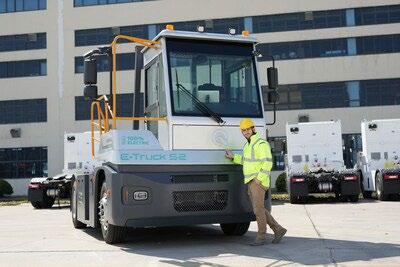
Andrew Dawes, Regional Director, Humber Ports

ANDREW DAWES, REGIONAL DIRECTOR, HUMBER PORTS
Q: You have a huge amount of experience in the maritime industry. What attracted you to this particular role?
A: I was coming home to the UK after almost 30 years of working in global ports and terminals with companies such as DP World, APM Terminals and International Container Terminal Services Inc (ICTSI). You can’t overlook an opportunity to join the UK’s largest port operator, with 21 ports, four of which in the Humber make up the largest UK port and see 58 million tonnes of cargoes come through the busiest UK trading gateway.
It’s mind blowing that 17% of the UK’s seaborne trade arrives in the Humber Estuary and so that opportunity to come here with such a range of opportunities, from cargoes from containers to biomass, dry bulks and liquid bulks, from seafood processing and consumables, to the future potential of green energies was something not to miss.
Plus, there are still opportunities for the ports to expand and enter new markets which is exciting, too. These ports have a national responsibility and we’re trading with Europe and beyond making our geographical location central to so many markets. We’re a key player in the Northern Powerhouse.
Q: What does a typical day look like for you?
A: Leading the biggest port in the UK demands a lot of pressure – if they were to close, the nation soon realises how dependent it is.
Day to day is ensuring that UK trade is moving – our mission is to keep Britain trading – and that’s making sure our employees and our partners in trade are, first of all, safe – safety is our number one priority – and ensuring the ports are running efficiently and ensuring that UK trade can reach its intended markets.
It’s the unknowns when they happen that proves how we can jump and be resilient. It’s all about the future needs of the nation – we can’t sit still and are constantly looking ahead. We look to the future needs of the industry and nation, and how we can support the energy transition – another one of our mission statements, and we are doing that in various ways by planning and being there at the table, and adapting to government policy. How do we support our neighbours at British Steel in their transition and what will cargoes look like? How do we pivot our operations to enable these transitions?
Q:What do you think has been the biggest change during your time in the industry that has affected port operators? And what change would you like to see?
A: The biggest change for me in the industry has been health and safety, undoubtably. When I started in the 1990s, it was like the Wild West! Most of our senior operational managers had fingers missing, or tips of fingers missing. We’ve made a move to put people first and ensure they can come to work, do a job safely and go home in one piece.
The other change has been the efficiencies that the industry has been able to handle – the big changes in vessel size and speeds of efficiency in cargo handling.
The changes I’d like to see are the ports’ ability to support the energy transition. Currently it’s untapped, but
Associated British Ports (ABP) has plans in place to do that transition, and that covers everything from offshore wind installation and ensuring we drive a scale and efficiency in that sector, to arguably lowering the cost to the UK consumer. The other is marine fuels – we can do more around green energy provision for ships alongside green molecules and the hydrogen sector – and carbon capture.
Q:What effect do you think artificial intelligence will have/ is having on port operations?
A:AI being used to enhance safety is important. The ability to use data to remove risks involving human interaction and cargo operations in operational areas, which means people can be safer, that’s a good way to harness AI – things like safe detection systems and using the data to make those changes where you potentially have the danger of people being in high-risk areas, but the technology can recognise it’s a human.
We look to the future needs of the industry and nation, and how we can support the energy transition
Q: What challenges do you see ahead for the Humber ports, in particular, and the wider ABP sites?
A: The ports are navigating a complex landscape of challenges, from environment to trade and economics.
The challenges are foreseeing and deploying infrastructure needs ahead of requirements – it’s capital intensive –and the planning takes two years, so we must speed up the planning process. There’s uncertainly around government direction, so they need to align their policy and understand that, but the private sector needs to react and deploy. It’s time critical.
Energy costs can be inefficient, but if we can deploy capital, not only will we achieve greater energy efficiency, energy costs and production cost efficiency, we will also deliver on the national ambitions for net zero.
Other good ways we can use it in port operations is in automation systems for container terminals to make efficiency; analysing marine traffic data to improve vessel planning and berth optimisation; improving port security by analysing sensors; and another where it helps is maintenance – analysing data and sensors to reduce downtime of kit and ensure efficiency and productivity.
Q:What are the future plans for Humber?
A:The Humber is keeping Britain trading as the UK’s busiest trading gateway. Humber Ports handle more than 58 million tonnes of cargo between them each year, worth approximately £75bn and include the Port of Immingham, which is the UK’s largest port by tonnage.
We know there is room for growth. The region’s ports provide fast, efficient access to both domestic markets and European trade routes, reducing lead times and logistics costs. We’ve got room to grow in the Humber, with some prime development land across our four ports.
There are opportunities for developing more river berths to accommodate larger vessels, enhance our competitiveness and improve our port capacity. It will allow for more efficiency and, with the Humber being a strong automotive handling port, then it can support that sector. This also contributes to lower carbon and freight costs to our importers and exporters –it’s our role in keeping Britain trading.
Then there are investments in electrification of ports – electric cranes, vehicles, and shore power – and how we support the greener shipping corridors. We have a part to play in that.
We are making strategic investment in new industrial and logistics opportunities to facilitate the continued growth of ABP and to maintain the Humber ports leading position in the UK, as well as significant investment in the region for jobs.
The Humber’s proximity to many of the UK’s main centres of manufacturing and distribution means our ports can better facilitate EU trade and offer more resilient access to export markets. A further advantage of our Humber ports is they enable a significant reduction in distances travelled by heavy goods vehicles, offering an opportunity to cut CO2 emissions to help tackle climate change.
Research by the University of Hull Logistics Institute found that by using the Humber instead of Dover, the average reduction in distance travelled to locations in the central east-west corridor of the UK – destinations such as Leeds, Doncaster and Manchester –was 178 miles, with an average cut in journey times of five hours 10 minutes and an average saving of 458kg of CO2e per load.
It showed moving just 10% of cargo from the Port of Dover to the Humber could save around 100,000 tonnes of CO2e every year when servicing these locations.
Our strength is in the diversity of cargoes handled and sectors we support, and there’s opportunities to look to new markets. We’re involved in many projects around carbon capture and storage, hydrogen production and green molecules.
More than 10% of the national energy supply is met with resources that come through the Ports of Immingham, Hull and Grimsby. The Port of Grimsby has become the largest hub in the world for supporting the offshore wind sector and there’s still room for growth here with land to bring more green energy suppliers in. Hull also plays a major
role in offshore wind with the blade manufacturing facility run by Siemens Gamesa in Green Port Hull.
Another exciting aspect of the Humber is the large availability of land that makes the region such an interesting proposition as a solution to the UK’s economic challenges and the drivers for trade. Opportunities such as the 453-acre development site –the Humber International Energy Park (HIEP) to the eastern end of the Port of Hull – are an enticing prospect for manufacturers and distributers.
We are in discussions with a third party for cold storage at this location. The Humber accounts for 15% of the UK’s total cold storage capacity, with a large percentage of on-port or adjacent cold storage space. This makes it one of the most concentrated and strategically important cold chain clusters in the country.
A lot of food products come through the southern ports, but it would make business sense to bring them direct to the Humber ports. The area already has a well-established local food sector and cold storage cluster. Local decision makers are familiar with the sector and the benefits it brings. The Humber Ports not only offer short-term alternatives, but a long-term advantage in terms of efficiency, costs and environmental impact to traders throughout the UK and EU bringing products in.
We recently acquired the long lease of Grimsby Seafood Village (see more on page 42). With more than 158,000 small and medium-sized enterprises
now thriving in Yorkshire and the Humber, this investment creates new opportunities for local businesses, strengthens the seafood supply chain and supports our customer ambitions.
It also complements our bold expansion at the Stallingborough Interchange – Helm@Immingham –where we’re investing in more than 227 acres to deliver state-of-the-art port logistics, green energy, and industrial space, ensuring ABP continues to keep Britain trading and ensuring UK goods reach foreign markets.
At that site, outline planning permission is currently pending determination for the development of a major automotive storage facility and a new site access, laying the groundwork for future automotive growth. This additional new-build project for business units is a priority within our low-carbon development strategy, with a clear commitment to building green.
As part of a broader strategy to ensure resilience and continuity in keeping Britain trading, some of our initiatives play a role in enabling the energy transition through its on-site provision of renewable energy.
And all of this is done, of course, with the idea that the local communities are going to benefit, with increased money in the local economy, people moving to the area and skilling up local workforces in those industries we’re supporting.
Our role is to ensure supply chain efficiency and keep Britain ahead of the curve.

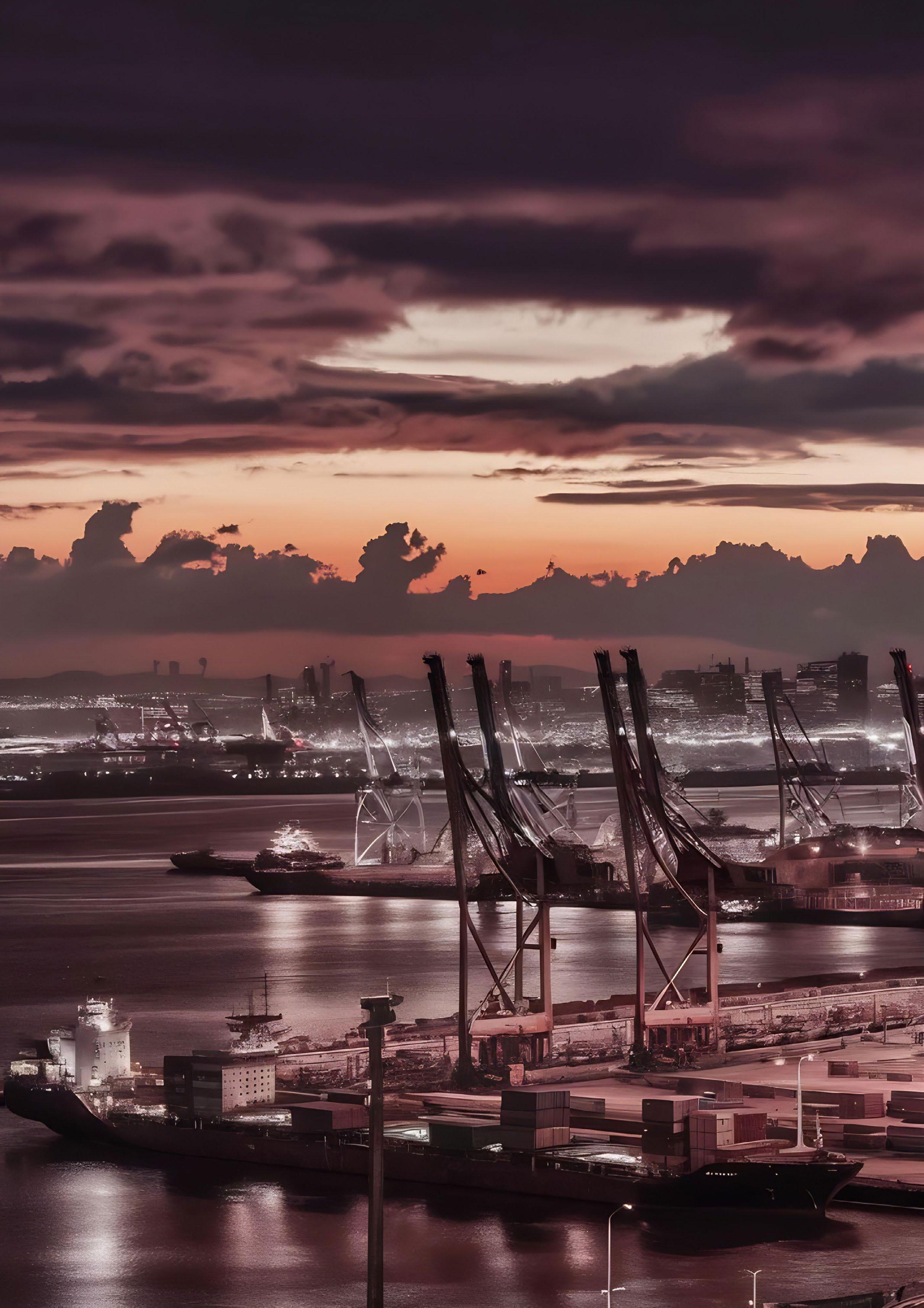
Proposed revisions to the National Policy Statement for Ports aim to streamline planning processes for ports in England
The Department for Transport (DfT) has set out proposed revisions to the National Policy Statement for Ports (NPSP), aiming to speed up planning processes and enable ports in England to deliver critical infrastructure more efficiently.
According to the DfT, the changes are intended to “streamline the planning process for ports in England” and provide clearer guidance on design and application requirements. This, the department says, will “expedite planning applications” by clearly outlining the current requirements for port facilities, thus guiding applicants in meeting the latest criteria, avoiding delays and supporting the delivery of “important national infrastructure more quickly”.
Established in 2012, the NPSP governs the development of nationally significant port infrastructure in England and Milford Haven in Wales, including associated road and rail links. The DfT says the update responds to “significant policy and economic changes that have led to structural amendments for port infrastructure since 2012”.
Parliamentary Under-Secretary of State at the DfT Mike Kane MP says: “Ports are the lifeblood of the UK economy, keeping the country moving and trading, and are vital in unlocking prosperity and opportunity for our coastal communities. We are determined to deliver the projects that will make a real difference to local people, turbocharge economic growth and create jobs as part of our Plan for Change.”
Industry groups have welcomed the move. Richard Ballantyne OBE, Chief Executive of the British Ports Association, says: “The ports industry is optimistic about its long-term future, with significant growth expected in trade volumes and other sectors such as offshore wind. A refreshed ports policy statement is welcome recognition from government of the value of port development and expansion to the UK’s future prosperity.
“We hope it will speed up planning processes, delivering on shared
industry and government economic growth ambitions.”
Claudio Veritiero, CEO of Peel Ports Group, adds: “Ports are the unsung heroes of the UK economy, and this is an extremely encouraging development. We have invested more than £1bn in the last decade and intend to exceed that level of investment in the coming years. We want to be able to invest for the future, creating jobs and opportunities right across the country and anything that streamlines that process and allows us to create conditions for economic growth is to be welcomed.”
Professor Chris Shirling-Rooke MBE, CEO of Maritime UK, also supported the proposal: “This will provide valuable support for our coastal communities. These regions represent a significant opportunity for economic growth and job creation, vital for strengthening our proud maritime nation.”
The public consultation will close on 29 July.
Associated British Ports’ (ABP), the UK’s largest ports group has extended its property portfolio with the acquisition of the long leasehold interest of Grimsby Seafood Village, a premier seafood processing centre.
The purchase provides future security and support for an important hub of UK food production.
The multi-let industrial site spanning over four acres is located on ABP’s Port of Grimsby in the Humber. The purchase of the long leasehold lasting 125 years, which ABP had previously granted to the owners of the complex, sees the acquisition add a new and highly complementary element to the Humber property portfolio.
The 70,000 sq ft site comprises 21 units with several fish processing businesses included.
Andrew Dawes, Regional Director of the Humber ports says: “The acquisition of the Grimsby Seafood Village enhances our property portfolio with a vital hub for the UK’s seafood supply chainsupporting regional jobs, boosting food security, and anchoring long-term
supply chain resilience in the heart of the Humber.”
Greg Lacey, Head of Property in the Humber adds: “With over 158,000 small and medium-sized enterprises now thriving in Yorkshire and the Humber, this investment creates new opportunities for local businesses, strengthens the seafood supply chain, and supports our customer ambitions.”
In the Humber region, approximately 6,000 people are employed directly in the seafood processing sector and it supports a wider supply chain of more than 10,000 jobs. The Seafood Village is Grimsby’s leading fish processing facility and experiences a consistent regional and national demand. 70% of the UK’s seafood is processed in Grimsby, making it a critical hub for national food security, which contributes an estimated £2bn annually.
ABP has also submitted a reserved matters application for 103,000 square feet of multi-let industrial and logistics space at its Helm@Immingham site as the first phase of development of this 227-acre strategic location.
This speculative development, ahead of occupier commitment, will provide a critical supply of new modern purposebuilt units and reflects ABP’s confidence in and vision for the GrimsbyImmingham area. ABP, which operates the ports of Grimsby and Immingham, is developing the scheme and retaining it within its property portfolio.
The location is close to the A180, leading to Grimsby and local motorway networks, and the two major Humber estuary ports. The units’ range in size from 4,820 sq ft to 26,797 sq ft and each structure will carry a clear internal height of 10m. The units will be targeted at small to medium-sized enterprises in energy venture startups, port logistics, manufacturing and distribution.
Helm @ Immingham can provide a further 1.1m sq ft of industrial space, along with 90 acres of automotive open storage with on-site renewable energy generation and extensive biodiversity improvements.
Verizon Business, Thames Freeport and Nokia have formed a strategic partnership to deploy Verizon Private 5G Networks across multiple key logistics, manufacturing, and innovation sites along the River Thames Estuary.
The Verizon Private 5G Networks will serve as the technology foundation for a multiyear, multibillion dollar operational transformation and economic revival for the region, one of the UK’s busiest maritime logistics hubs.
The Private 5G Networks buildout provides a scalable, long-term connectivity foundation for advanced data, artificial intelligence (AI), edge compute, and IoT infrastructure deployments aimed at transforming port and manufacturing operations.
The technological enhancements will play a direct role in boosting the local economy, underpinning job training and reskilling efforts as part of employment initiatives and supporting innovation and research and development collaborations among Freeport tenants and outside corporate, government and research entities.
Thames Freeport has already created 1,400 jobs and plans to reach 5,000 by 2030, with a focus on highly skilled training for local communities.
The Verizon Private 5G Networks will enable advanced data and application capabilities for AI-driven data analytics, predictive maintenance, process automation, autonomous vehicle control, safety monitoring, and realtime logistics orchestration. Nokia is the sole hardware and software provider for the networks, which will incorporate the Nokia Digital Automation Cloud (DAC) platform and Nokia MX Industrial Edge (MXIE).
The networks will be deployed at DP World London Gateway and DP World Logistics Park, Port of Tilbury and Ford Dagenham.
“Thames Freeport is developing one of the most technologically advanced commercial corridors in Europe to enable forward innovation and economic revitalisation for an entire
community,” says Jennifer Artley, SVP, 5G Acceleration at Verizon Business. “We’re not just driving operational improvements to help a partner stay ahead of the curve; we’re laying the groundwork for new revenue streams, community development, and further commercial and technological investment.”
“A flexible, high-performance connectivity platform is critical to our long-term vision,” said Martin Whiteley, CEO, Thames Freeport. “Our investment in private 5G is not an incremental network upgrade – it’s the backbone of a technological transformation fuelling our long-term multi-stakeholder mission.”
“This is one of the largest commercial private 5G rollouts in a European port incorporating the Nokia DAC platform. This network will allow Thames Freeport to overlay advanced use cases such as AI-driven data analytics, predictive maintenance, process automation, autonomous vehicle control, safety monitoring, and real-time logistics orchestration,” says David de Lancellotti, VP of Enterprise Campus Edge Sales at Nokia.
Peel Ports Group has officially unveiled its new £30m RoRo berth at London Medway, as it welcomed a key freight service to the facility.
The new in-river vessel berth and floating pontoon will boost capacity for RoRo cargo handling.
As part of the official opening, the port welcomed one of Finnlines’ new Finneco-class hybrid RoRo vessels – a regular feature of the weekly service connecting London Medway with Finland, Poland, Belgium and Spain.
This new freight route between Kent, Northern Europe and Continental Europe offers customers shorter transit times and more efficient loading and unloading operations, supporting faster and more reliable supply chains.
Richard Goffin, Port Director, says: “This major new addition to our infrastructure will bring huge benefits to the port and the wider supply chain, as well as future-proof our operations here
for many years to come. The new berth and its facilities will further improve operational efficiency and enhance flexibility for our customers.”
Finnlines launched its freight service in September, with further connections available to Belgium, Spain, and Ireland, which will be operated with three hybrid RoRo vessels.
With each vessel holding cargo capacity of 5,800 lane metres, equivalent to around 400 trailers, the service improves the route network, providing customers with shorter transit times and increased cargo capacity, as well as enabling faster and more efficient loading and unloading operations.
The new berth and pontoon will cater for RoRo vessels arriving at the port, carrying commodities such as automotives, paper reels and timber, construction machinery and building materials, project cargo, agribulks and steel.
In addition, Peel Ports Group and Medcem have partnered up to create a new cement import facility in Northwest England. The partnership will create a deep-water terminal at the former P&O site at Gladstone Dock, Liverpool.
Enver Celikbas, Business Development and Investments Director at Medcem, says: “This new terminal significantly strengthens our presence in the UK market. The logistical advantages of Liverpool allow us to enhance our ability to accommodate large vessels and product handling. This strengthens our supply chain, ensuring a more efficient and reliable service for our clients.”
“Logistics and construction are deeply interconnected, and by creating smarter, more sustainable import hubs like this one, we can help building firms secure the materials they need,” says Andrew Martin, Group Development Director, Peel Ports Group.
Completion is anticipated by mid2026. The initial phase will feature four silos with a combined storage capacity of 45,000 tonnes, designed to handle cement and supplementary cementitious materials (SCMs).

Multiple investment projects are taking place at India’s ports, which have seen a huge boost to traffic
India’s major ports handled 855 million tonnes of cargo in fiscal year (FY) 2025, 4.3% more than the 819 million tonnes they handled in FY 2024, and hit new milestones in operational efficiency and infrastructure modernisation, according to the Ministry of Ports, Shipping and Waterways (MoPSW).
The increase in traffic was driven by higher container throughput (10%), fertilisers (13%), petrol, oil and lubricants (3%), and miscellaneous commodities (31%) than in the previous fiscal year.
Petroleum, oil, and lubricants – including crude, petroleum products and liquefied petroleum gas/liquefied natural gas – led the charts with a volume of 254.5 million tonnes (29.8%) in FY25. It was followed by container traffic at 193.5 million tonnes (22.6%), coal at 186.6 million tonnes (21.8%), and other cargo categories such as iron ore, pellets and fertilisers.
For the first time in the history of major ports, the Paradip Port Authority (PPA) and Deendayal Port Authority (DPA) handled more than 150 million tonnes of cargo, reinforcing their status as key hubs of maritime trade and operational excellence, the ministry said.
From record-breaking cargo handling to significant improvements in operational parameters, the achievements of FY25 reflect the resilience and readiness of Indian ports
Meanwhile, Jawaharlal Nehru Port Authority (JNPA) set a record by handling 7.3 million twenty-foot equivalent units (TEUs), reflecting 13.5% year-on-year growth.
In FY25, Indian ports collectively allocated 962 acres of land for industrialisation, which is expected to have generated income of ₹7,565 crore over the fiscal year, the ministry said.
Lessees are expected to invest ₹68,780 crore on the allotted land in future.
Private-sector participation has been instrumental in this transformation, with investments in public-private-partnership (PPP) projects at major ports increasing threefold from ₹1,329 crore in FY23 to ₹3,986 crore in FY25, the ministry said. Operational performance continued to improve in FY25, with pre-berthing detention time (on port account) up around 36% from FY24.
Major ports saw an 8% increase in total income to ₹24,203 crore in FY25 from ₹22,468 crore in FY24. Operating surplus grew 7% to ₹12,314 crore in FY25 from ₹11,512 crore in FY24.
Sarbananda Sonowal, minister of ports, shipping and waterways, says: “I am immensely proud of the remarkable achievements of India’s major ports in FY25. The ministry has worked tirelessly to modernise port infrastructure, enhance operational efficiency, and foster private sector participation, paving the way for unprecedented growth in India’s maritime sector.
“From record-breaking cargo handling to significant improvements in operational parameters and financial performance, the achievements of FY25 reflect the resilience and readiness of our ports to support India’s growing trade ambitions.”
From FY15 to FY25, cargo volumes surged from 581 million tonnes to about 855 million tonnes, clocking a compound annual growth rate (CAGR) of 4%. Containerised cargo saw a remarkable 70% increase over the decade – from 7.9 million TEUs in FY15 to 13.5 million in FY25. Conventional commodities such as coal, fertilisers, iron ore and POL also saw significant growth over the past decade.
Productivity indicators also point to a significant improvement.
» Output per ship berth day (OSBD) rose from 12,458 tonnes to 18,304 tonnes over the decade.
» Average turnaround time (TRT) improved by 48%, from 96 hours in FY15 to 49.5 hours in FY25.
» Pre-berthing detention time (on port account) improved by 24%, from 5.02 hours in FY15 to 3.8 hours in FY25.
» Idle time (%) fell by 29%, from 23.1% in FY15 to 16.3% in FY25.
Major ports’ financial performance has been equally impressive over the past decade, with total income more than doubling from ₹11,760 crore in FY15 to ₹24,203 crore in FY25 at 7.5% CAGR. Operating surplus nearly tripled to ₹12,314 crore at a 13% CAGR over the same period. Operational efficiency also improved significantly, with the operating ratio falling from 64.7% in FY15 to 42.3% in FY25, reinforcing the ports’ financial sustainability.
India’s major ports are now poised to take their competitiveness to the next level, supported by continuous investment in mechanisation, process reengineering, port community systems, and multi-modal logistics integration, the ministry said. These initiatives have resulted in higher cargo volumes, reduced vessel wait times, optimised capacity utilisation, and increased investor confidence, it added.
Indian authorities have launched criminal case against the owner, master, and crew of the Singapore-flagged container vessel Wan Hai 503 following a major fire and explosion in the Arabian Sea that left four crew members dead.
The 9 June incident occurred while the vessel was en route from Colombo to Mumbai, approximately 78 nautical miles off the Kerala coast. Of the 22 crew members aboard, 18 were rescued from lifeboats, while four remain missing –including two Taiwanese nationals, one from Myanmar, and one from Indonesia.
The containership was carrying 1,754 containers, 157 of which were officially declared as dangerous goods. However, investigators suspect that other cargo, ambiguously labelled as ‘general cargo’, may have actually included hazardous materials that triggered the initial internal explosion.
Authorities are now focusing on whether the cargo in question was improperly declared or concealed to bypass safety regulations. If misdeclaration of dangerous goods is confirmed, severe penalties are expected for the shipping agents involved, given the loss of life and scale of the incident.
The incident resulted in fuel and oil leaking into the sea, with several containers also falling overboard. As of 14 June 14, the tow has been transferred to the tug Offshore Warrior, with the vessel located 35 nautical miles off the coast. It will be held at least 50 nautical miles from the coast pending further decisions.
In a significant boost to maritime infrastructure and seafarer welfare at Deendayal Port Authority (DPA), Kandla, Minister of State for Ports, Shipping and Waterways Shri Shantanu Thakur has launched multiple vital developmental projects at the port.
The initiatives are part of the broader vision of Maritime India Vision 2030 and the Amrit Kaal Maritime Roadmap (2047), aimed at building green, resilient and globally competitive ports while boosting India’s coastal economy and trade potential.
The projects include:
» New seafarer building at Kandla (cargo jetty area)
A modern, international-standard Seafarer Centre will be constructed to provide world-class amenities for seafarers arriving at the port. The facility will include a waiting lounge, shopping area, medical room, storage space, salon, music and yoga zones, gym, café, basketball court, covered swimming pool and landscaped garden — all designed to create a comfortable and rejuvenating environment for the seafaring community.
» Extension of Railway Line towards Berths 13 to 16
The existing railway infrastructure will be extended by 750 metres to connect Berths 13 to 16 with Kutch Salt Junction. This strategic rail link will enable smoother cargo evacuation and improve long-haul connectivity, especially with the upcoming Dedicated Freight Corridor (DFC), ensuring faster and more efficient logistics.
» Telescopic gangway at Oil Jetty No. 7
A new telescopic gangway has been installed to provide secure and efficient access between vessels and the jetty. This modern vessel access system adheres to OCIMF safety standards and is crucial for facilitating safer operations for crew and port personnel alike.
» Fire Brigade Station inside the Cargo Jetty Area
A dedicated Fire Brigade Station has been established within the port’s operational zone, complete with office space for fire and immigration staff and a 50KL underground water storage tank. This facility will significantly enhance emergency preparedness and safety at the port. These projects mark a transformative step towards operational excellence, enhanced multimodal logistics, and seafarercentric ecosystem aligned with global standards.
Shri Shantanu Thakur says: “The maritime sector is entering an era of holistic and inclusive transformation. The projects at Deendayal Port Authority are rooted in the spirit of Viksit Bharat @2047 modern, efficient, and people-first. The new Seafarer Centre is not merely infrastructure; it is a tribute to the resilience, dignity and contribution of India’s maritime community. A happy and healthy seafarer is central to a thriving maritime economy.”

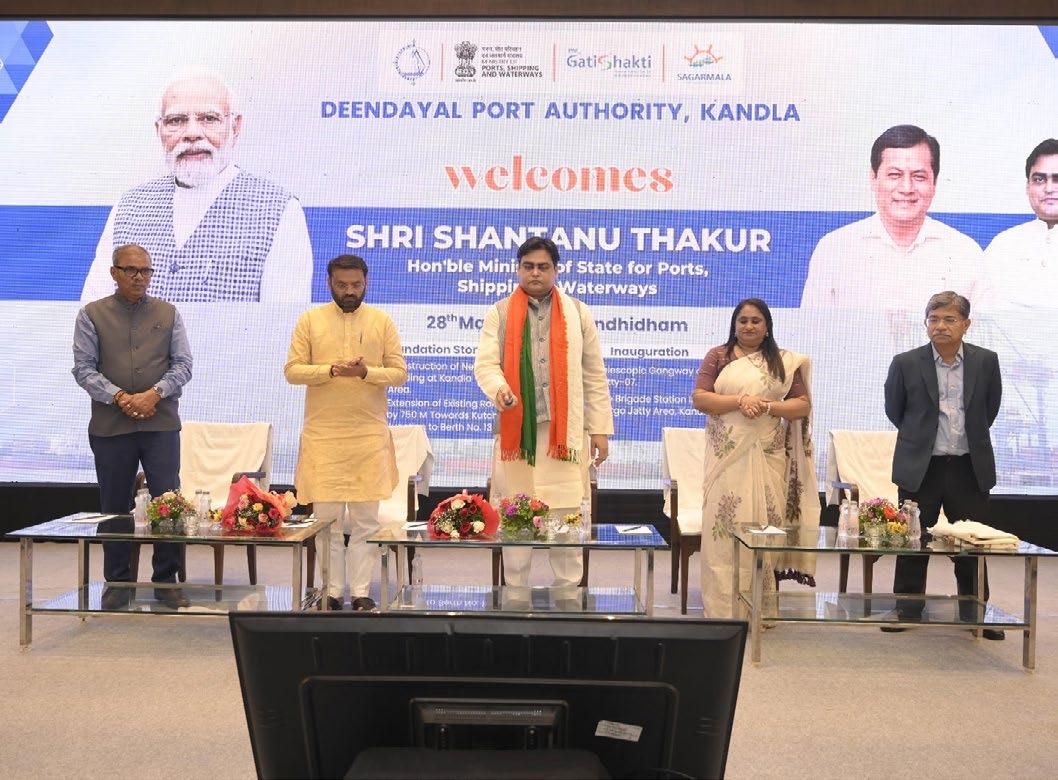
India’s Prime Minister Narendra Modi has virtually inaugurated key developmental projects at Deendayal Port Authority (DPA), Kandla, worth over ₹1,100 crores.
Recognised as one of the three major ports designated as a ‘Green Hydrogen Hub’ under the National Green Hydrogen Mission, DPA is aiming to become a beacon of clean energy adoption, infrastructure modernisation and regional economic growth.
Projects worth ₹532 crores include oil jetty No. 8 at Old Kandla. With a capacity of 3.5 million metric tonnes per annum, the newly inaugurated jetty is equipped with telescopic gangways, innovative quick-release mooring systems and an automated firefighting system, enabling safe handling of large liquid cargo vessels, plus connectivity to the container terminal at Tuna-Tekra.
It also includes expansion of the port area for EXIM cargo storage, supporting faster cargo evacuation and other development initiatives to strengthen port operations, enhance community infrastructure and generate employment opportunities.
Further projects include a 10MW green hydrogen production facility at Kandla, enabling clean energy and establishing DPA as an emerging leader in the green hydrogen sector. Development projects also include construction of three road-over bridges and an upgrade to six lanes at Kandla.
DPA reaffirms its commitment to building a green, efficient and globally competitive maritime ecosystem with these initiatives. Through the adoption of clean energy, cutting-edge cargo handling solutions and smart infrastructure, it aims to play a pivotal role in realising India’s aspirations of becoming a logistics powerhouse.
Multiple projects worth nearly ₹2,000 crore have been launched to expand capacity at Jawaharlal Nehru Port Authority (JNPA).
A solar-powered boat, two indigenously developed 70T tugs and three fire tenders have also been added to the port to boost its safety and efficiency.
JNPA, located east of Mumbai, handled its highest-ever container volume of 7.05 million TEUs in 2024, performing at more than 90% capacity. It had annual growth of 11% last year, compared with the previous calendar year. With the commissioning of the second phase of Bharat Mumbai Container Terminal in January 2025, another 2.4 million TEUs has been added to JNPA’s total capacity.
The upgrade of Nhava Sheva Freeport Terminal in 2025 will also add capacity to the port, with container handling capacity increasing to 10.4 million TEUs.
Launching the projects, Sarbananda Sonowal, Union Minister of Ports, Shipping and Waterways, says: “It is a remarkable feat for JNPA as well as for the whole of the marine sector of India. With growing infrastructure,
including creating capacity to handle larger vessels, JNPA is poised to play a crucial role as a key gateway for India’s global trade.
“As India’s trade volume increases, from sectors as diverse as manufacturing to textiles, from electronics to agriculture, our ports are investing in capacity building as well as creating efficient solutions to support growing container traffic.
“We believe that JNPA’s elevation as one of the few ports in the world to handle 10 million TEUs is a testament to the effort being put in by the government since 2014 towards enabling India’s marine sector to become one of the top marine countries of the world.”
Sonowal also launched the development of a state-of-theart agro processing facility at JNPA. “This pioneering initiative, with an investment of ₹284 crore, marks a significant milestone in bolstering India’s agricultural trade infrastructure. Spanning 27 acres within the port complex, this one-of-its-kind facility is set to transform the processing, storage, and transportation of agricultural commodities,” he says.
Designed to handle approximately 1.2 million tonnes of cargo annually, the facility will offer comprehensive services including processing, sorting, packing and laboratory facilities to ensure compliance with food safety and trade regulations.
Another memorandum of understanding (MoU) was signed to set up a warehousing facility in the port area to monetise vacant land parcels along with capacity development. An investment of ₹300 crore is being fixed for the development of these ambient and temperature-controlled warehousing and CFS facilities.
In addition, MoUs were signed for the development of Vadhavan Port, north of Mumbai. The MoU between Vadhvan Port Project (VPPL) and Reliance Industries allocates liquid jetty along with 50 acres of land. This investment is estimated at ₹645 crore, and is likely to commence by 2030.
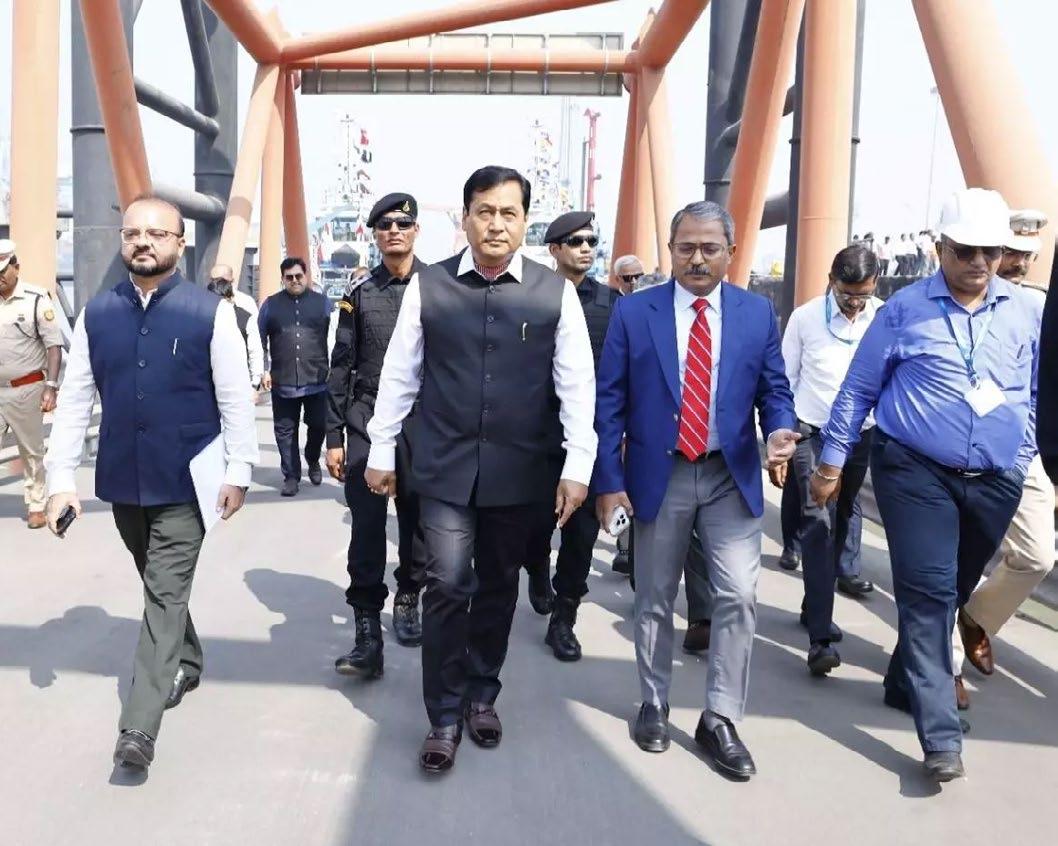

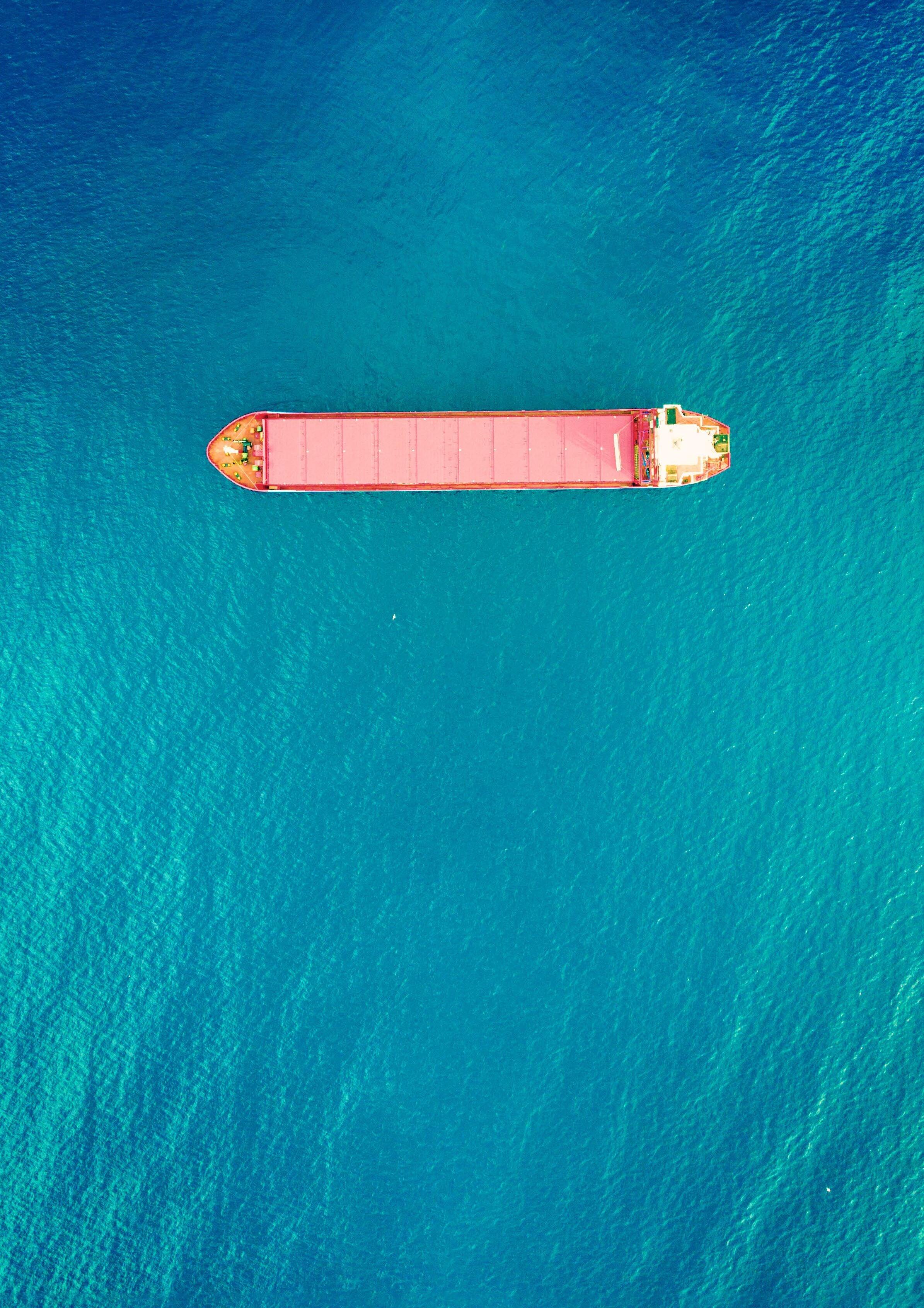
Scandinavian ports are investing in equipment and facilities to future proof their businesses
Anew logistics park rising beside the Port of Gothenburg, Sweden, is being purpose-built to support the coming wave of electric logistics infrastructure, powered by on-site renewable energy and advanced energy management.
Castellum and the Port of Gothenburg have joined forces to develop the 270,000-square-meter Halvorsäng Logistics Park, with the aim of building a strategic logistics hub that meets the increasing demands of electrification, climate accountability and long-term operational efficiency.
“We are building for electrification, guided by business value, climate goals and system efficiency,” says Henrik Fahlén, CEO of the jointly owned Halvorsäng Fastighets AB and Head of Business Development at Castellum.
Situated directly adjacent to Sweden’s largest port, Halvorsäng Logistics Park offers proximity to multimodal transport routes and maritime terminals. Once fully built, it will feature 145,000 square metres of leasable logistics space. The first phase – a 45,000-square-metre development – is already underway, with medical supply distributor OneMed confirmed as the first tenant, planning to occupy its space by 2026.
Halvorsäng has full integration of electrified logistics infrastructure from the outset. That includes high-capacity charging stations for heavy-duty vehicles, battery energy storage systems, and rooftop solar arrays. The park is designed to meet Environmental Building 4.0 Gold certification standards and aims to cut carbon emissions by 40%, compared with traditional facilities.
To bring the energy vision to life, Castellum has partnered with Buddy Energy, a Swedish energy tech firm specialising in integrated smart energy systems. Its solution connects solar generation, battery storage and load-balancing controls into one scalable system.
“For us, this is a textbook example of how a modern logistics park should be built,” says Per-Henrik Persson, CEO of Buddy Energy. “When energy production, storage, charging and control work together, we get properties that strengthen the grid and create value for both the property owner and the tenant.”
The system is designed to store surplus solar energy and release it during peak demand periods, reducing both grid dependency and energy costs. This level of smart energy design is still rare in industrial parks but is expected to become standard as demand for electrified logistics grows.
The Port of Gothenburg sees Halvorsäng as a critical piece of the puzzle in its wider sustainability and infrastructure strategy.
“Halvorsäng is a key investment for the Port of Gothenburg and part of our mission to make it easier for all stakeholders in the logistics chain to make sustainable choices,” says Jill Söderwall, Vice President Business Areas at the Port of Gothenburg.
“Together with Castellum and Buddy Energy, we are creating a logistics area for the future, with the infrastructure needed to support increased electrification.”
This aligns with broader trends across European ports, where electrified transport corridors and renewable power sources are becoming more common as regulatory pressure and sustainability goals tighten.
OneMed, which provides healthcare supplies to hospitals and clinics across the Nordic region, will anchor the development with its new Nordic logistics centre.
For us, this is a textbook example of how a modern logistics park should be built
“We are developing an area that not only meets today’s logistics demands, but is equipped to handle future requirements for electrification, climate responsibility, and supply security,” says Fahlén. “Halvorsäng is a strategic investment where we combine infrastructure, sustainability, and long-term business value.”
“We see sustainable logistics as an integral part of our business,” says Mikael Eisner, Transport and Distribution Manager at OneMed. “At Halvorsäng, we gain a facility that enhances both our climate profile and our delivery capacity. This aligns perfectly with our goal to make a difference for both our environment and our customers.”
As construction progresses, Halvorsäng Logistics Park is set to become a practical model for other ports and developers aiming to future-proof logistics infrastructure against growing energy demands, climate expectations, and electrification needs.
Alimak has installed a rack and pinion elevator on a portal slewing crane at heat and power plant KVV8’s new fuel terminal in Värta port, Stockholm, Sweden. This is the first time an elevator has been installed on this type of harbour crane.
To be able to tie in the elevator mast tower into this kind of crane structure, the mast tower has been extended up to 25.6m, while the elevator only reaches up to a height of 16.85m, where the crane operator cabin is located. The elevator mast is only tied with one tie-in at the top.
The crane serves the new power plant by unloading fuel delivered from vessels. These type of cranes are space-saving and efficient and adapt well to the conditions of the new fuel port. The Alimak SE 300 elevator gets the crane driver to the portal slewing crane’s driver cabin in less than half a minute, improving efficiency and productivity further. Safety is also improved as hazards, such as slipping on the stairs or objects falling from height, are greatly reduced.
With vessel turnaround schedules measured in hours, it is imperative to maximise crane uptime. Alimak rack and pinion elevators provide reliable and efficient access to the top of the crane for operators, tools and repair parts, facilitating frequent preventive maintenance and minimising costly downtime resulting from breakdowns.
By allowing operators to access the crane’s cabin more quickly, an elevator also substantially increases the crane’s overall productivity per shift.
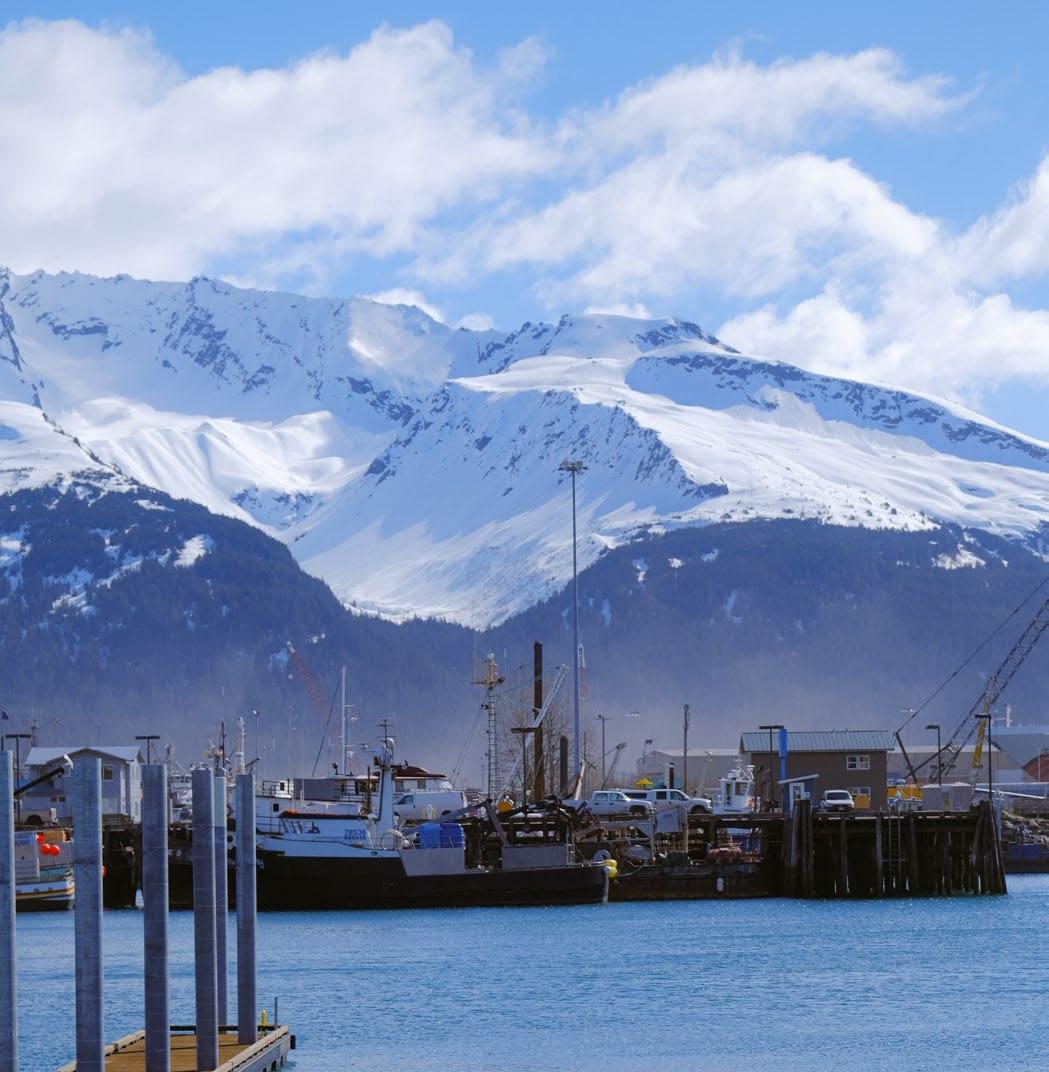
Copenhagen Malmö Port (CMP) has reported a strong start to the year at its container terminal in Copenhagen. During the first five months of 2025, the terminal handled a total of more than 49,100 TEU, representing an increase of 12,100 TEU or 32.7% compared to the same period in 2024.
As the primary container terminal serving Eastern Denmark, CMP plays a critical role in supporting the logistics infrastructure of the capital region and surrounding areas.
To accommodate continued growth and enhance service capabilities, CMP is preparing to open a new container terminal later this year. This will further strengthen CMP’s ability to meet the evolving logistics needs of the Øresund region.
“This growth of more than 30 % is a clear signal that our customers value the reliability and sustainability of
our operations,” says Povl Dolleris Røjkjær Ungar, Chief Commercial Officer at CMP. “We are proud to support the region’s logistics needs and look forward to continuing this positive momentum.”
CMP remains committed to delivering reliable, efficient and sustainable logistics solutions. The current terminal is already operating without fossil fuels and CMP is aiming to become net-zero CO₂ emissions in its own operations (Scope 1 and 2) by the end of 2025.
SCA Logistics terminal in Sundsvall, Sweden, has invested in a new knuckle boom crane, a Mantsinen 200.
The investment in the crane brings several advantages, including an increase in capacity and improved flexibility.
“We already have a crane of the same model and now that we have two, we can load larger ships more efficiently,” says Tommy Berglund, Head of Operations at the terminal. “The time ships spend at the quay for loading or unloading will be significantly shorter when we can use two large cranes simultaneously. We also have the opportunity to receive two larger ships at the same time and use one crane for each. Previously, the second ship had to wait for the first to be serviced.”
The new crane also improves safety and the working environment. It has a safety system that ensures there is no risk of tools, such as a beam, colliding with the cabin. Additionally, the crane warns of heavy loads, allowing the crane operator to work efficiently and safely. There are also new features that allow settings for different tools to be managed via a computer in the operator’s cabin.
“Different tools require different pressures on the hydraulic oil and on older cranes, manual adjustments of the reduction valves on the unit are needed. Now, this can be managed with a few keystrokes on the computer. The working environment in the cabin is also generally better,” says Jonny Strömståhl, Department Manager for Storage and Planning.
“In addition, now we can have one crane in service and still load and unload larger ships, this means it will be easier to keep the service schedule, which is important for the equipment to last as long as possible.”
The crane can lift six units of pulp bales – 12 tons – in one lift. The unit itself weighs about four tons.
“It is a new type of pulp unit that is more free-hanging, and we therefore expect it to handle bumps well,” says Strömståhl.
In recent years, SCA has invested nearly 460m SEK at the Sundsvall terminal. The investment includes a new container port and new areas for cargo handling.
“The new crane is yet another step to increase our productivity and service level. We are well prepared to handle the increased cargo volumes in our region,” concludes Strömståhl.
The new crane was delivered by ship from Rauma in Finland. It reached land after half a day´s journey across the Gulf of Botnia.
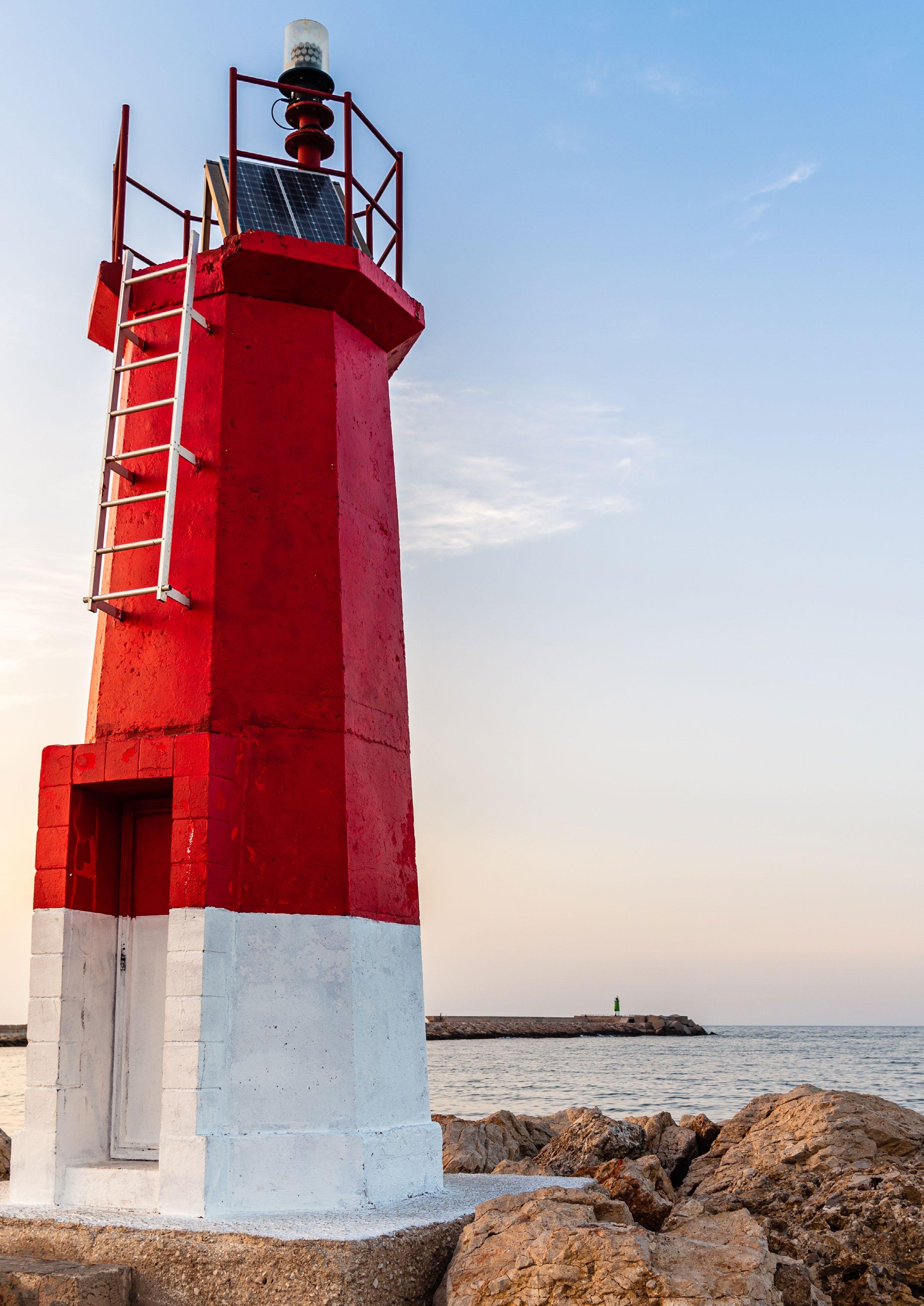
South Africa’s ports are seeing a healthy boost to throughput by increasing capacity and improving operational readiness
In its latest Cargo Movement Update, South Africa, the Southern African Association of Freight Forwarders (SAAFF) found that South Africa’s ports handled more than 97,000 TEUs in the week of 22 June and 87,000 in the week of 29 June 29, exceeding targets by 13% and 2%, respectively.
The update, produced in collaboration with Business Unity, also finds daily TEU throughput increased significantly, with an average 16,359 TEUs having been handled a day on 28 June and 29 June.
The SAAFF commended Transnet for having made substantial improvements to its volume throughput throughout South Africa’s key container terminals in recent weeks. Its research suggests there has been an increase in capacity and operational readiness, which reflects steady progress having been made on Transnet’s part.
SAAFF Research and Development Head Dr Jacob van Rensburg says further encouragement comes from the fact that the load was shared across the board, including the smaller and multi-purpose terminals, not just terminals dedicated to containerised cargo.
SAAFF CEO Dr Juanita Maree says: “We are seeing meaningful progress and renewed operational capacity from Transnet. The hard work by all involved from Transnet Port Terminals to logistics partners, combined with the deployment of new equipment, improved cargo evacuation processes and ongoing terminal refurbishments, is clearly traction under this crosscollaborative approach.”
The improved logistics throughput coincides with broader positive economic signals. The South African Reserve Bank’s latest Quarterly Bulletin cites R11.7bn in FDI inflows – up from R7.5bn the previous quarter. Significantly, SARS’ May 2025 trade statistics reveal a preliminary trade surplus of R21.7bn.
SAAFF believes these trends are linked. “Continued focus on performance improvement within the national logistics network will go a long way in boosting global investor confidence in South Africa’s markets,” adds Dr Maree.
Transnet Port Terminals’ (TPT) container division has recorded a 21% year-on-year increase in citrus exports in April, compared with the same month in 2024.
Vessels with the capacity to carry 7,800 containers will call at Durban Container Terminals, Port Elizabeth and the Ngqura Container Terminal until October to load exports of oranges, mandarins, lemons, clementines, grapefruit and limes destined for more than 100 markets.
TPT says the container terminals had taken steps to ensure readiness for the season. These include recruiting 256 additional workers on fixed-term contracts, conducting maintenance on all reefer plug points and adding 100 pieces of new equipment.
“Our operations have stabilised and are now focused on growing the business, meeting customer expectations and making South Africa win,” says TPT General Manager for Commercial and Planning, Michelle van Buuren Schele.
The Citrus Growers’ Association has forecast a 3.6% increase in citrus volumes for the 2025 season amid the threat of possible tariff hikes for the US market.
Components for the first two of four ship-to-shore cranes have been delivered to the Durban Container Terminal (DCT) Pier 2 – the most expensive pieces of equipment in the terminal’s operations.
Valued at ZAR242m each (US$13.4m), the new STS cranes from Liebherr will replace the cranes that have been in use at the terminal for more than 20 years.
The first of the STS cranes is expected to be operational in October 2025, with the remaining STS cranes in service by November 2025.
Terminal operator Transnet says each crane has a 65 ton twin-lift capacity, with a seaside rail outreach of 65 metres to the centre of the spreader and a lifting height above the quayside of 43 metres.
The new STS cranes have been engineered with an offset land-side bogie, allowing for adaptability from the current 28.5m rail gauge to a 30.48m, facilitating possible relocation to other berths at the site.
“The South quay has been under immense pressure due to the limitations of our aging crane fleet,” Durban Terminals Managing Executive Earle Peters explains. “The arrival of these Liebherr cranes marks a major step forward in restoring reliability, boosting productivity, and ensuring we meet the evolving demands of global trade.”
The acquisition of the cranes is part of a fleet renewal process underway at DCT Pier 2, where the aging fleet is being replaced with state-of-the-art equipment.
DCT Pier 2 recently took delivery of 20 straddle carriers, 40 haulers, 22 forklifts, 26 trailers and two reachstackers, of which some have been handed over to support ongoing operations and improve cargo handling capacity.
In the past 18 months, a total investment of approximately ZAR1.5bn (US$83m) has been spent in equipment replacements at the country’s biggest and largest container facility.
Transnet National Ports Authority (TNPA) has appointed Grindrod South Africa as the preferred bidder to develop and operate a container handling facility at the Port of Richards Bay in KwaZulu-Natal, scheduled to become operational in 2027.
The appointment is in line with TNPA’s strategy to increase the yearly container handling capacity at the port – known as South Africa’s main coal export terminal – from 50,000 TEUs to 200,000.
The project will involve capital investment of about R285m – which TNPA acting CEO Phyllis Difeto says will significantly enhance the port’s infrastructure – and the proposed container handling facility will serve the northern parts of KwaZuluNatal province.
Grindrod South Africa will partner with local firm Eyamakhosi Resources on the project.
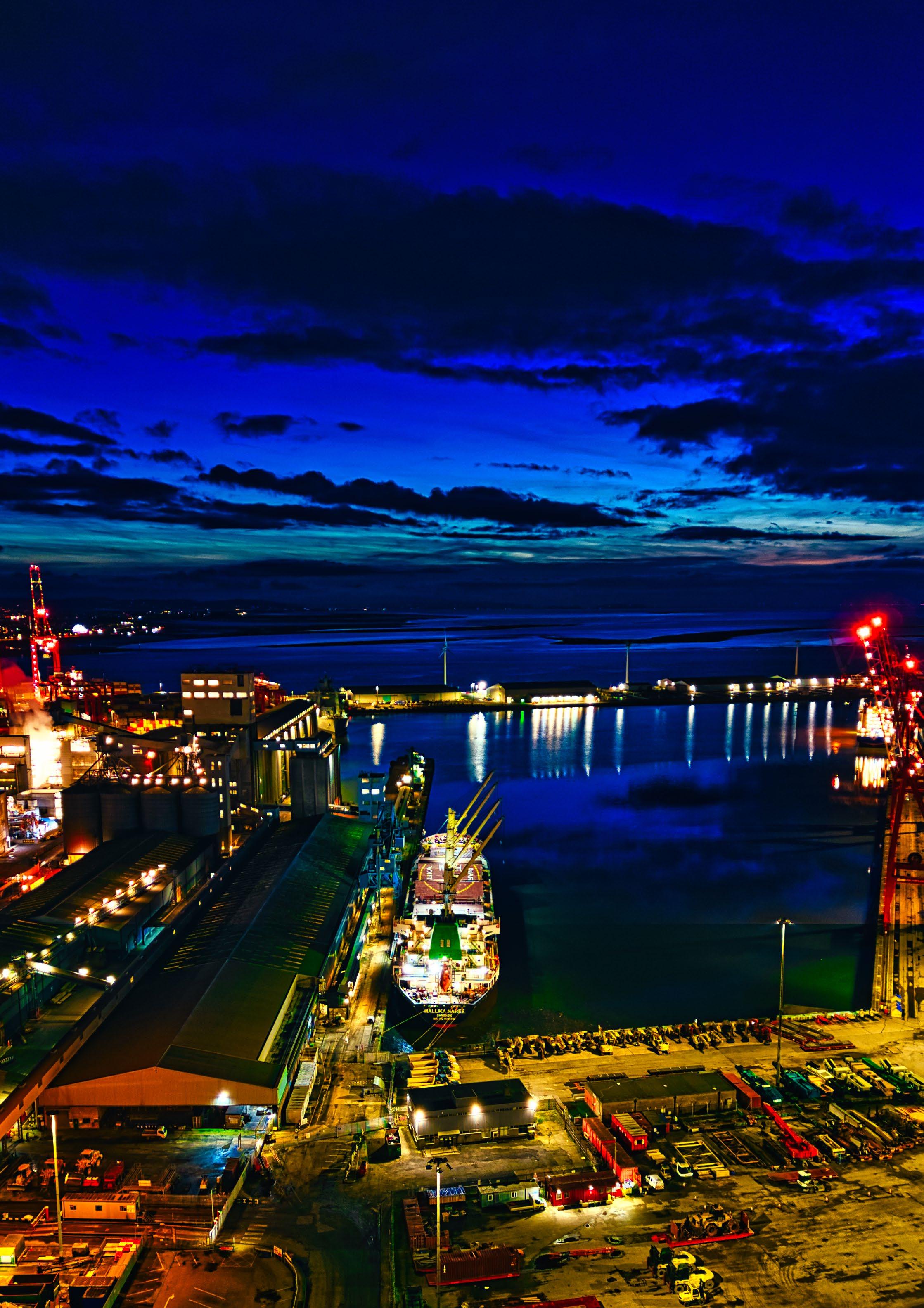
US West Coast ports saw a slowdown in May, with some of the largest experiencing their first year-over-year decrease in months
The Port of Los Angeles processed 716,619 TEUs during May, a 5% decrease from the 752,893 TEUs reported during the same time in 2024. This follows 10 consecutive months of year-on-year growth.
The port says the month’s decline was driven by the impact of tariffs on both imports and exports. Despite the drop, for the first five months of the year, container traffic rose 4% year on year to 4,063,472 TEUs as ship operators rushed products to the US ahead of tariffs taking effect.
“May marked our lowest monthly cargo output in over two years,” Port of Los Angeles Executive Director Gene Seroka says. “Unless long-term, comprehensive trade agreements are reached soon, we’ll likely see higher prices and less selection during the year-end holiday season.”
The Port of Long Beach also reported its first year-on-year decline in months, as volume fell 8.2% to 639,160 units from 695,937, a drop that the port also blamed on tariffs.
However, Port of Long Beach CEO Mario Cordero suggests that recent temporary pauses on tariffs with certain countries could trigger another cargo surge. The facility’s container volumes for the first five months increased 17.2% to 4,042,228.
been arriving at the Port of Los Angeles and Long Beach – an increased flow of shipping containers aiming to beat potential tariff increases.
The vessel tracking service managed by the Marine Exchange of Southern California and Coast Guard (MX SoCal) has shown an uptick in ship arrivals. Captain J Kipling Louttit, Executive Director of MX SoCal says it is the highest number of container ships on the way to the nation’s busiest ports since January 2025 (previous highs were in July and September 2024).
The increase in containers was expected, though, and officials have stopped short of describing it as a “surge”. There is no expectation of sustained high levels – ocean freight booking orders fell after a couple of weeks of increased orders.
There is no expectation of congestion at the West Coast ports, either, due to recent softness in container traffic. The trade war has led many US importers to place a pause on orders, and vessels arriving into the Ports of Los Angeles and Long Beach before the new wave have not been full.
The Port of San Diego has won the Green Port Award at the 2025 Green World Awards presented at the Breakbulk Europe Conference in May.
Unless long-term, comprehensive trade agreements are reached soon, we’ll likely see higher prices
“We remain cautiously optimistic that import cargo will rebound at the end of June and into July just in time for the peak shipping season,” he says. “While uncertainty remains for the business sector, the Port of Long Beach is continuing to invest in rail and terminal improvements to move cargo efficiently, safely and sustainably.”
The Port of Oakland posted a 0.3% decrease for May to 187,389 containers from 188,036, but saw a slight increase from the 185,499 containers reported in April. Total container volume for the first five months of the year increased 6% to 974,417.
Meanwhile, the Northwest Seaport Alliance says that combined volumes between the ports of Seattle and Tacoma, Washington decreased 9.4% to 250,851 units from 276,854. The results also marked the end of 14 consecutive months of sequential growth for full international imports.
Meanwhile, a new wave of ocean freight from China has
This international recognition celebrates the Port’s leadership in sustainable maritime operations through the implementation of the Port’s Maritime Clean Air Strategy (MCAS), advancing zero-emission (ZE) technologies and helping improve community air quality. To date, the port and its partners have committed more than $227m toward ZE initiatives.
“The Port is honoured to be recognised globally among industry peers as environmental champions and pioneers in maritime sustainability,” says Chair Danielle Moore, Port of San Diego Board of Port Commissioners. “This award celebrates the collaborative effort of port staff, along with our government, industry and community partners, in driving progress toward reaching our sustainability goals and helping protect San Diego Bay for future generations.”
The award highlights the Port’s green achievements and innovation including:
» Deployment of North America’s first all-electric mobile harbour cranes.
» A 700KW solar-powered microgrid with 2,700KW-hour battery storage at the Tenth Avenue Marine Terminal.
» Crowley Marine’s deployment of the first all-electric tugboat in the US, which services San Diego Bay and supports Port of San Diego operations.
» Expanded shore power for cruise and cargo vessels.
» Renewable diesel fuelling across all three fuelling docks in San Diego Bay.
» Community-driven investment, with 4% of maritime revenue reinvested in local air-quality projects. These projects are supported by multiple port staff and teams, including Maritime and Operations, Sustainability and
Innovation, and Government and Public Relations. The port also collaborates with tenants and service providers such as Dole Fresh Fruit Company, SSA Marine, Terminalift and The Pasha Group to advance these initiatives and support the electrification of cargo handling equipment.
The Breakbulk Green World Awards programme celebrates the people and projects across the project cargo and breakbulk industry contributing to a sustainable future. Specifically, the Green Port Award recognises ports and terminals implementing sustainable approaches to operations and advancing environmental responsibility within the maritime and logistics sectors. The awards were judged independently by an industry-wide esteemed panel of experts.
The Port of Los Angeles has signed a Memorandum of Agreement with the City of Shafter, California, and The Wonderful Company to promote more efficient two-way trade connections with California’s Central Valley. The aim is to bring more US exports through the port and its terminals.
Central to the agreement is the Wonderful Logistics Center, a 3,400-acre, master-planned industrial development owned by The Wonderful Company. Located strategically along the BNSF rail mainline in Shafter – a fast-growing economic area near Bakersfield – the logistics hub and container depot already serves multiple Fortune 100 companies, including Ross, Amazon, Target and Walmart, among others, and is uniquely positioned to support exports from the San Joaquin Valley and beyond.
“Both The Wonderful Company and the City of Shafter have a well-planned vision for creating jobs and promoting economic growth in the Central Valley, and the Port of Los Angeles stands ready to help,” says Port of Los Angeles Executive Director Gene Seroka. “This agreement represents
our commitment to support faster and more efficient service to and from the Central Valley right to our terminals and to markets across the world.”
“Our partnership with the Port of Los Angeles marks a significant evolution in the supply chain, enhancing cargo velocity and enabling California’s farmers to become more competitive and agile in the global marketplace,” says Wonderful’s Vice President of Logistics Sepehr Matinifar.
Specifics of the agreement include a pledge to promote sustainable and efficient two-way domestic and international trade connections between the Wonderful Logistics Center and the Port; conduct exporter outreach in the Central Valley; strategise on ways to develop mutually beneficial business opportunities; collaborate and educate supplychain stakeholders on the partnership benefits to the state and national economy; and share best practices on goods movement workforce training and development.
The Wonderful Company will also be adding a new international rail terminal at the Center, scheduled for completion in 2026. Serving importers and exporters with a dedicated shuttle train running between the San Pedro Bay port complex and Shafter, the rail terminal will increase efficiency and capacity and deliver significant environmental benefits by reducing truck traffic and streamlining container movement. Nearby housing, job training and other community amenities are also planned to support the Center’s expansion.
Signing of the agreement supports recent efforts by the Port of Los Angeles to better leverage the surplus of empty containers at its terminals and more efficiently position those for agricultural exporters.
The Wonderful Company is one of the largest agriculture, real estate, and consumer packaged goods companies in the US, and one of the largest owners and operators of farming and business properties in the Central Valley.
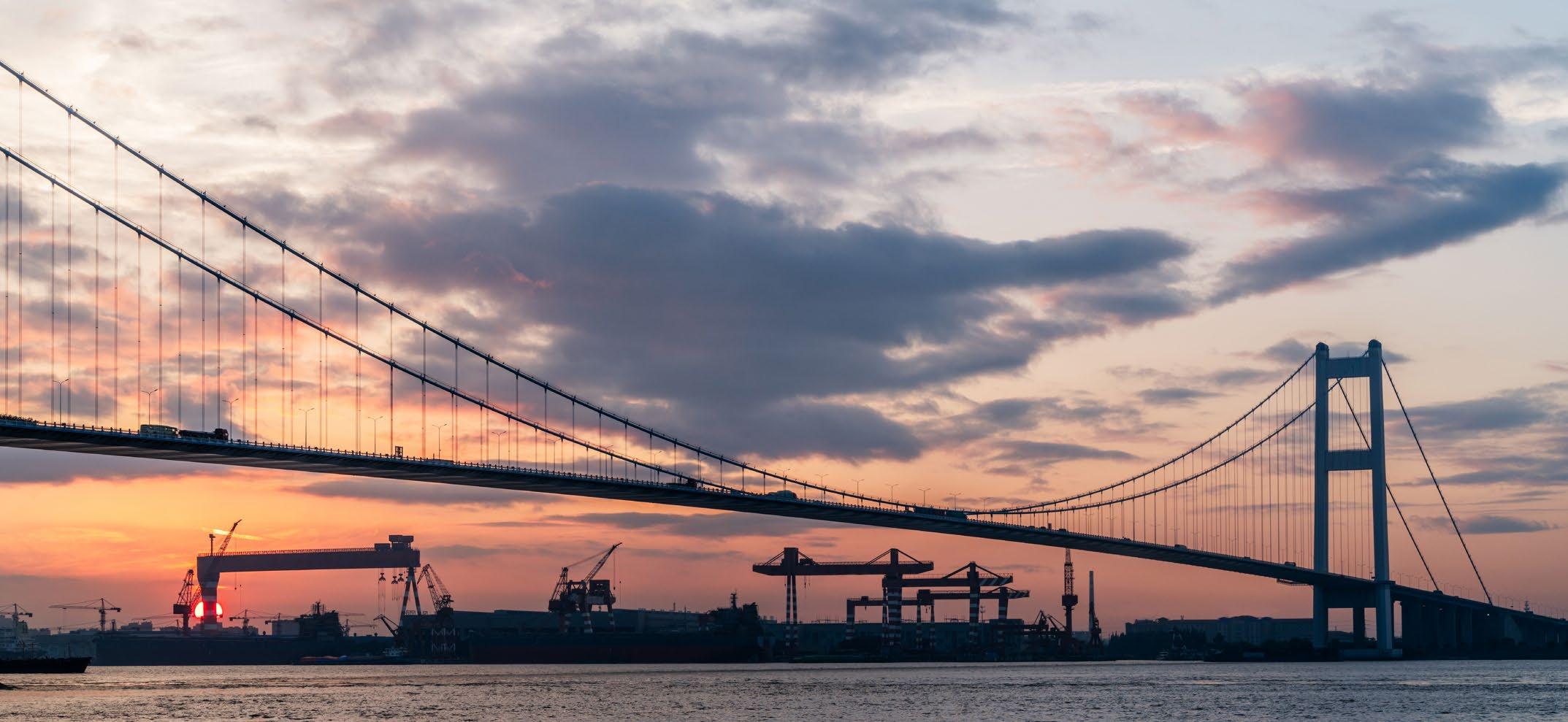

Digitalisation in Shipping:
Europe Summit
10-11 SEPTEMBER
Rotterdam globalmaritimehub.com
Argus Sustainable Marine Fuels Conference
10-12 SEPTEMBER 2025
Houston globalmaritimehub.com
INMEX SMM India 2025
10-12 SEPTEMBER 2025
Mumbai shipuniverse.com
London International
Shipping week
15-19 SEPTEMBER 2025
London lisw.com
BULKEX 24
14-15 OCTOBER 2024
Kenilworth mhea.co.uk
Breakbulk Americas
15-17 OCTOBER 2025
Houston americas.breakbulk.com
Bulk Terminals 2025
29-30 OCTOBER 2025
Marseilles bulkterminals.org
Europort 2025
4-7 NOVEMBER 2025
Rotterdam Ahoy, Rotterdam europort.nl
5th Annual Capital Link German Maritime Forum
5 NOVEMBER 2025 Hamburg forums.capitallink.com
15th Cement Expo
12-13 NOVEMBER Delhi cementexpo.in/expo
Ship Energy Efficiency Summit
26-27 NOVEMBER 2025
Athens, Greece ship-propulsion.com
CMA Shipping
10-12 MARCH 2026
Stamford Connecticut cmashippingevent.com
Asia Pacific Maritime
25-27 MARCH 2026
Singapore apmaritime.com
Shipping Days
8-9 APRIL 2026
La Rochelle shippingdays.com


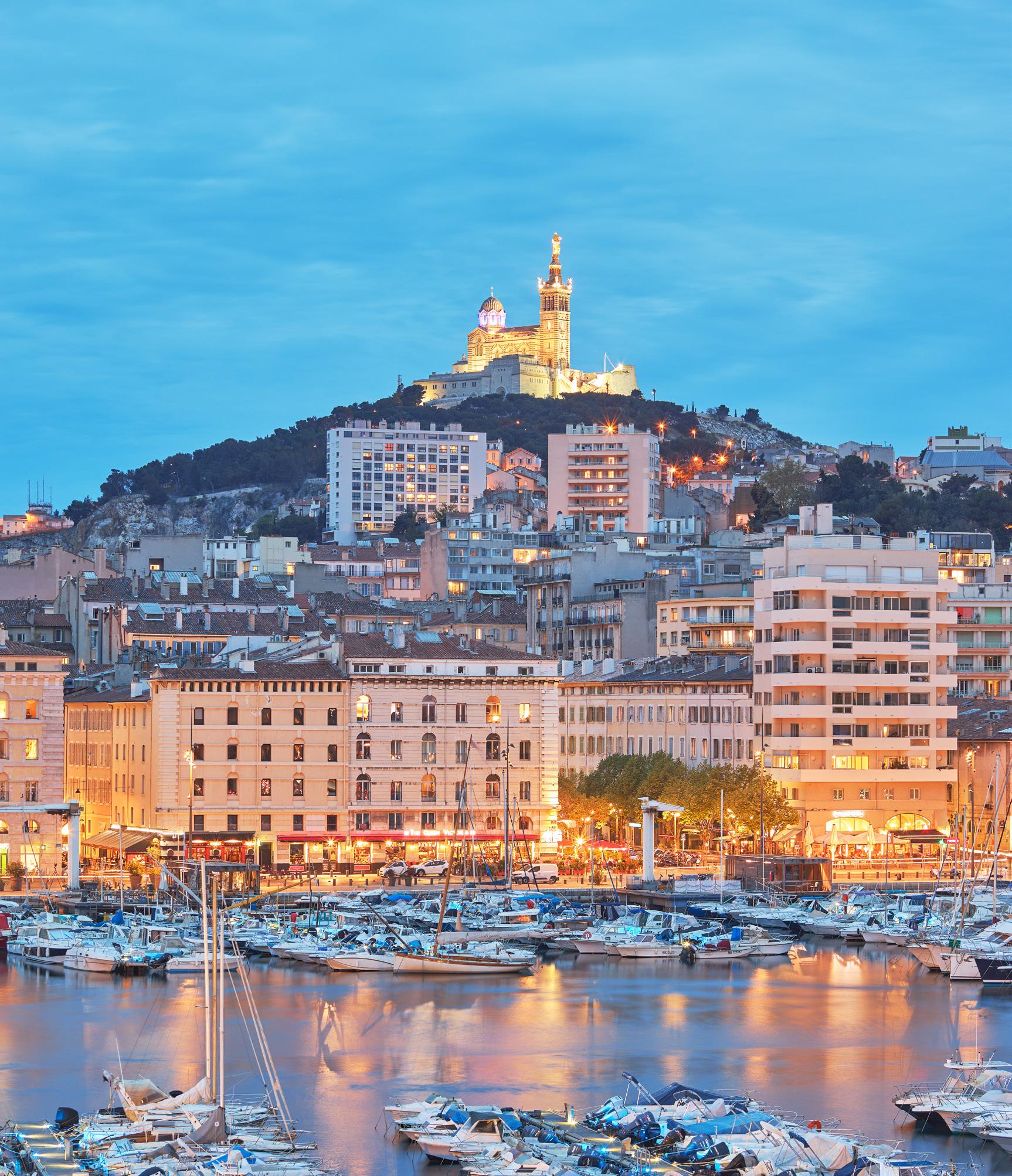










The 2025 conference will set the scene with the traditional analysis of bulk markets, continuing with a full programme focused on the concerns of operators – offering sound practical solutions to terminal operators for improving profitability, streamlining operations, improving safety, online security and ensuring environmental compliance & protection.
The fluid situation surrounding the imposition of the tariffs imposed by President Trump – at whatever level they settle at – added to worldwide geopolitical tensions will have a serious impact on bulk trade flows, both in terms of total volumes and trade routes. In addition to the obvious economic repercussions, bulk terminals will be presented with operational challenges and the need to make strategic adaptations.
Marseille will examine the impact these latest challenges place on bulk terminal operations – both in the short and long term.
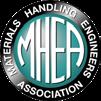






www.liebherr.com